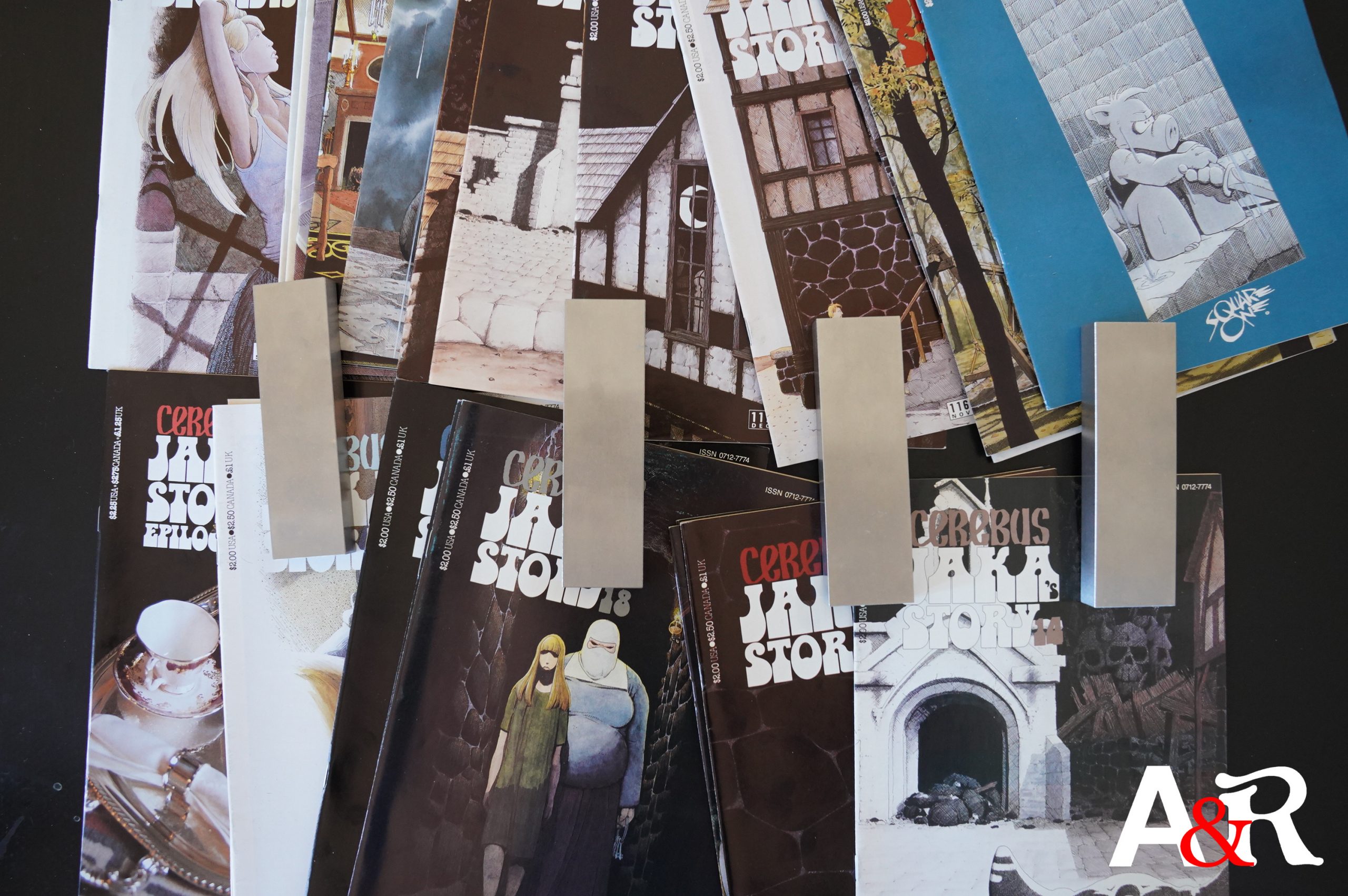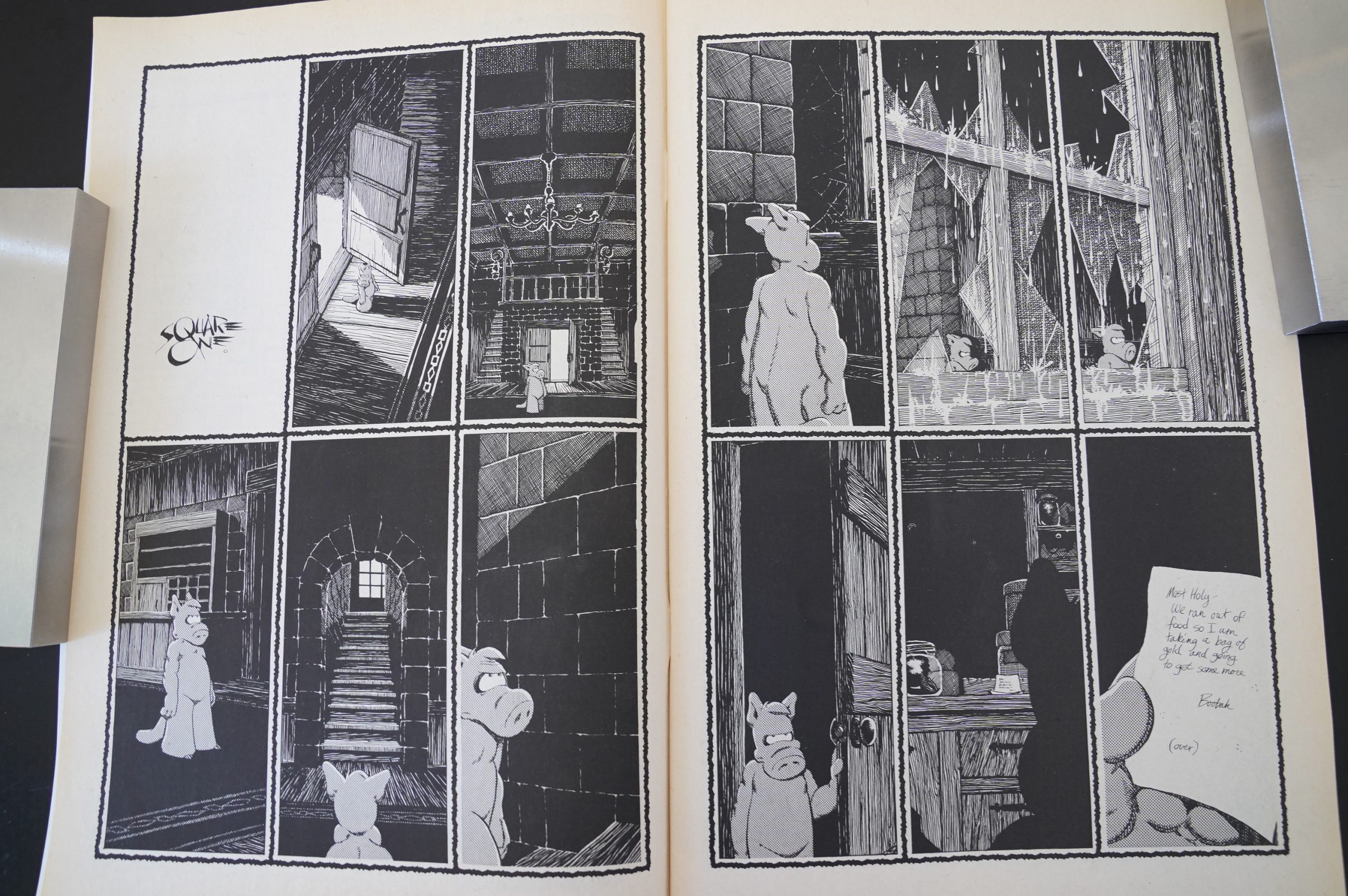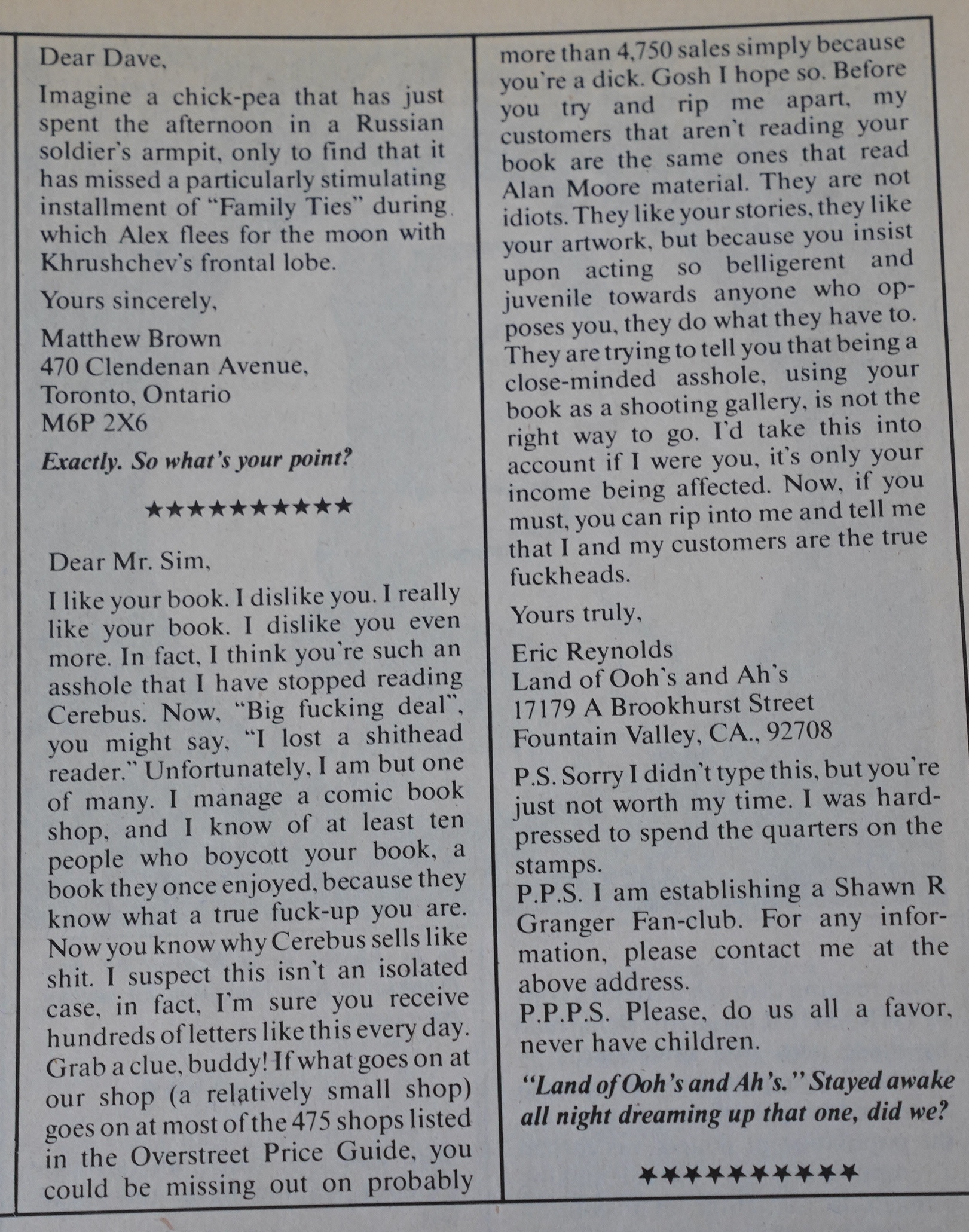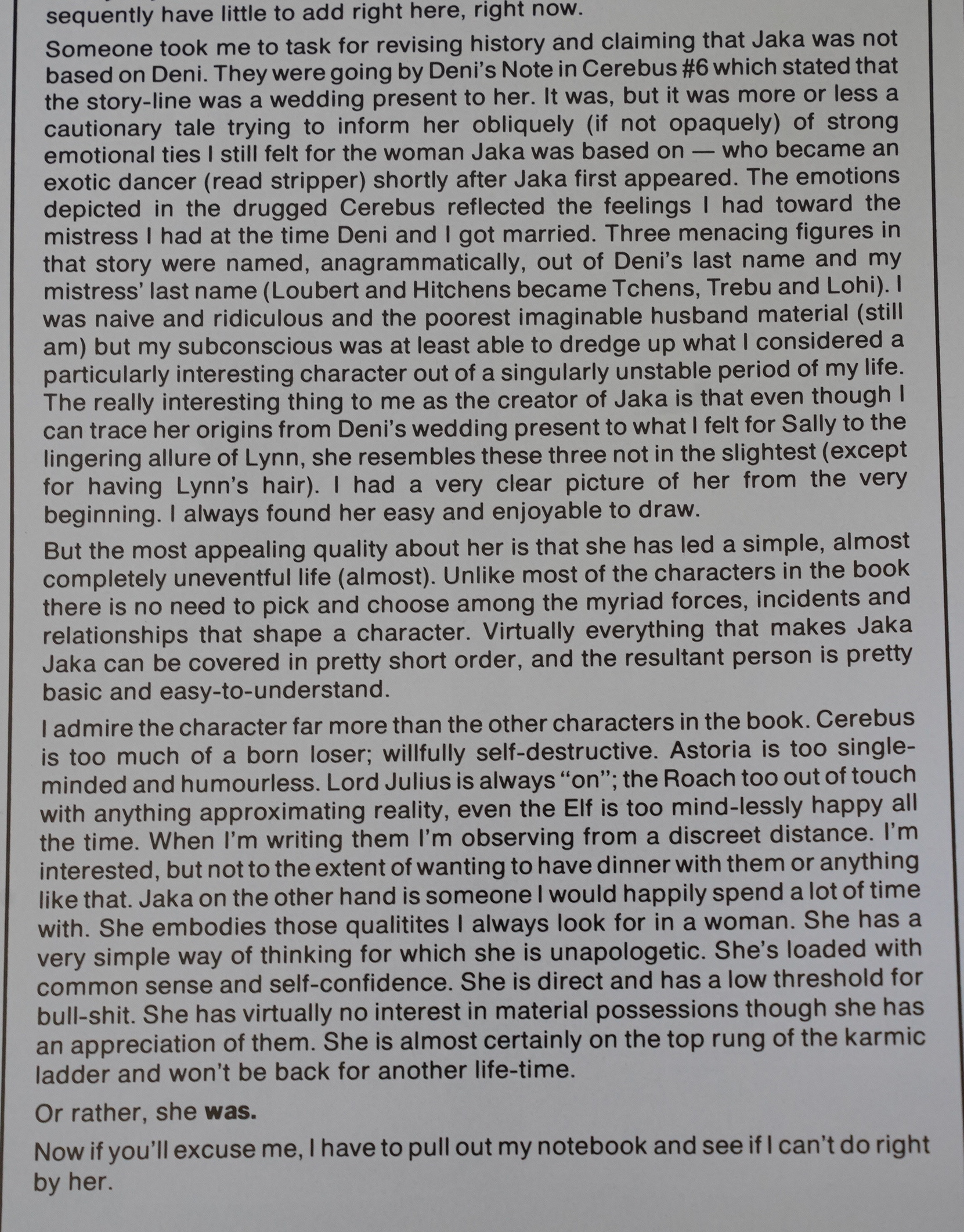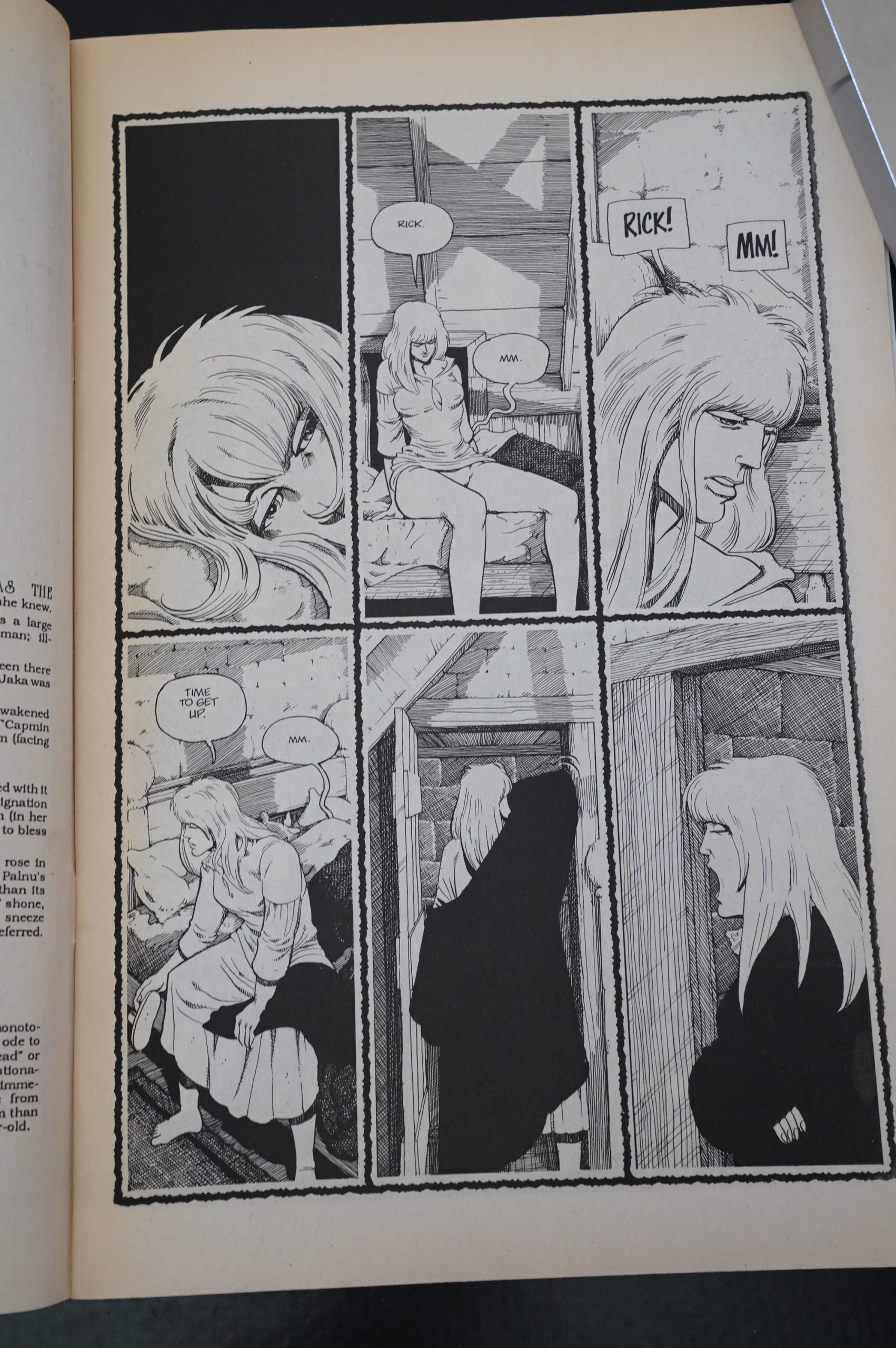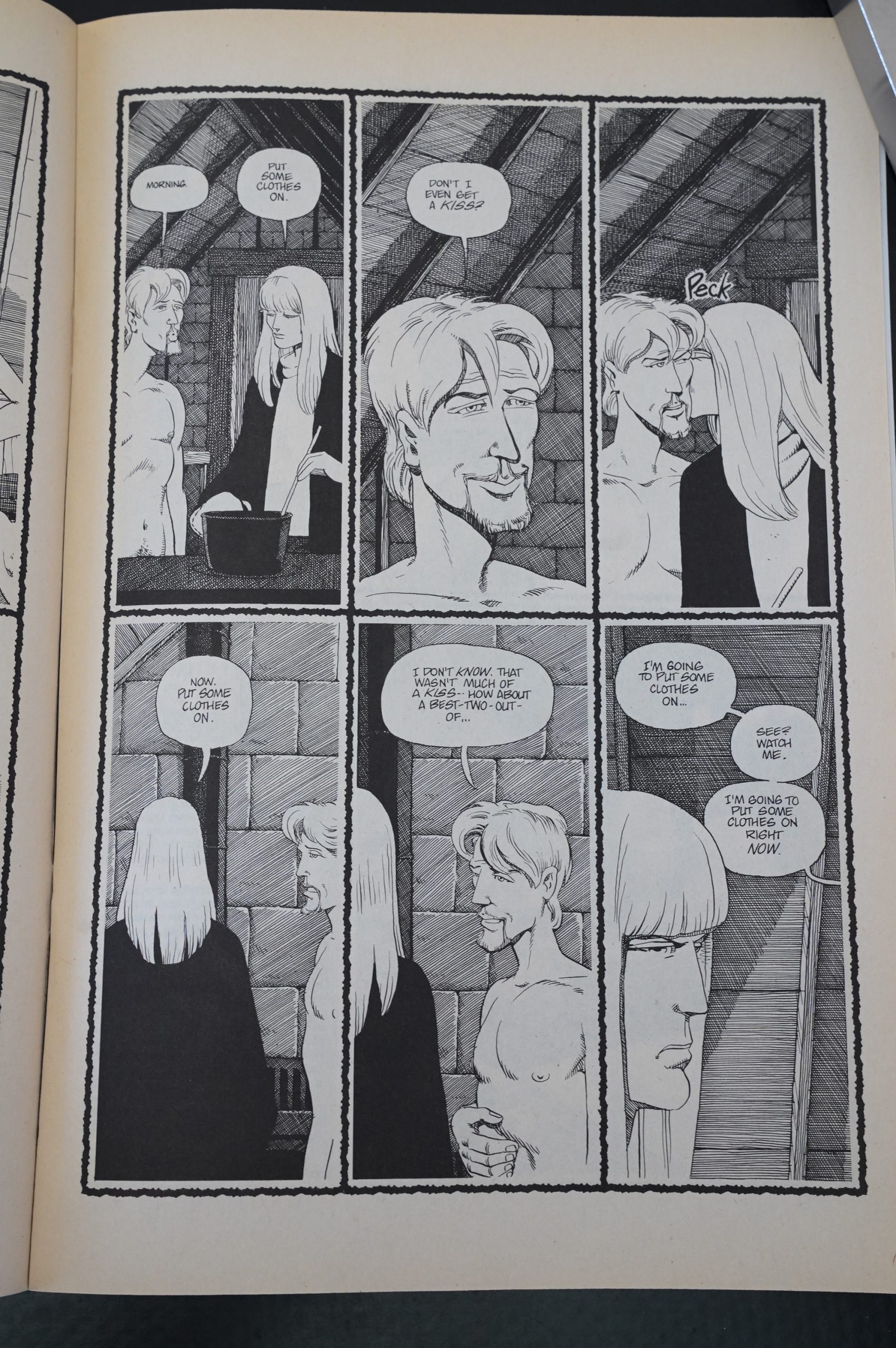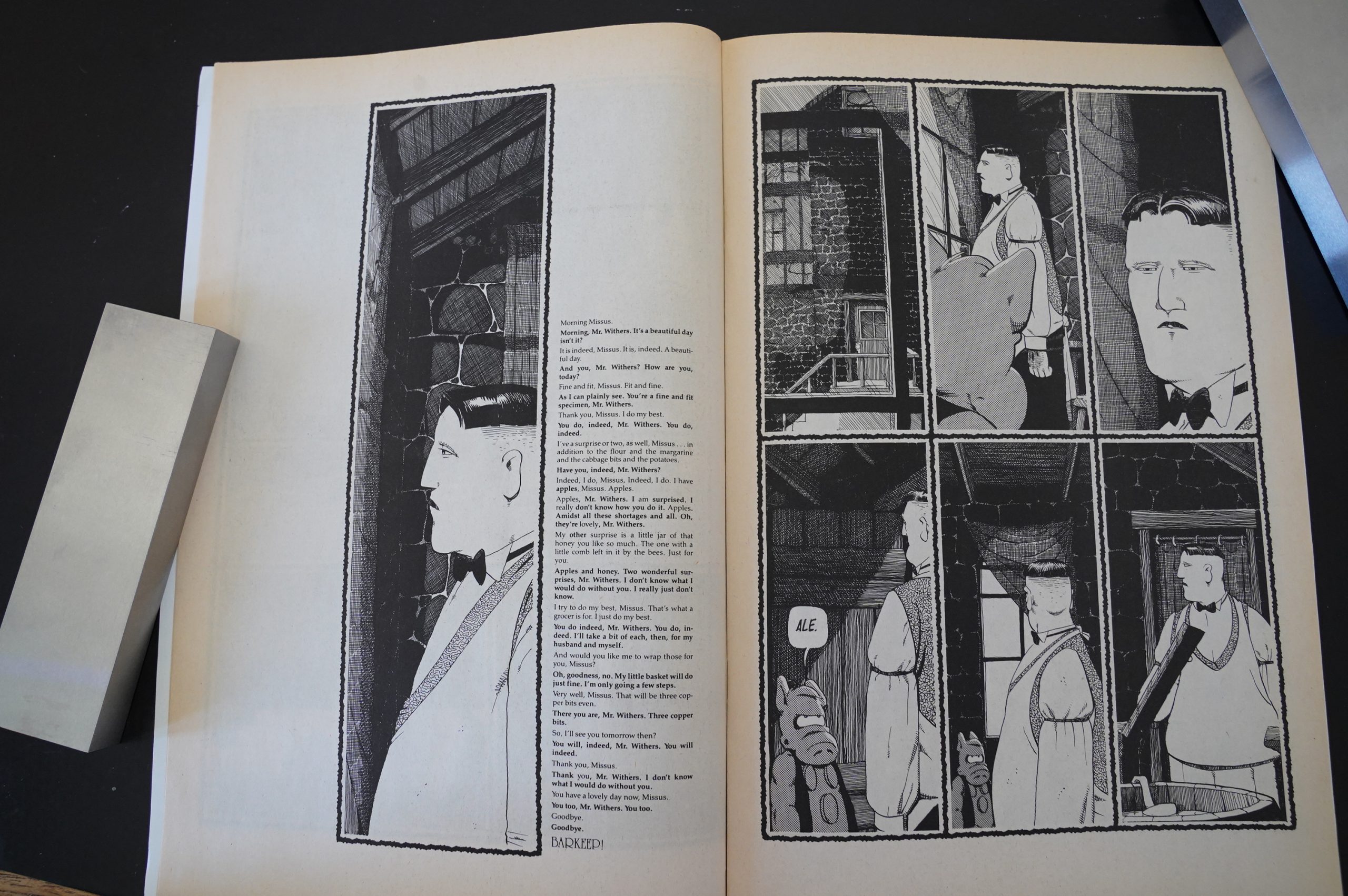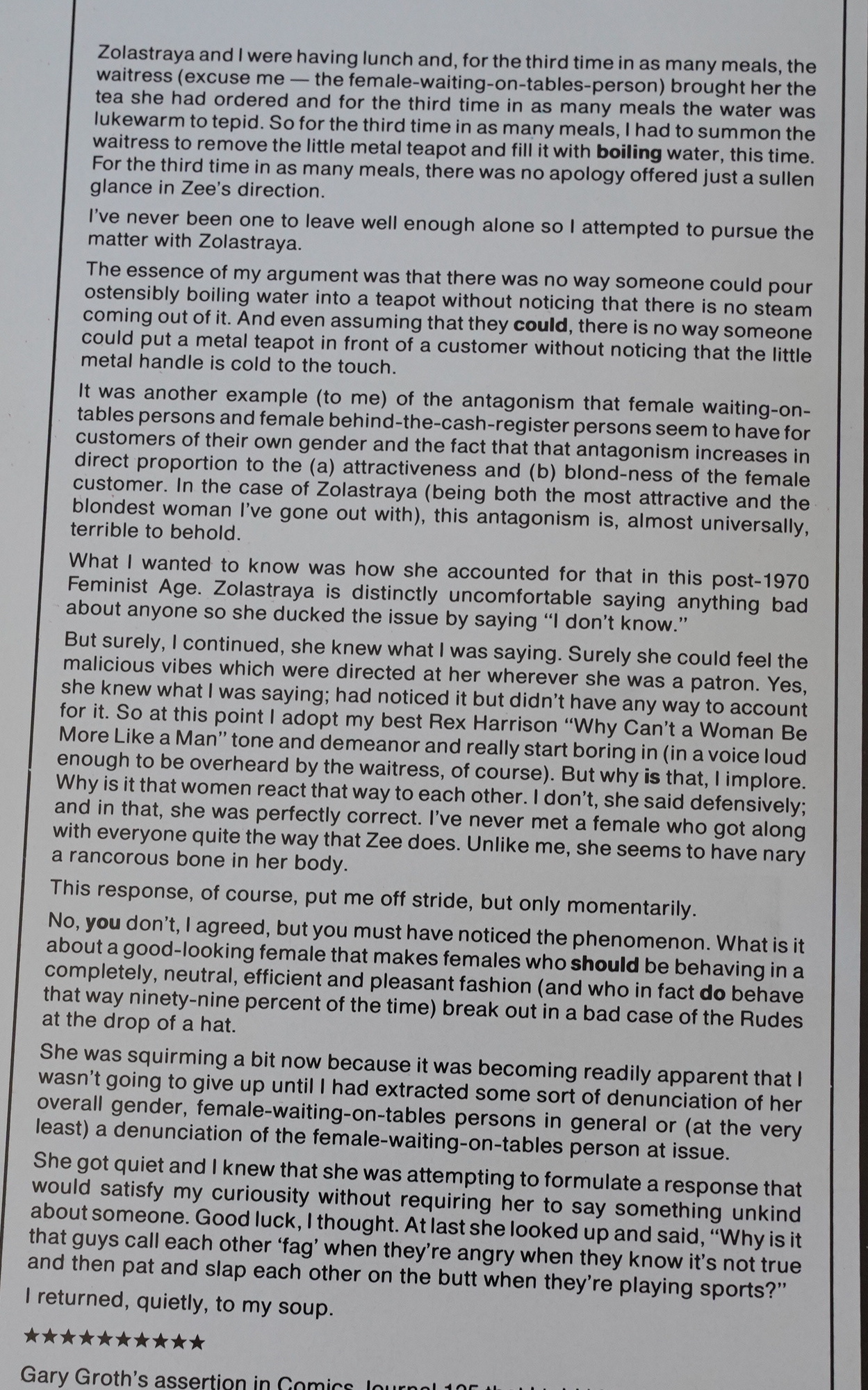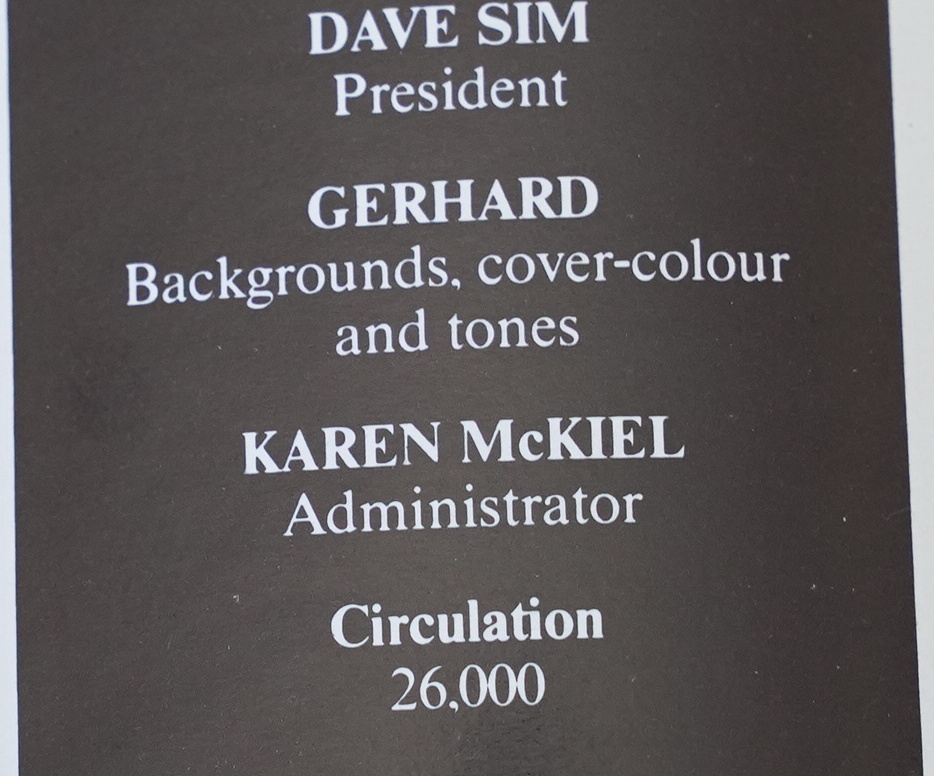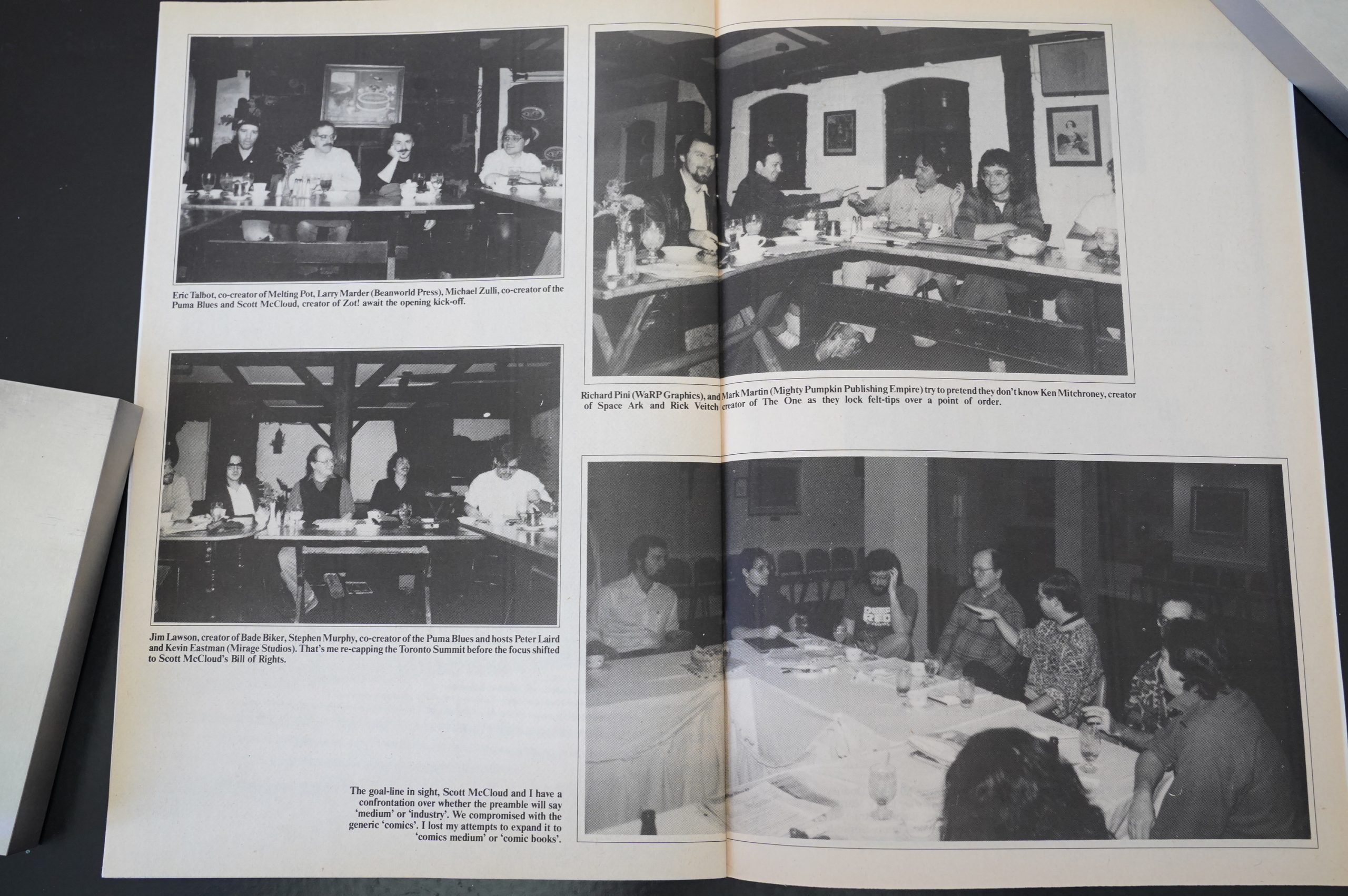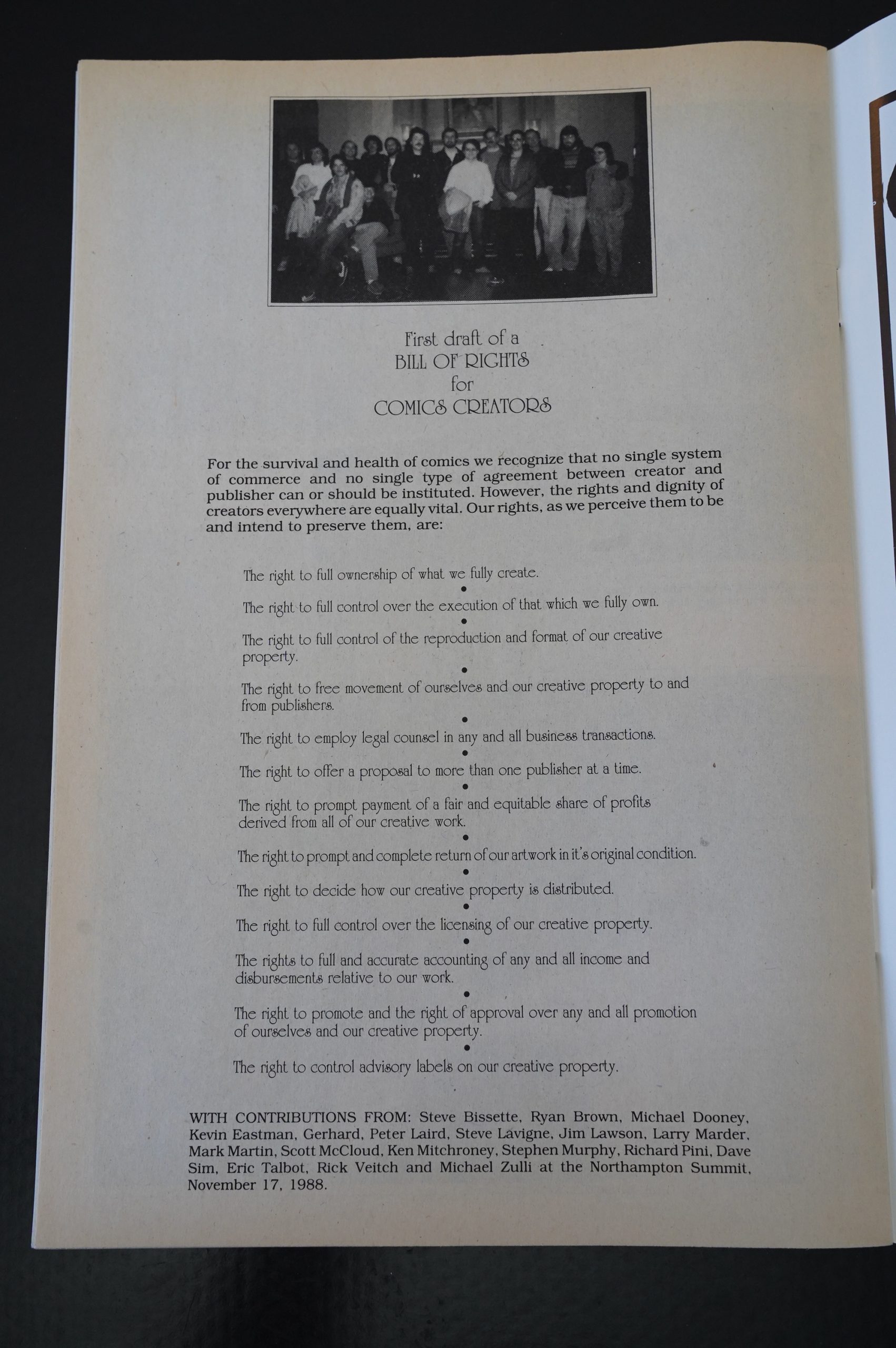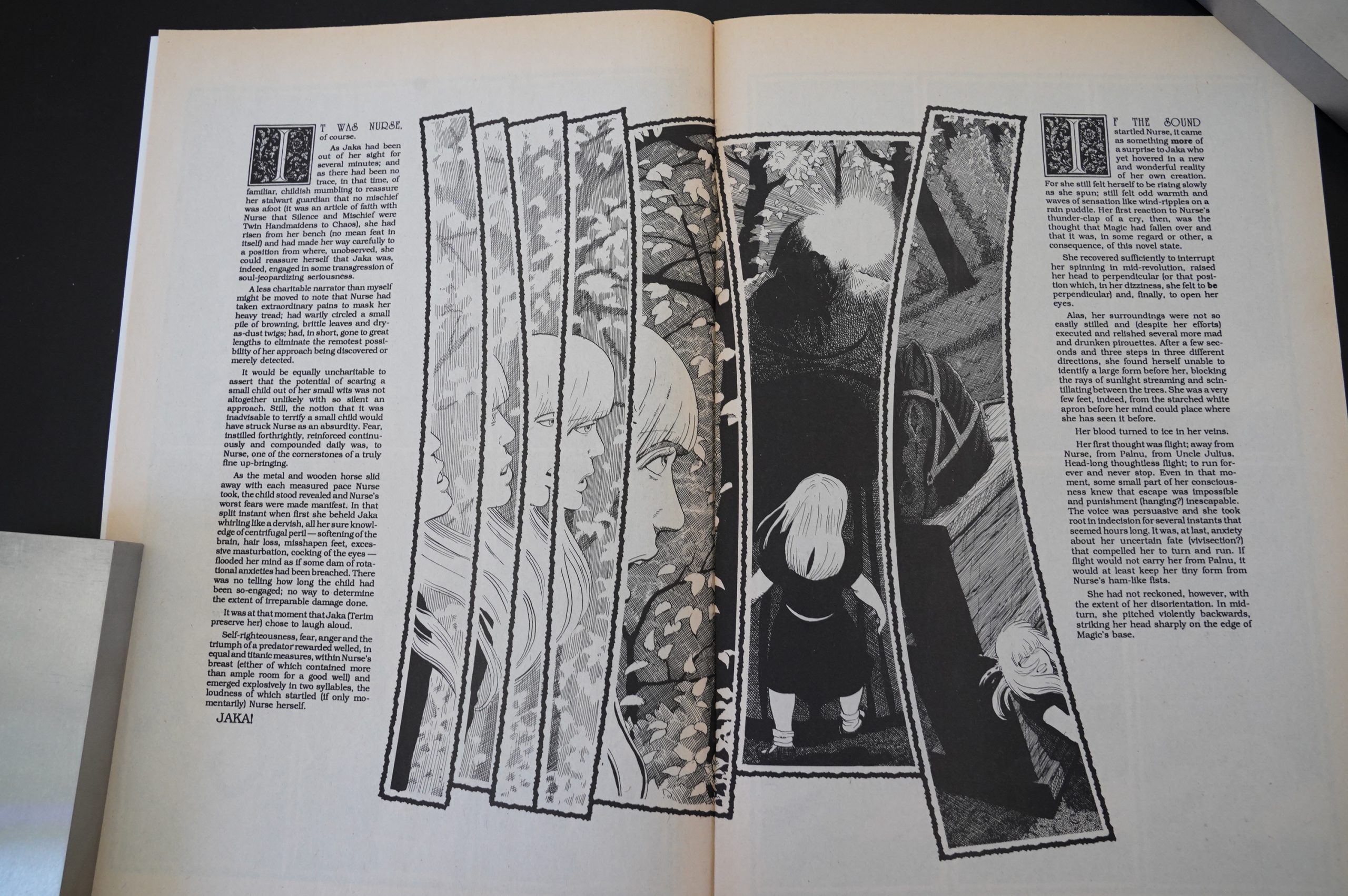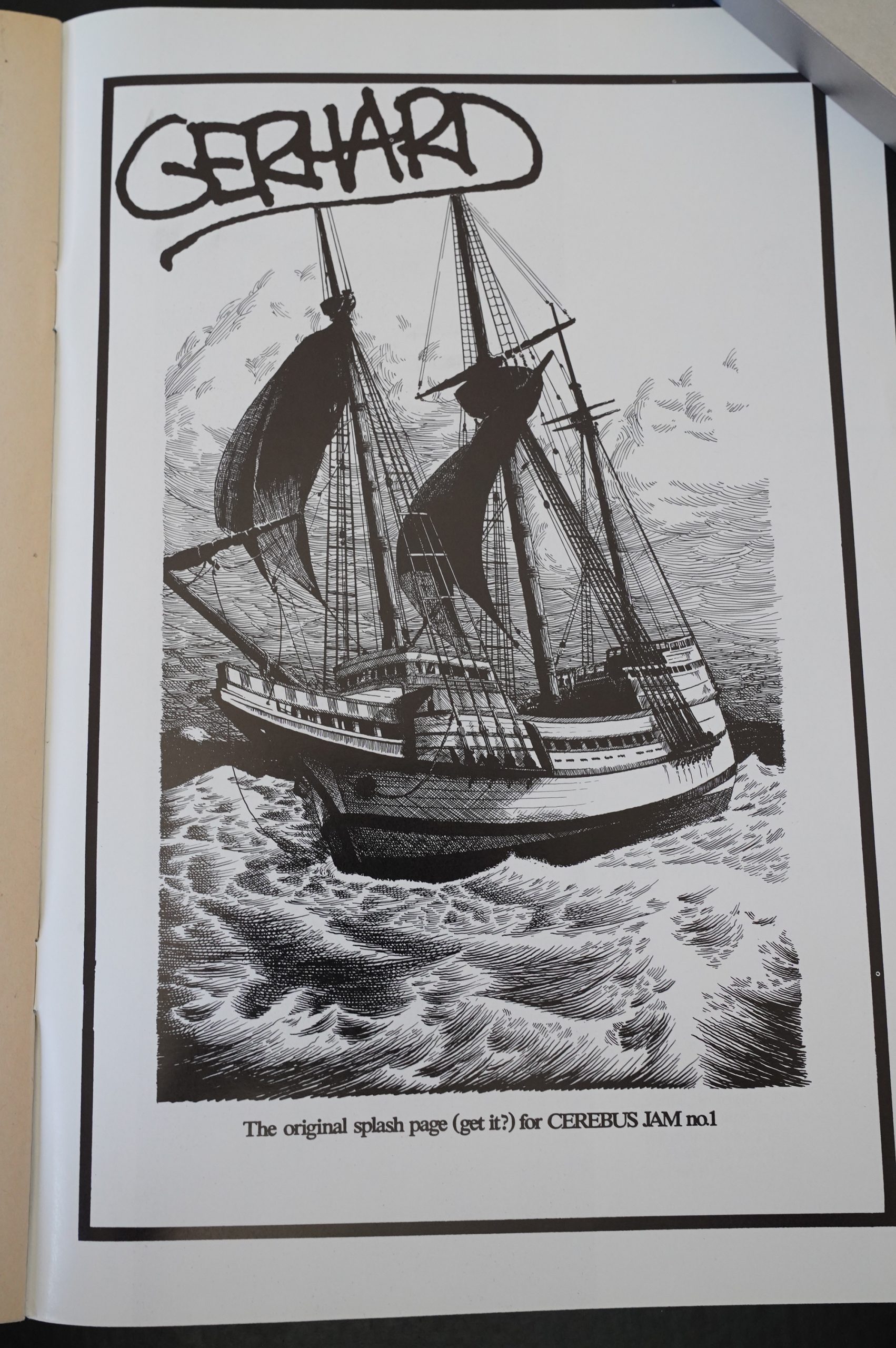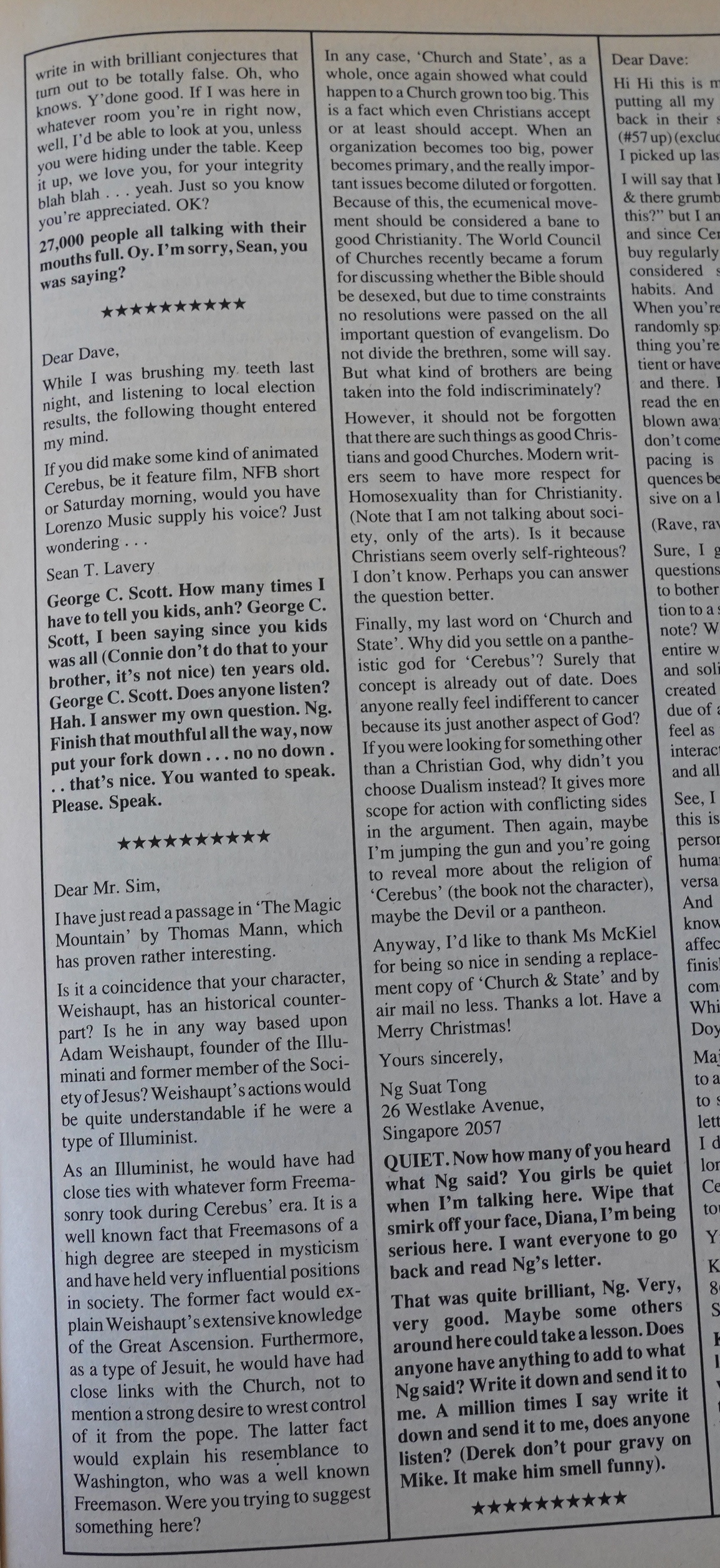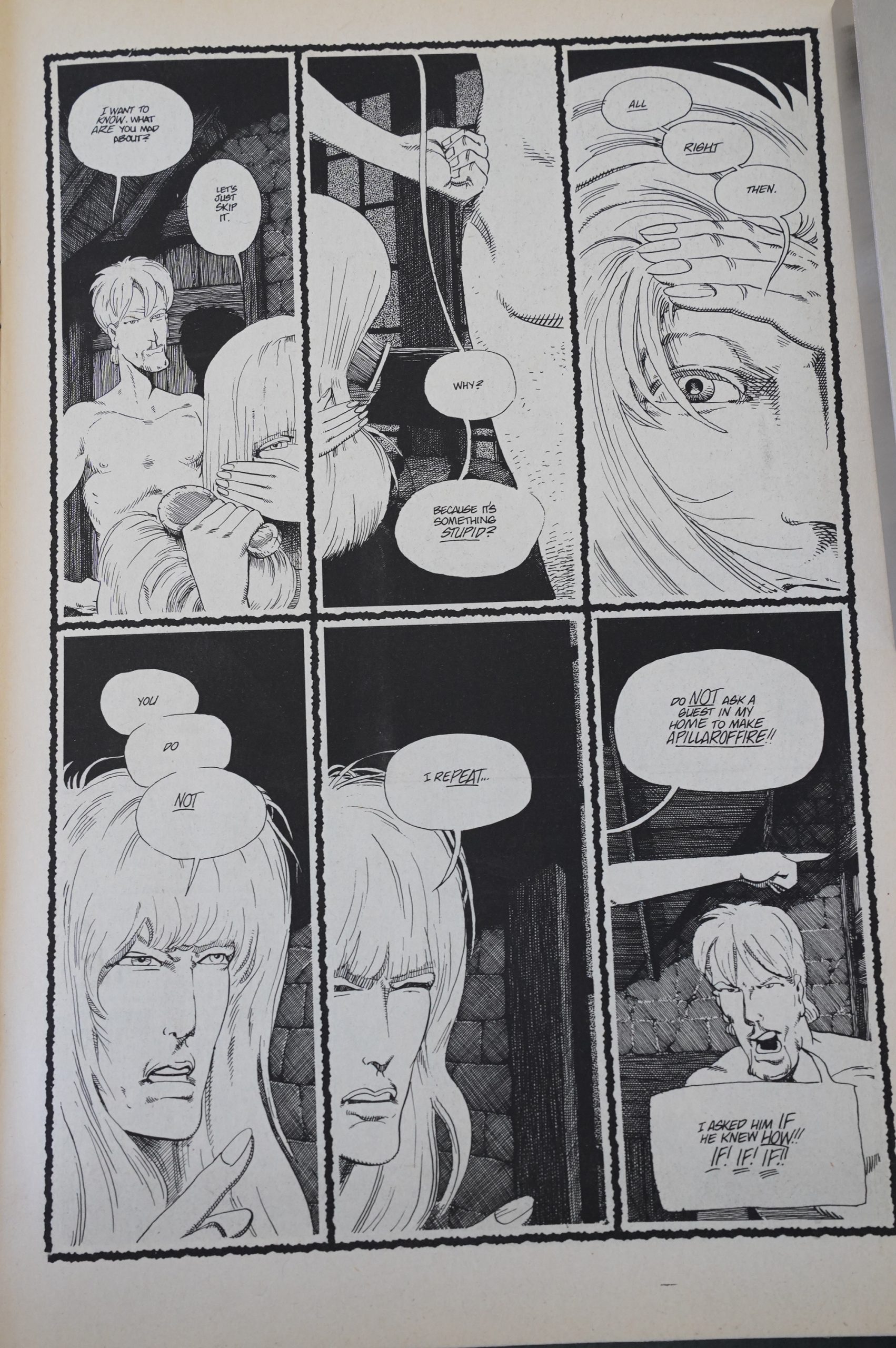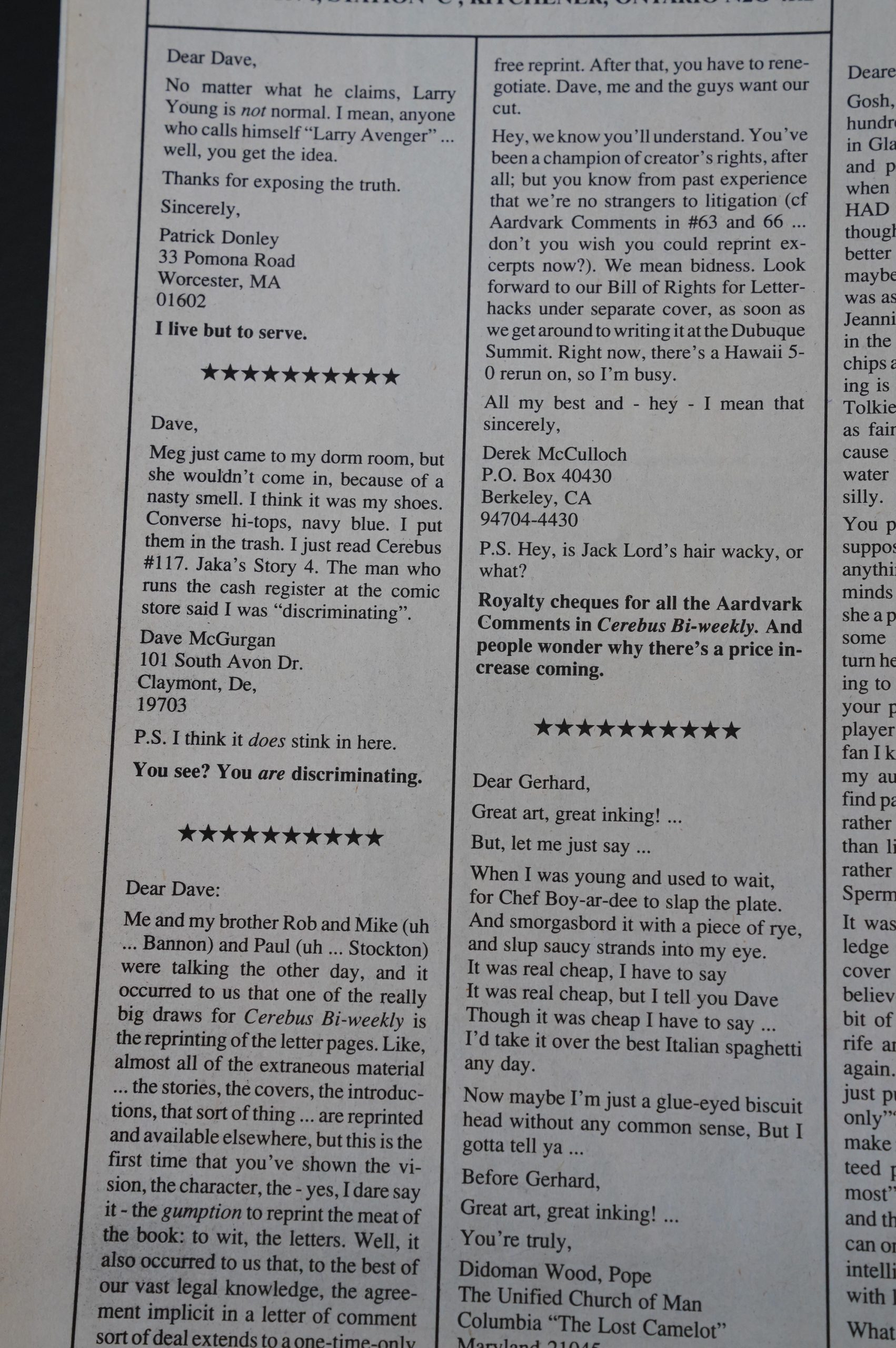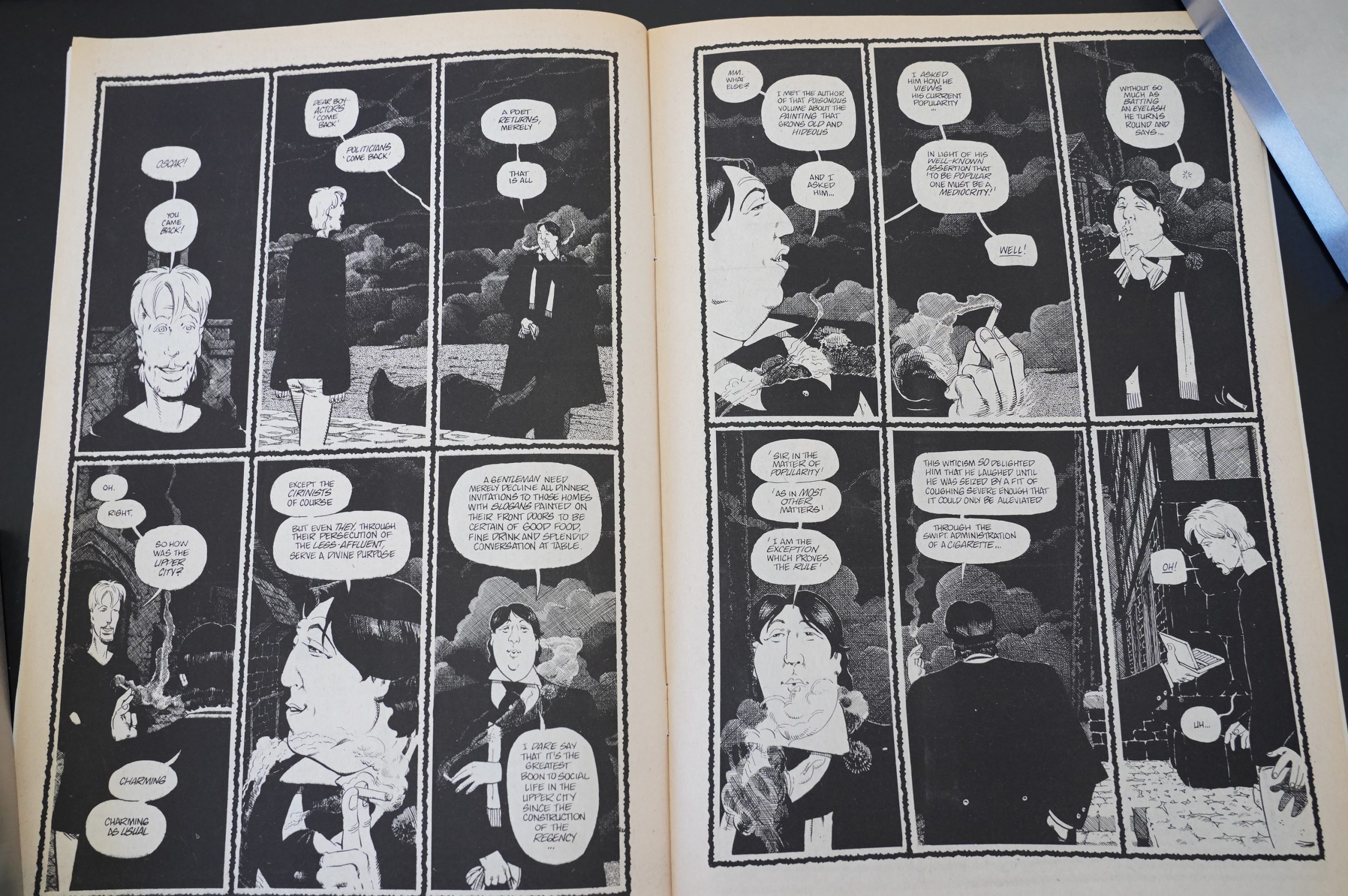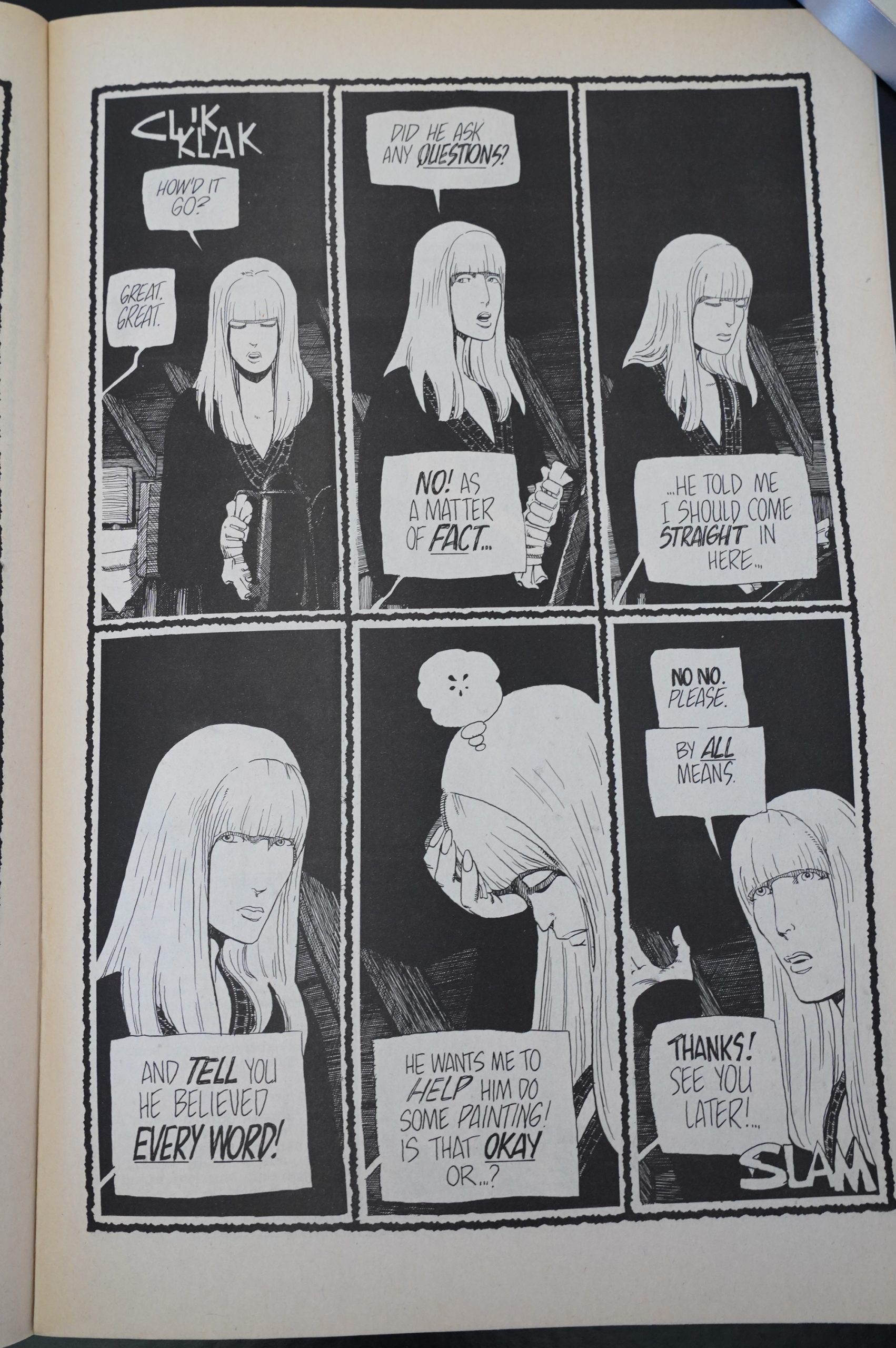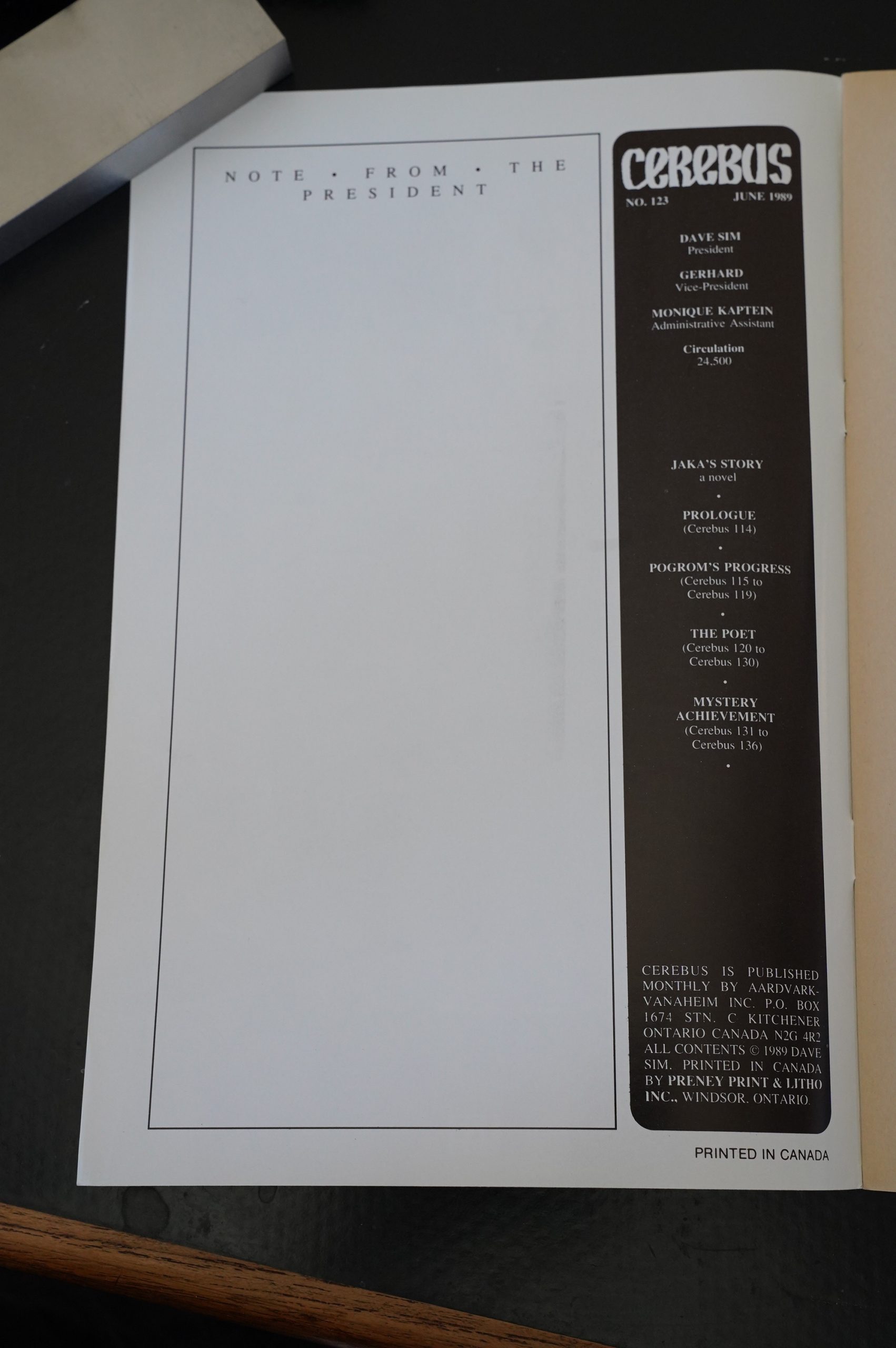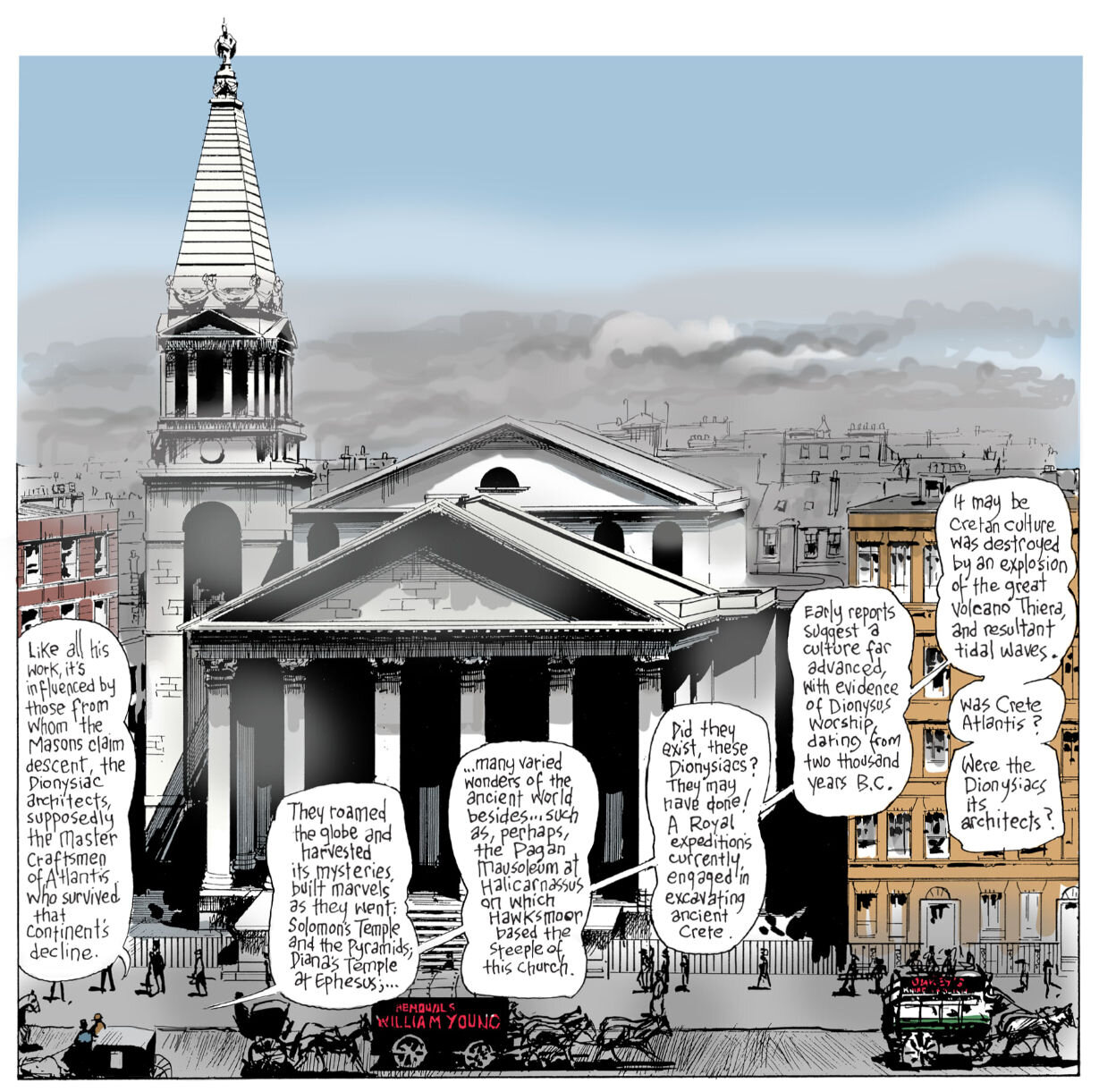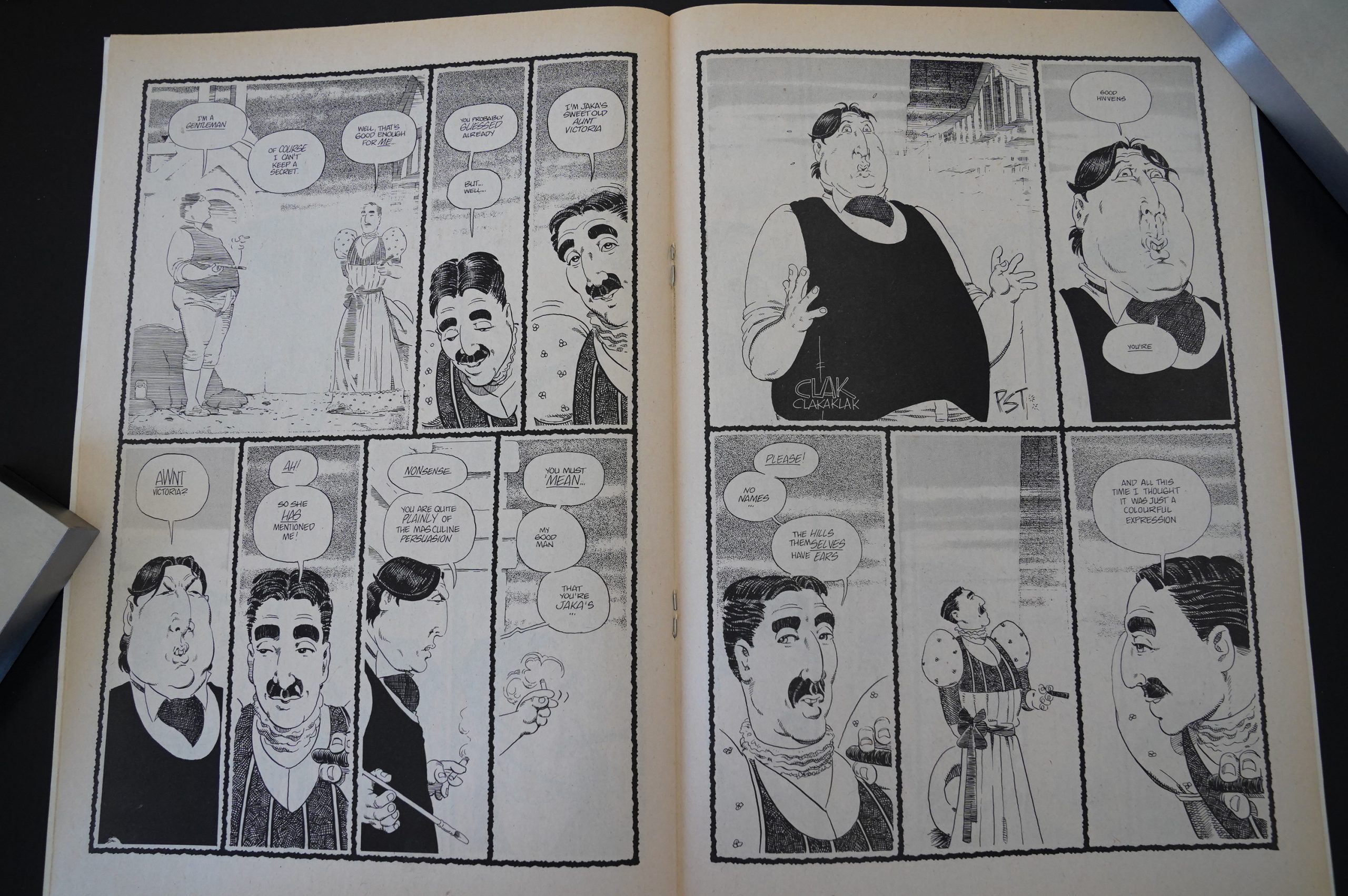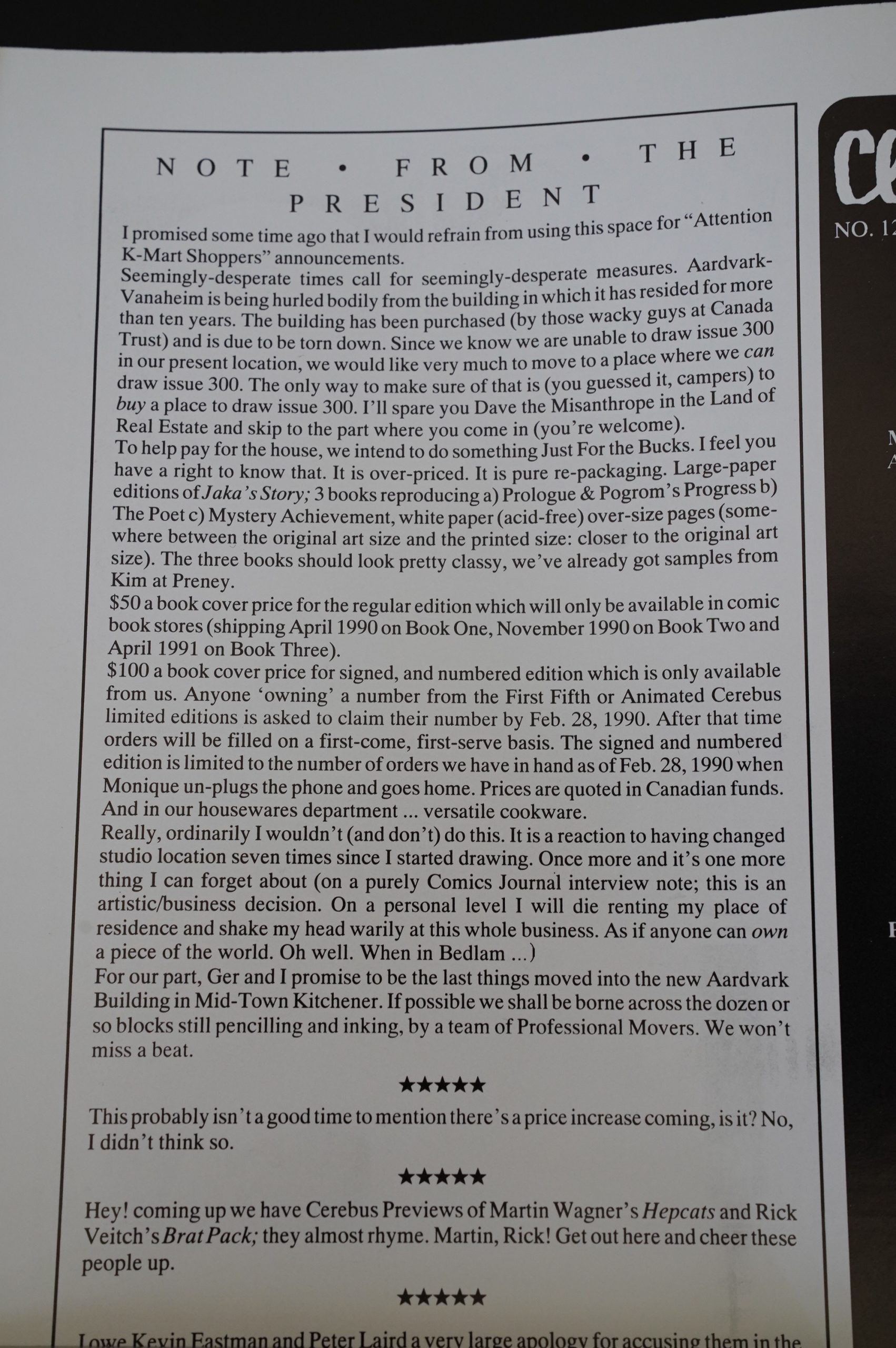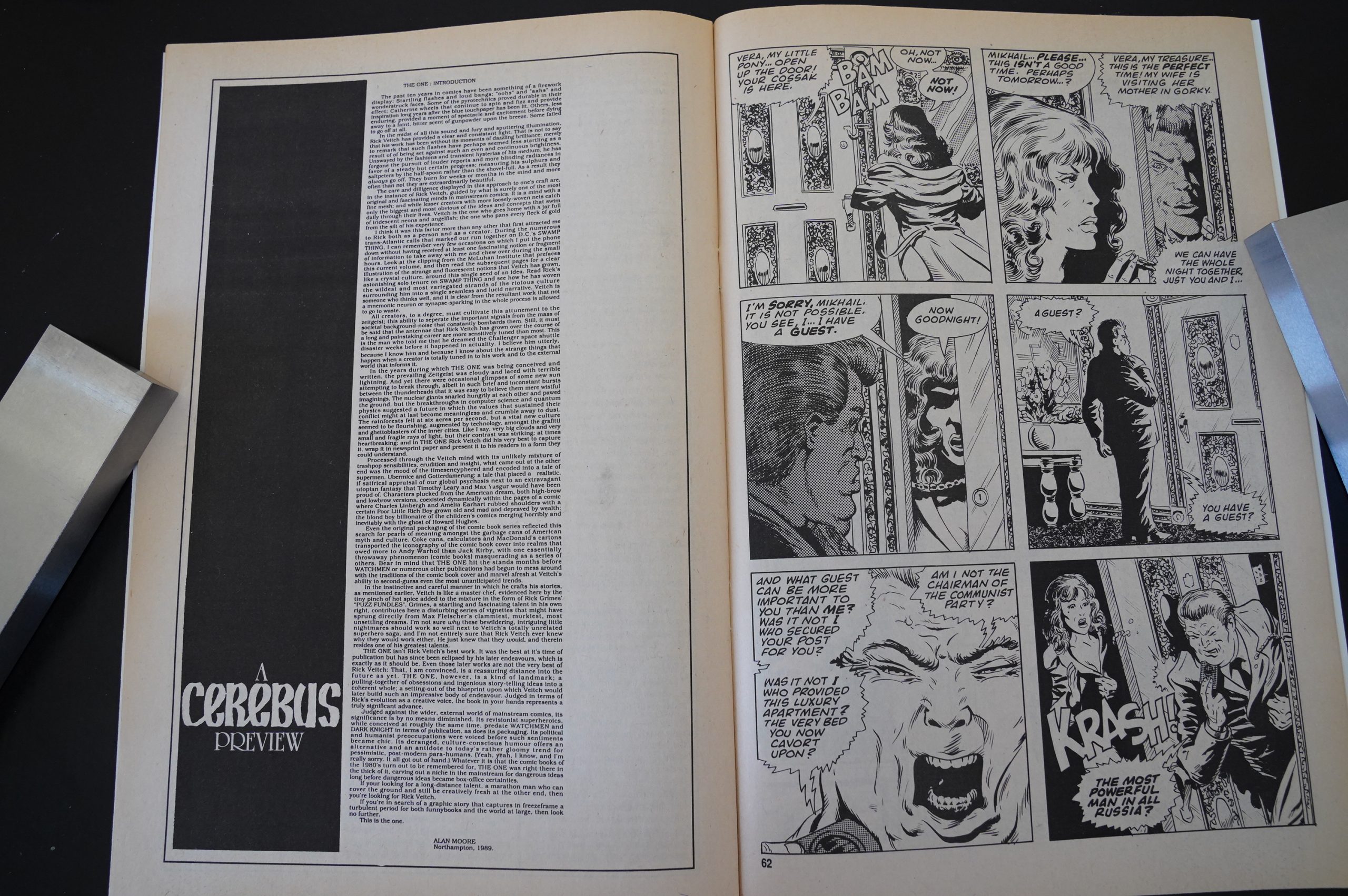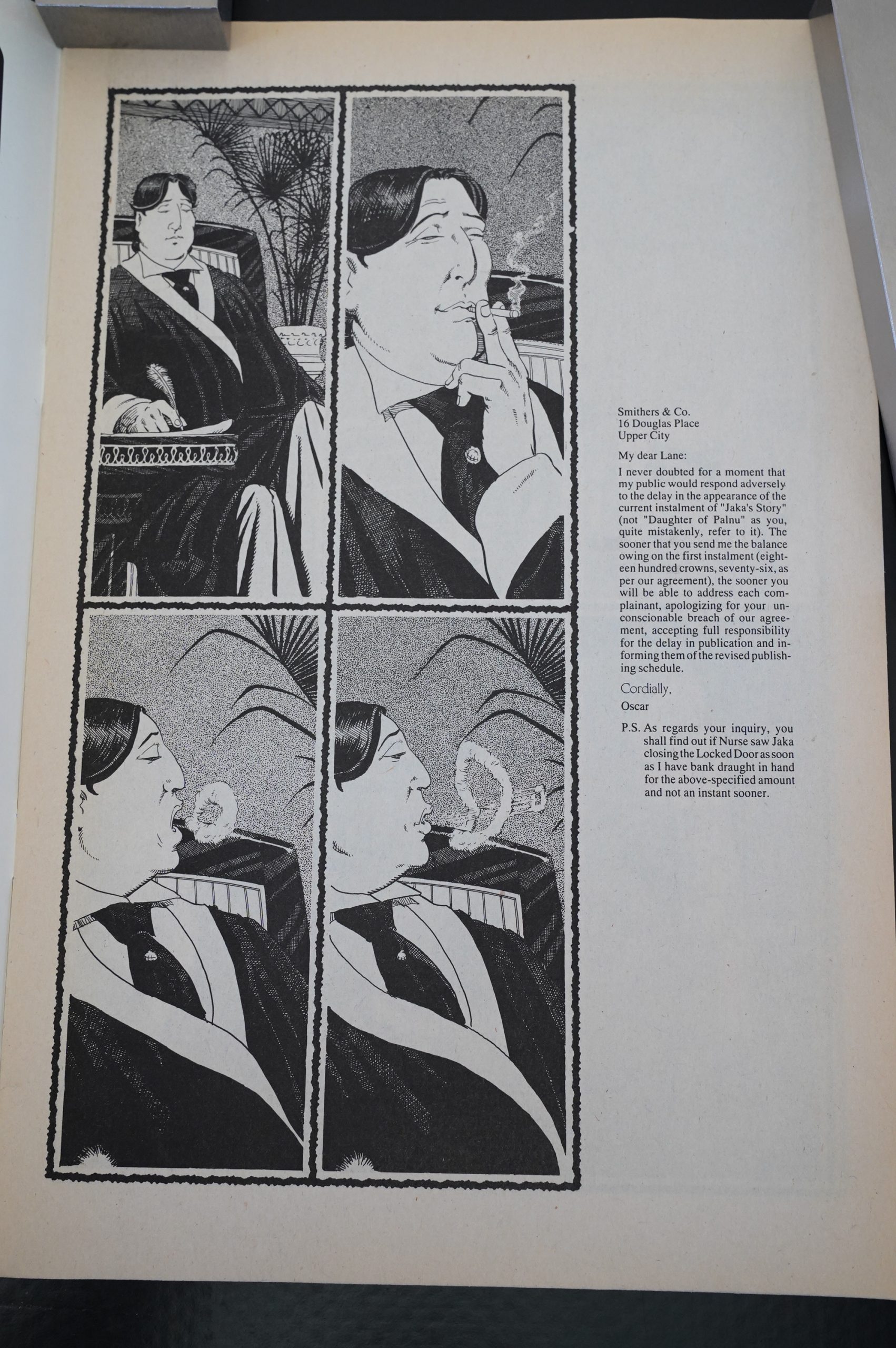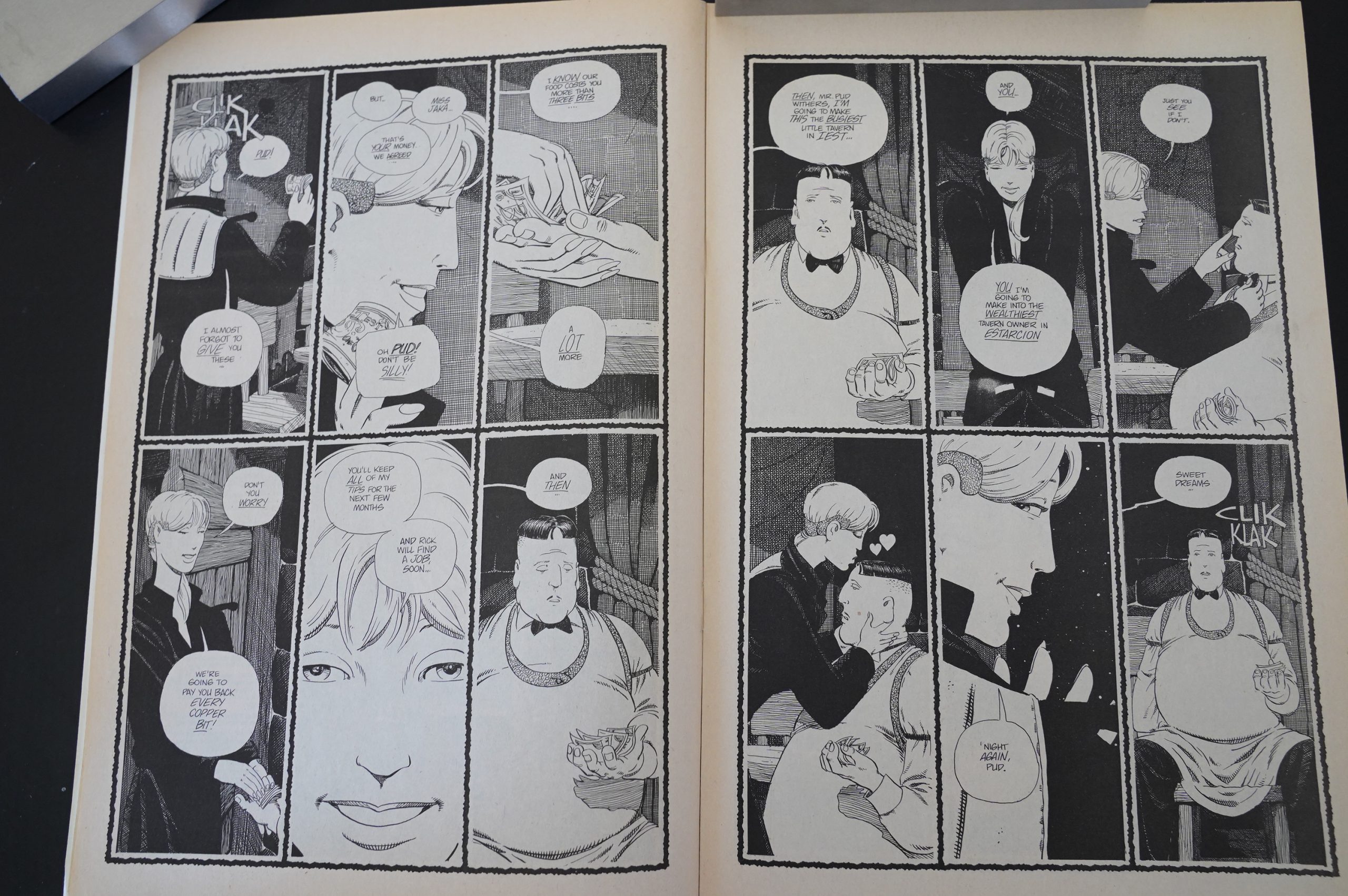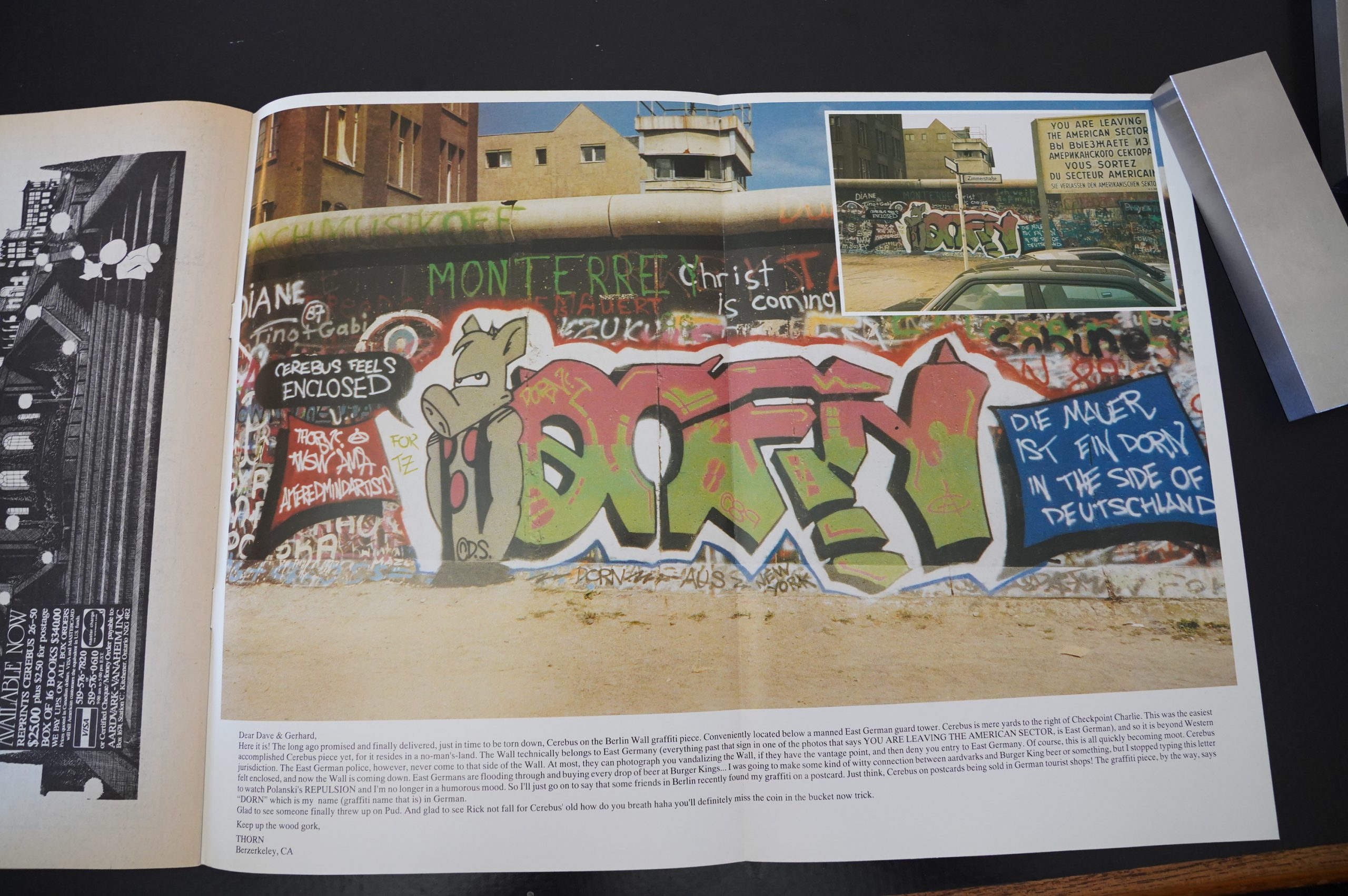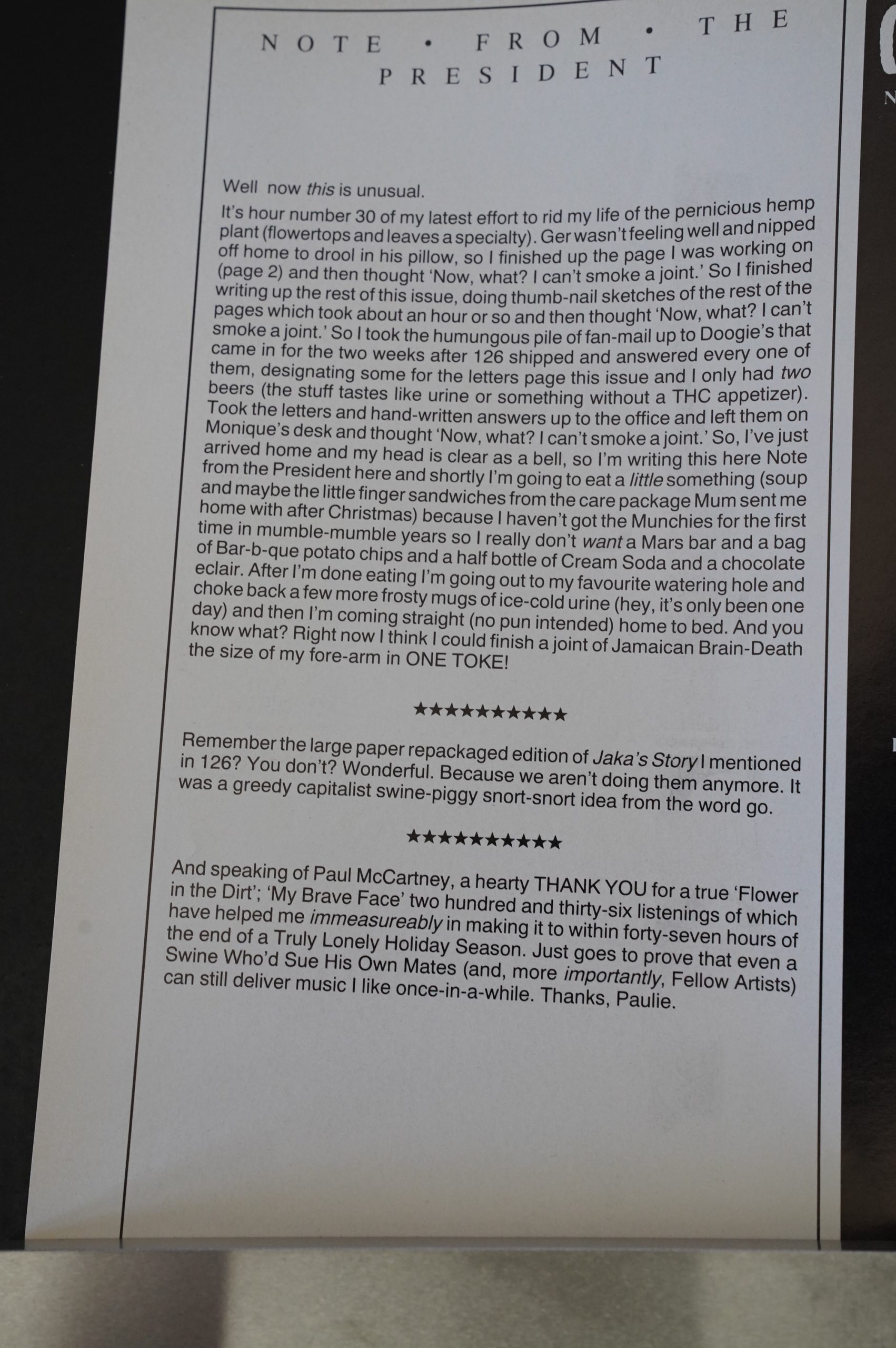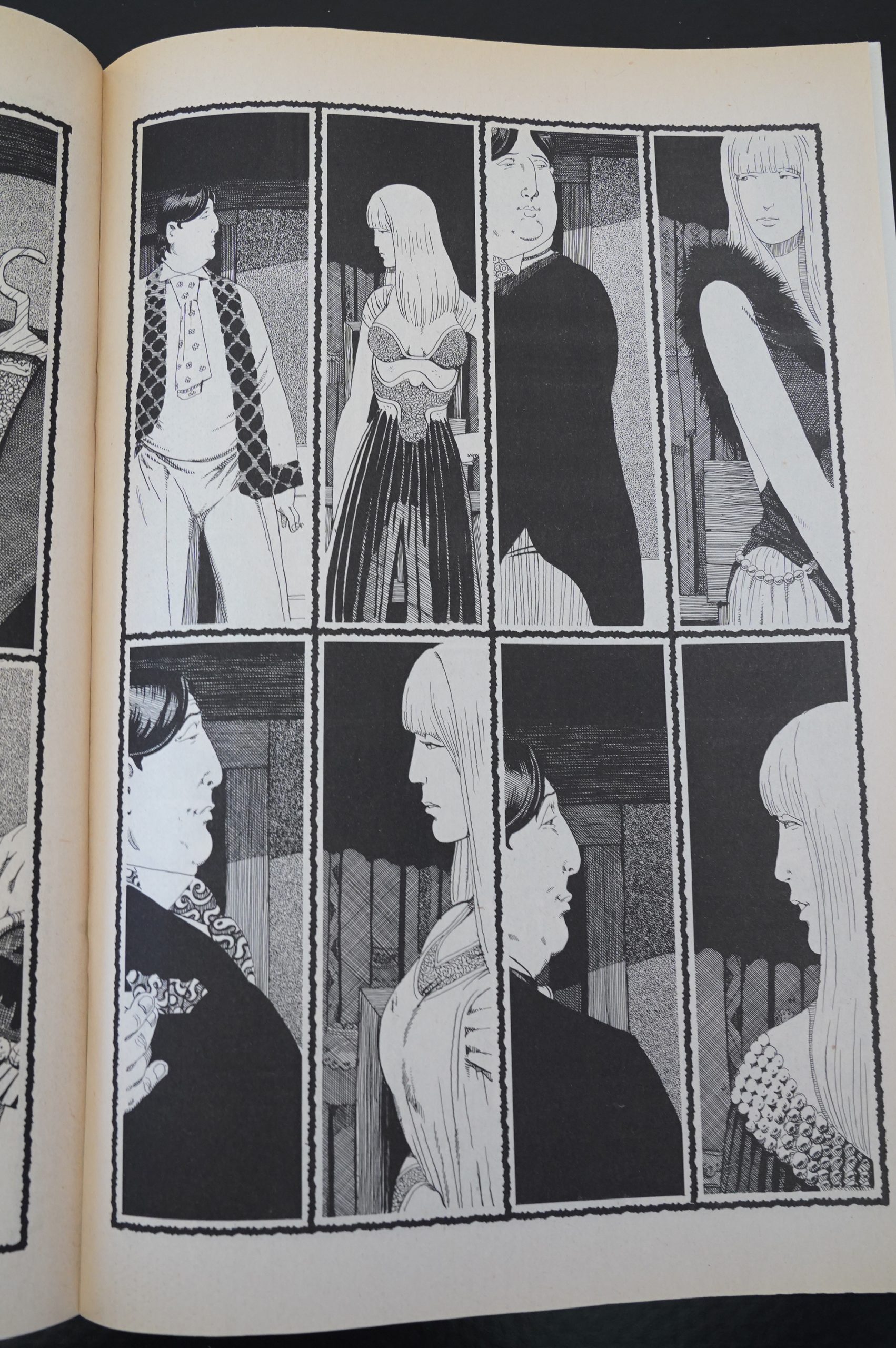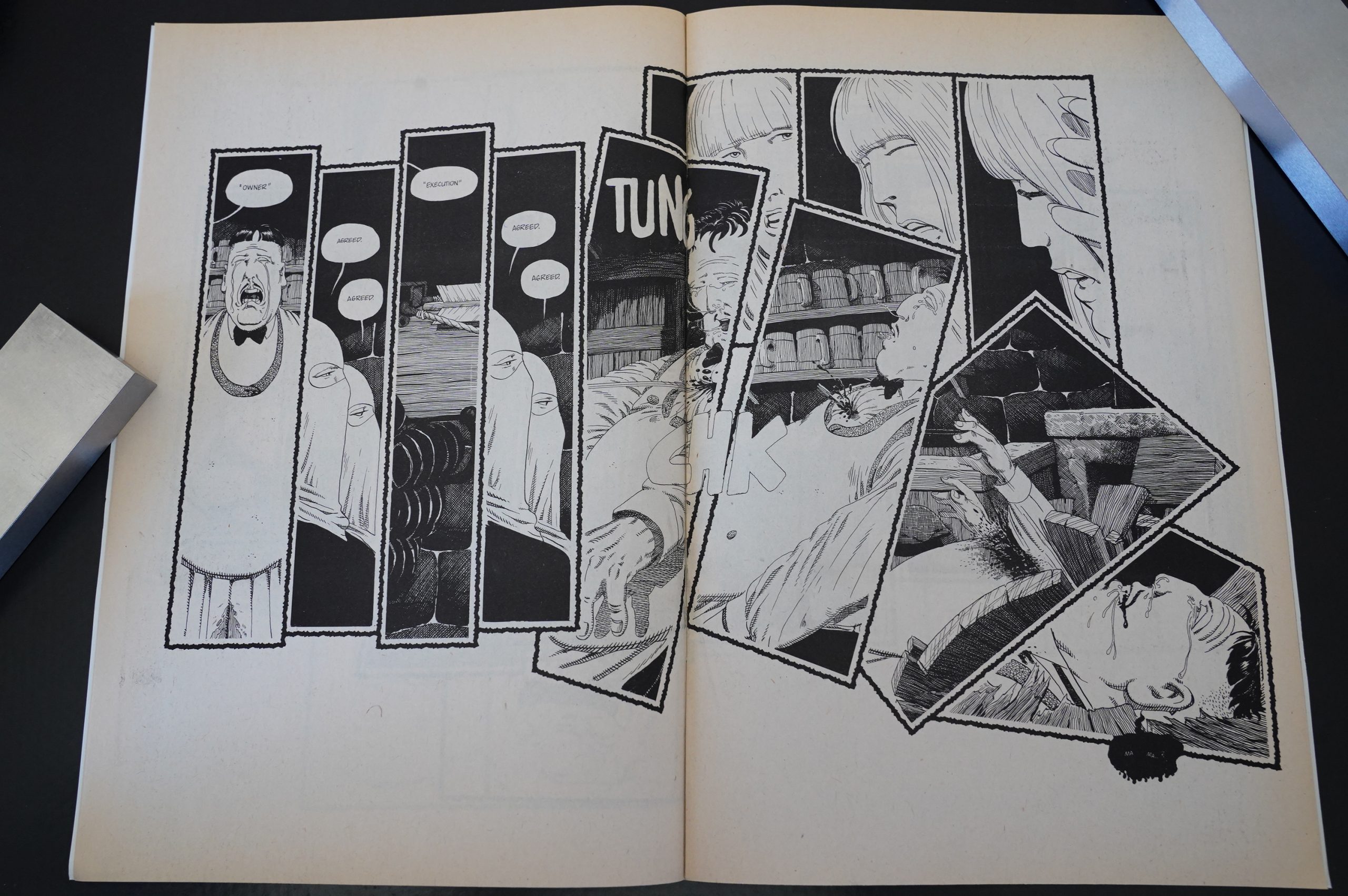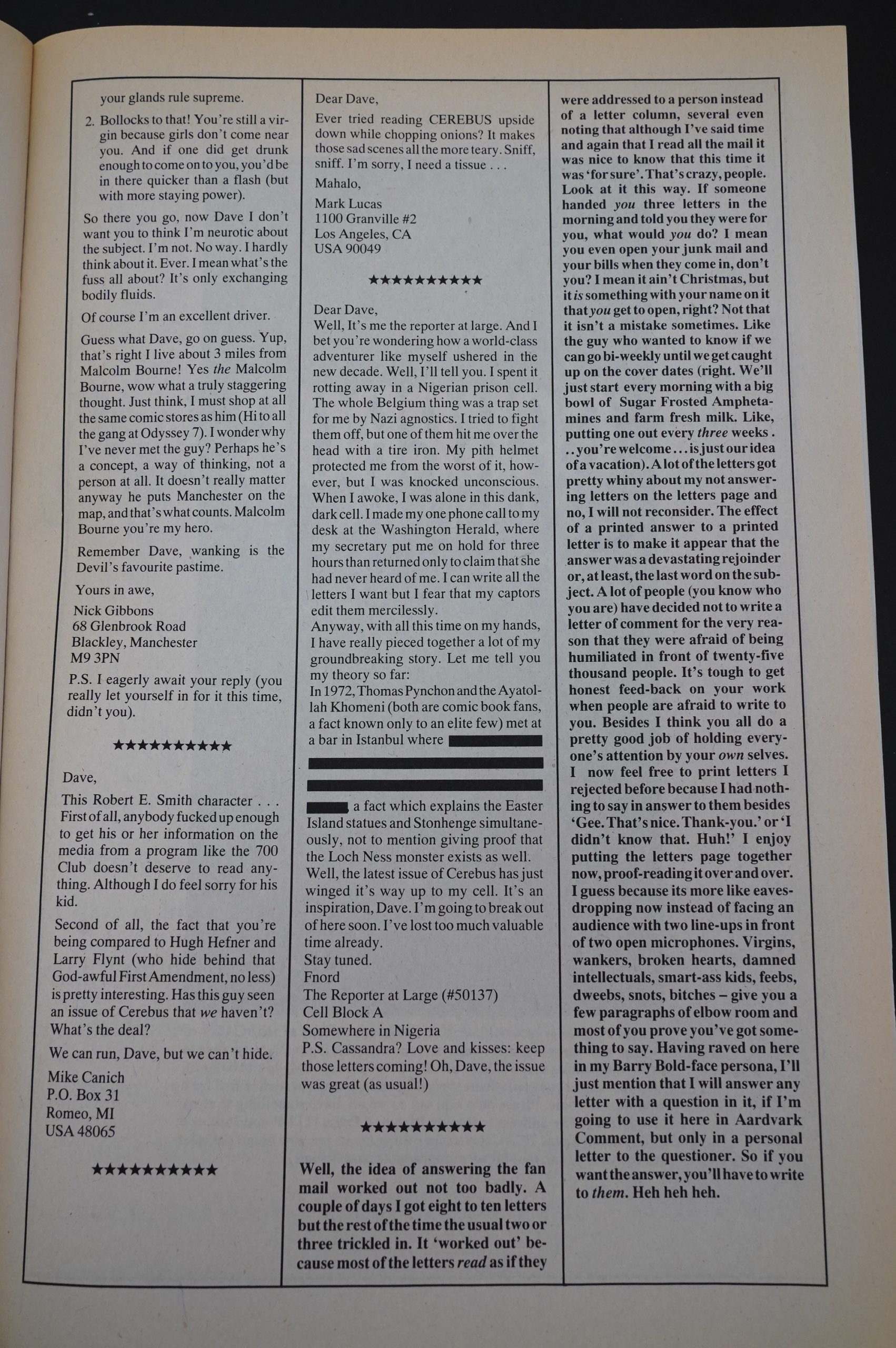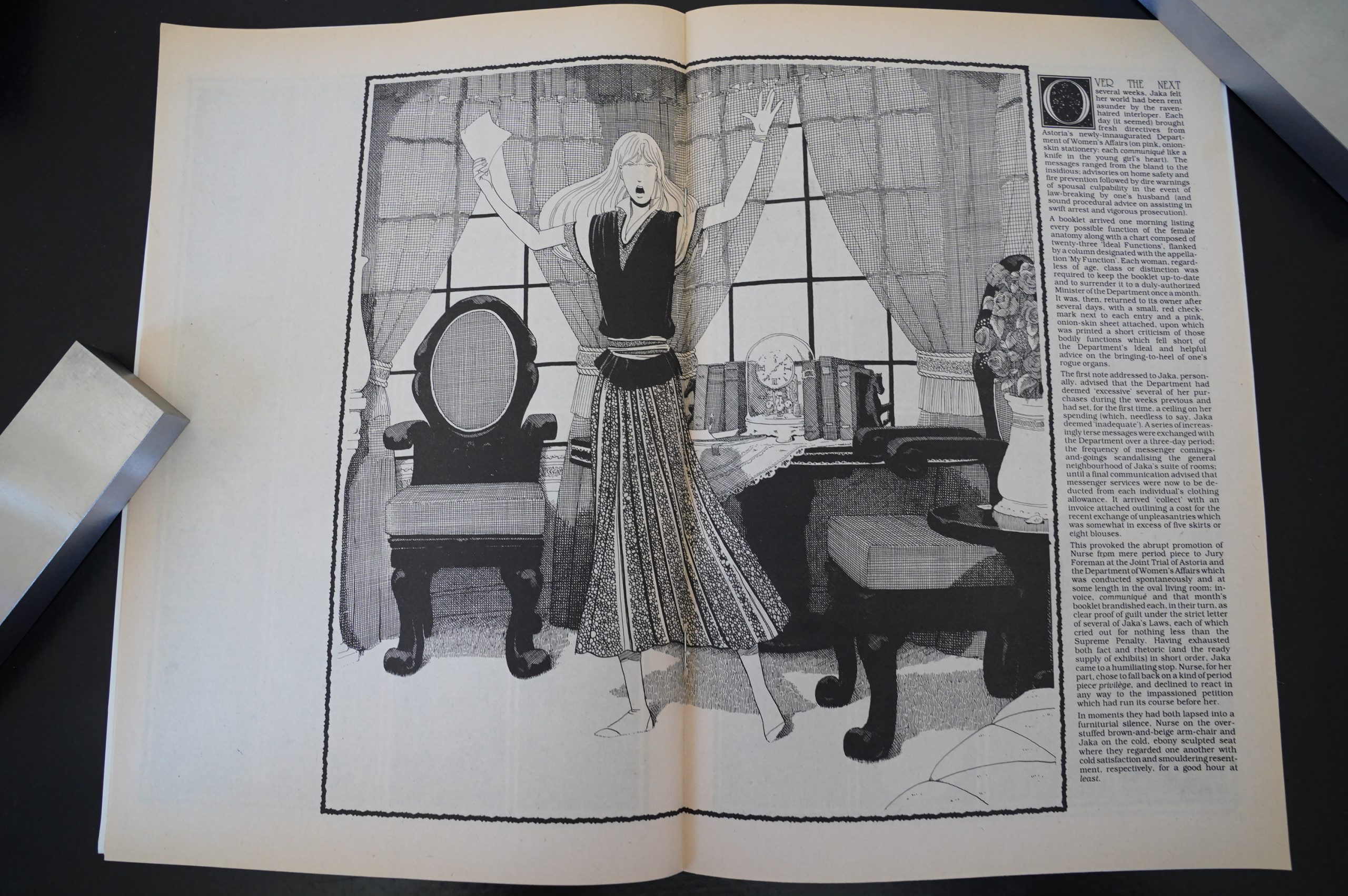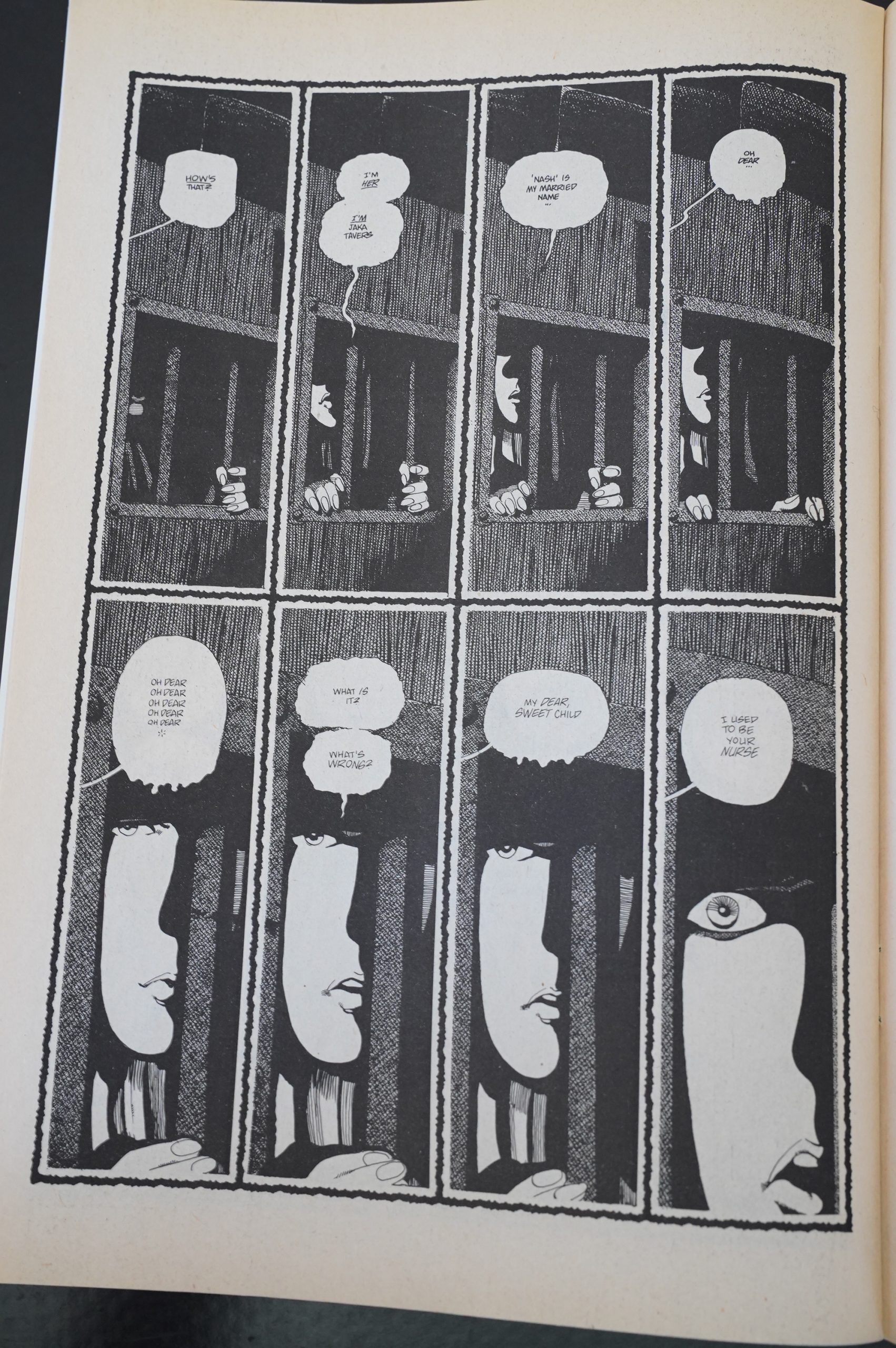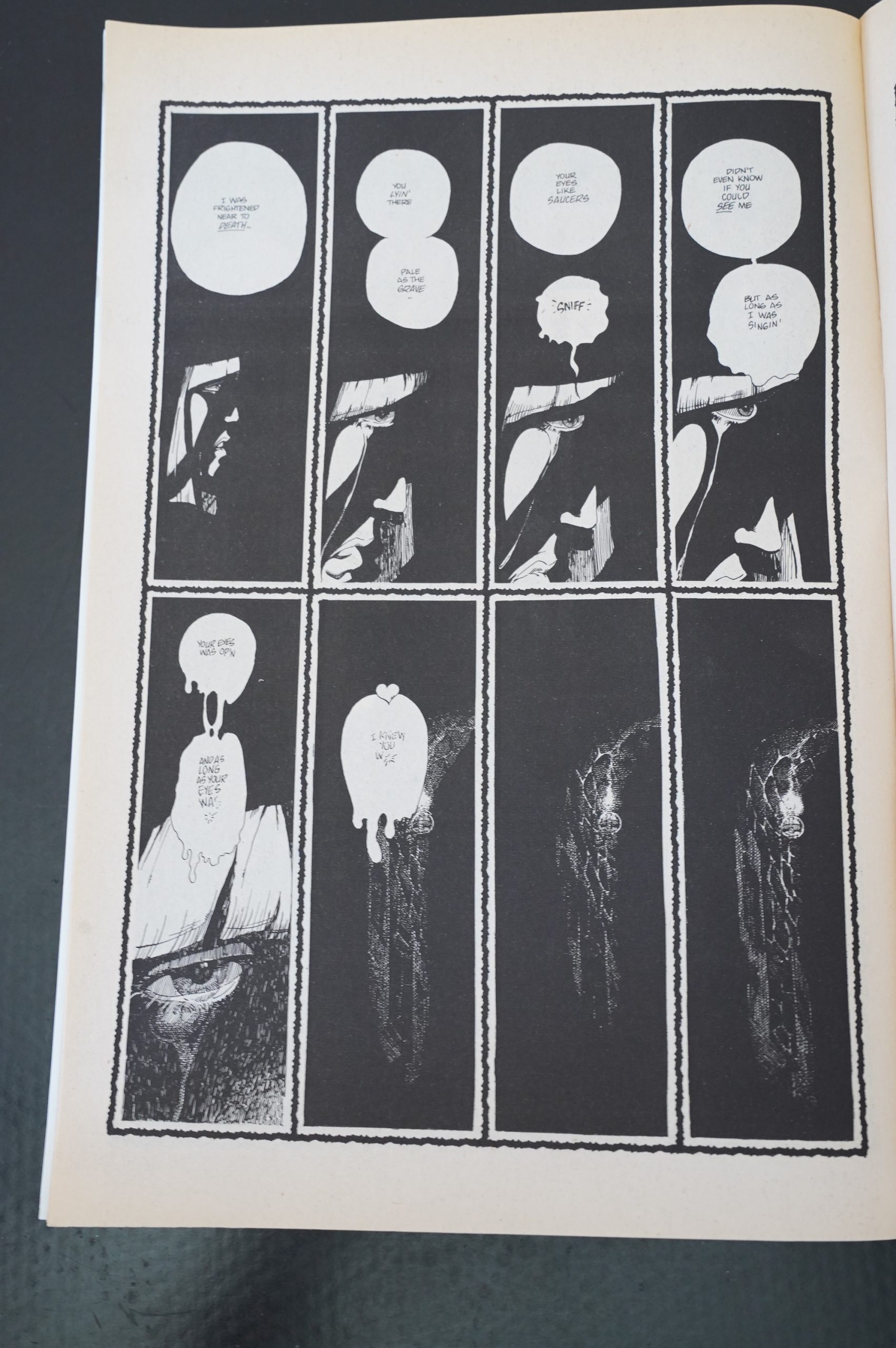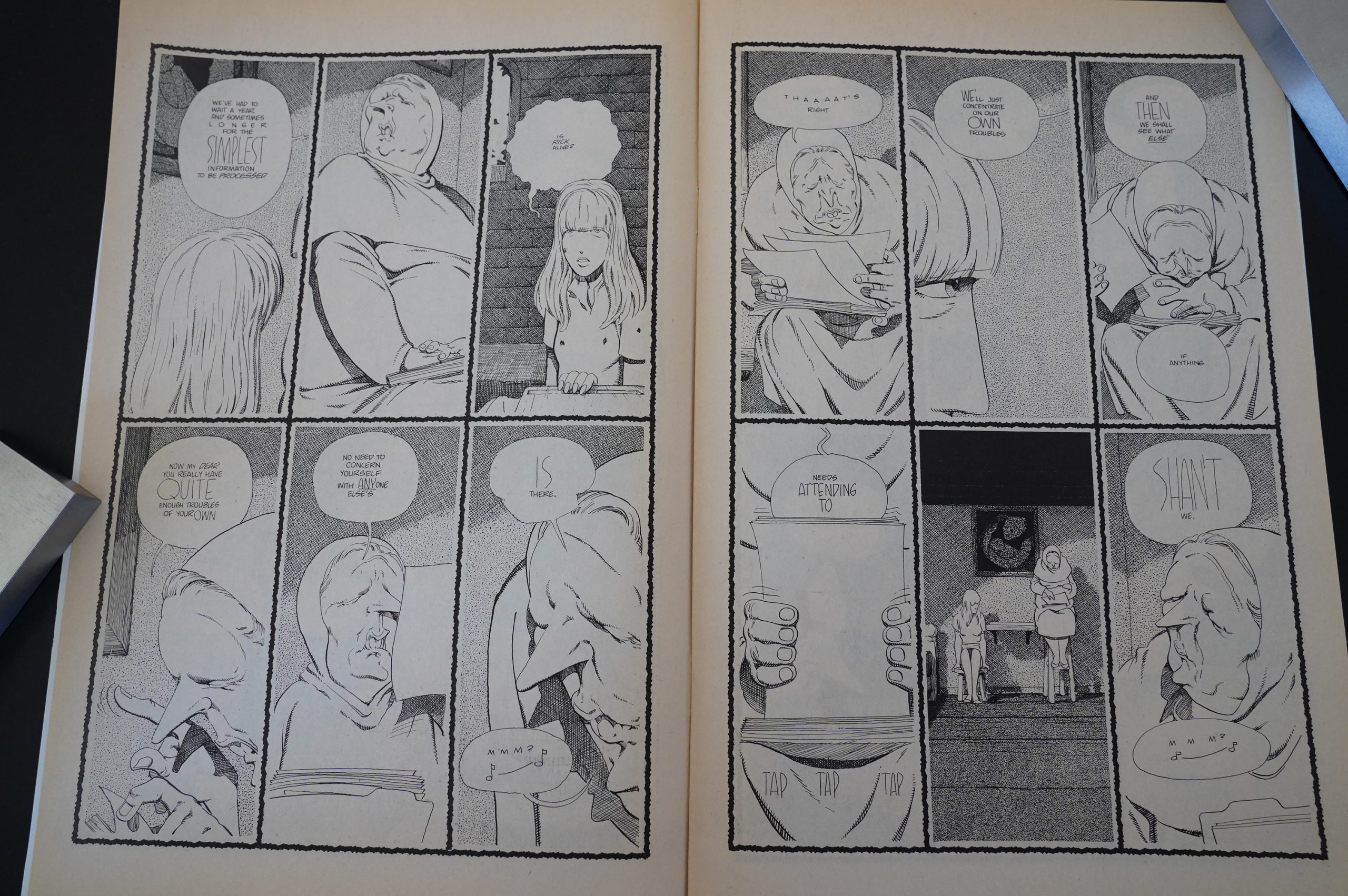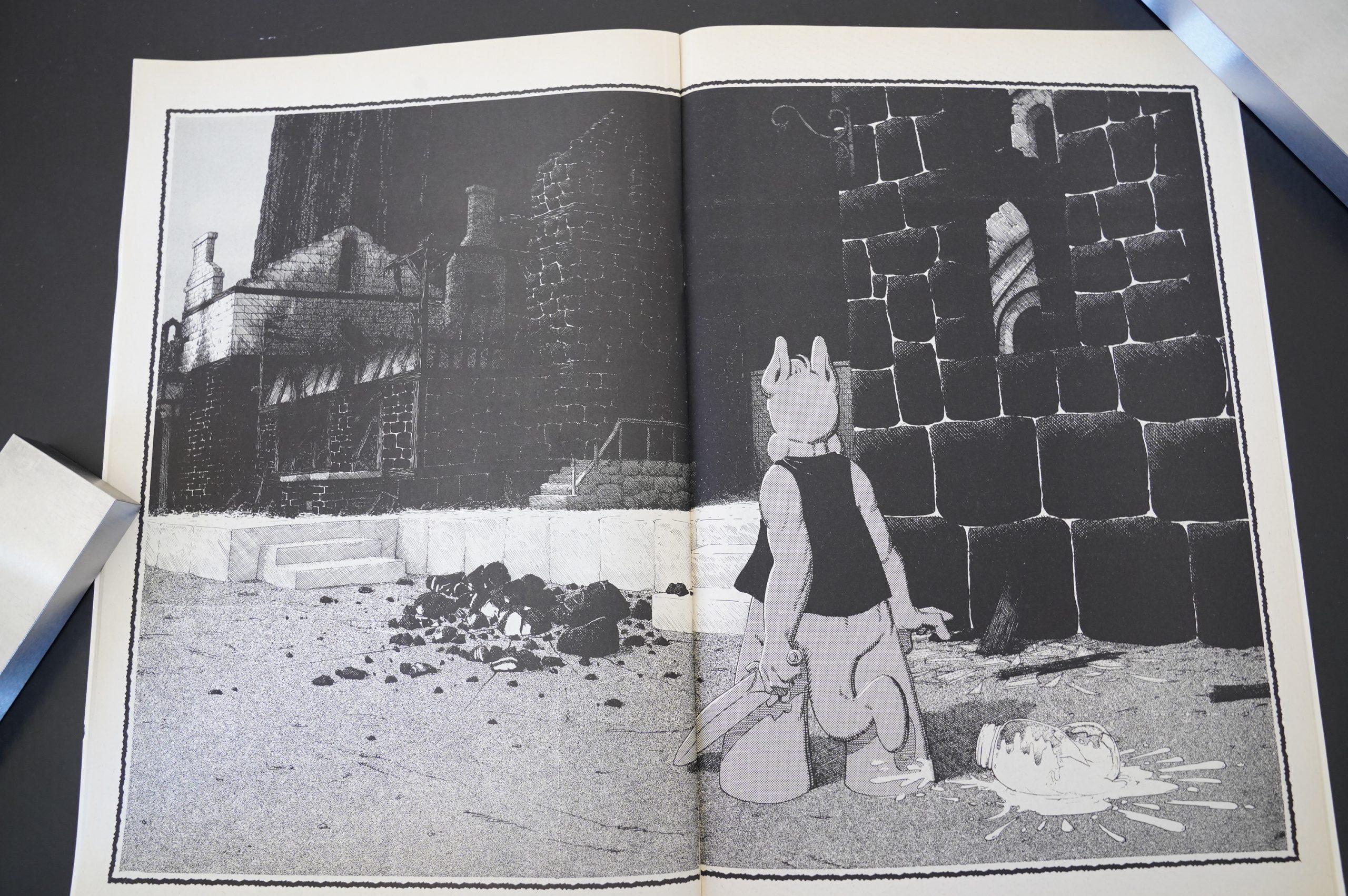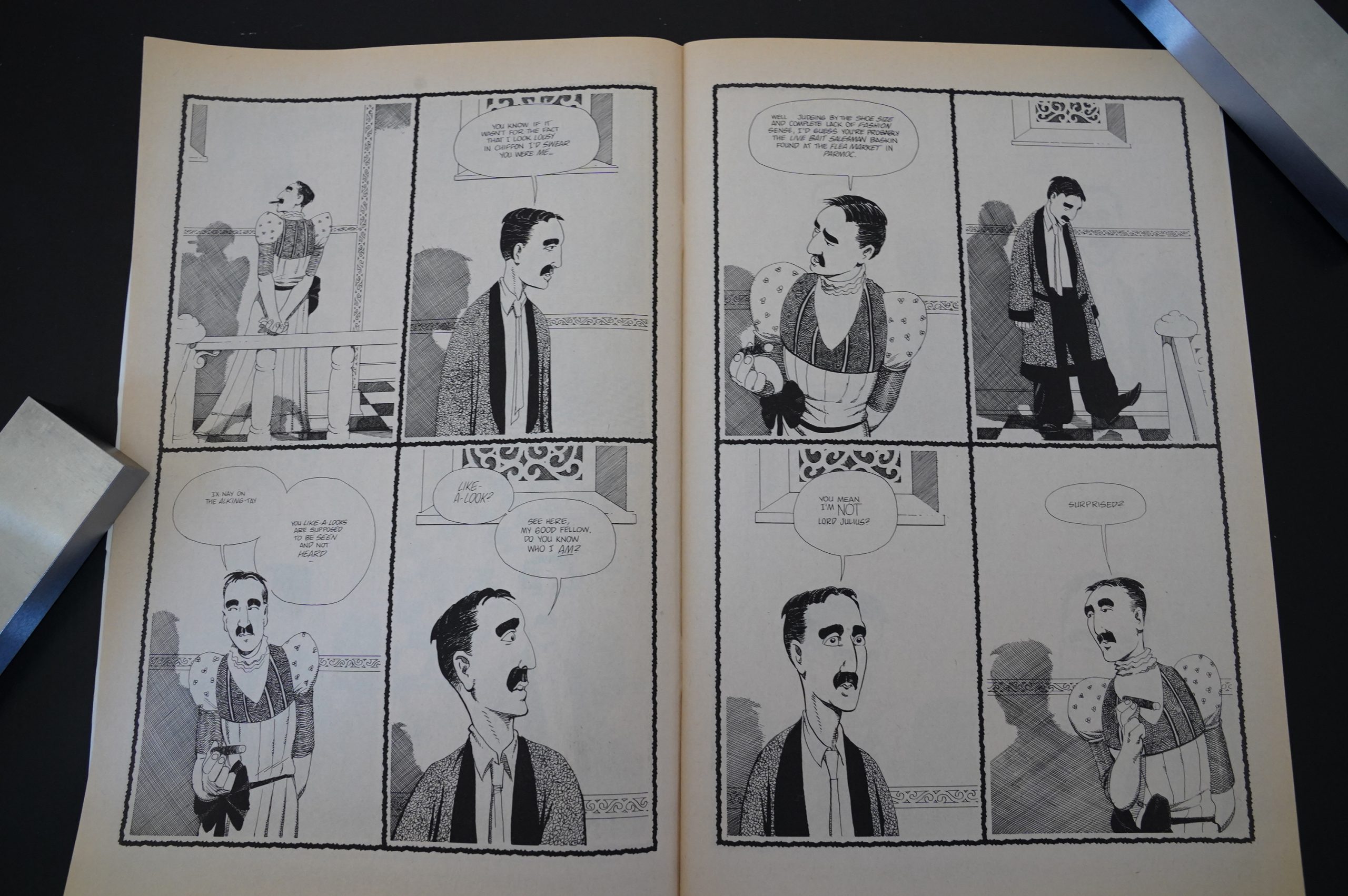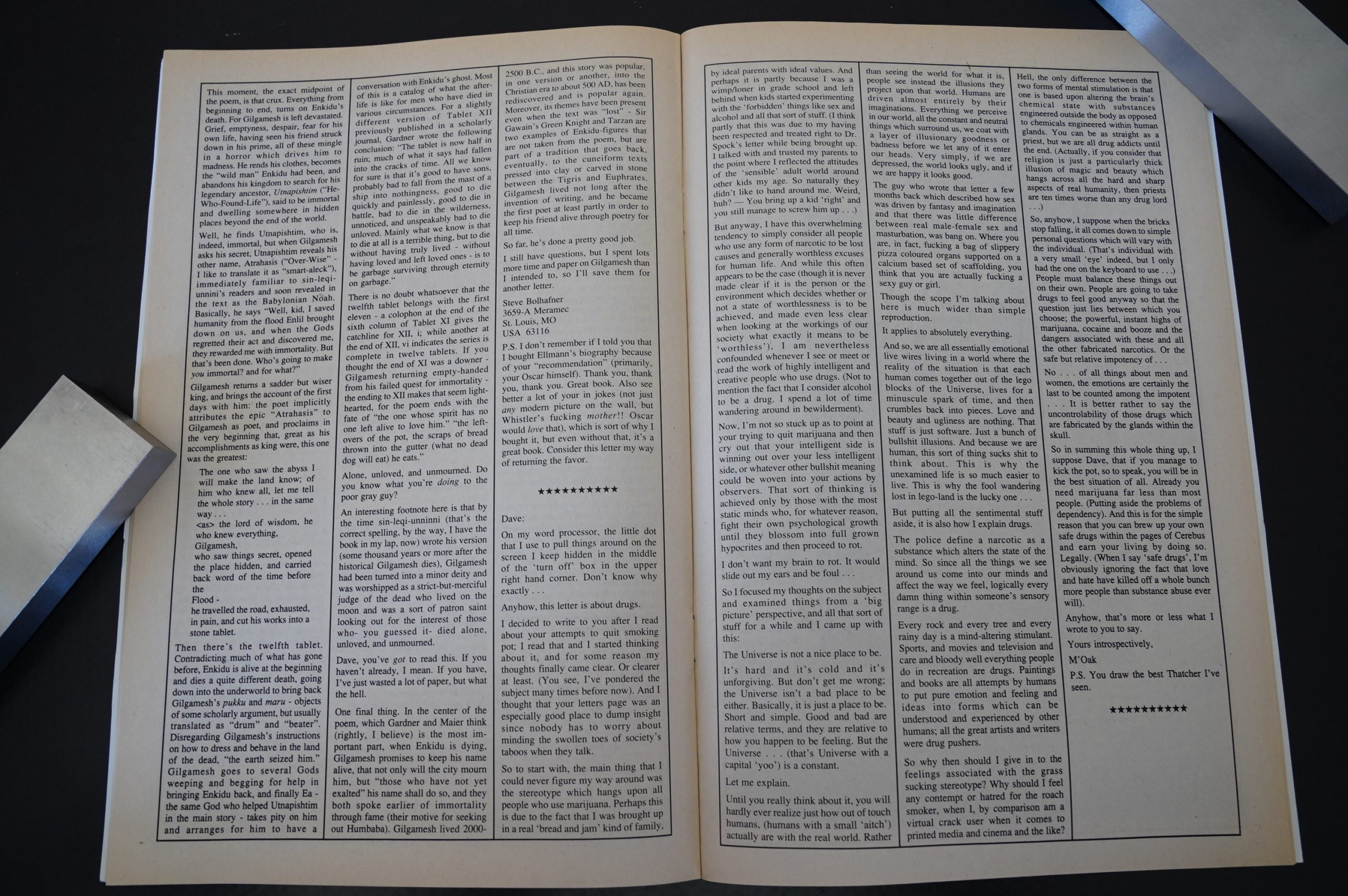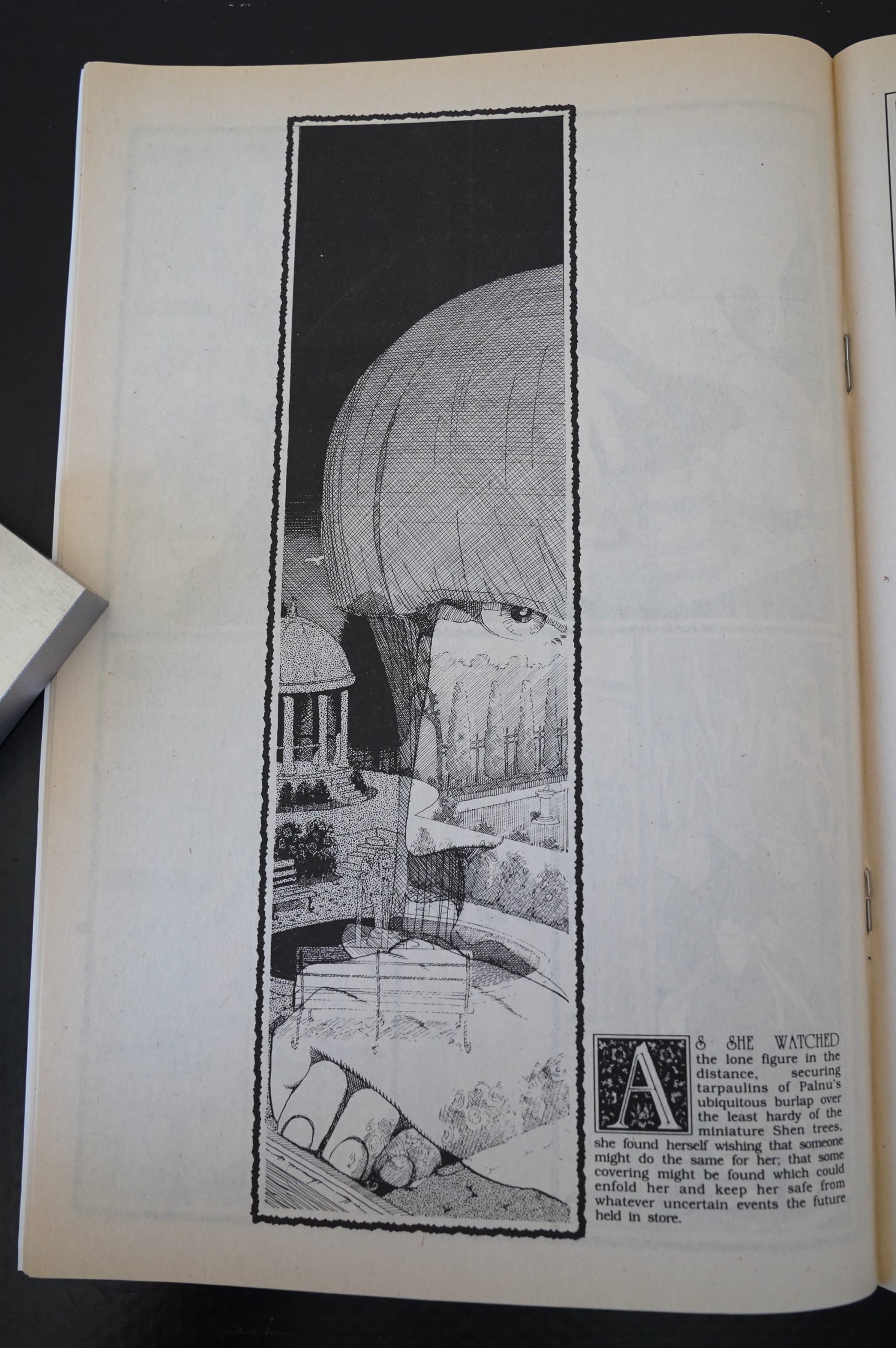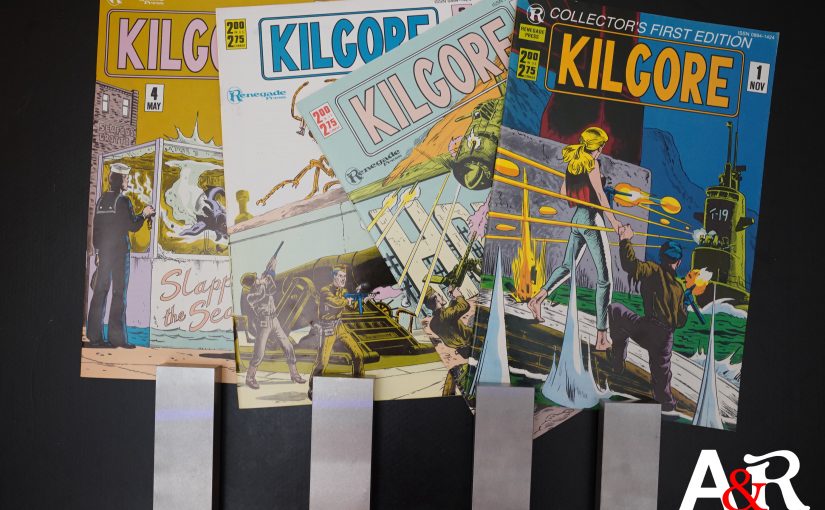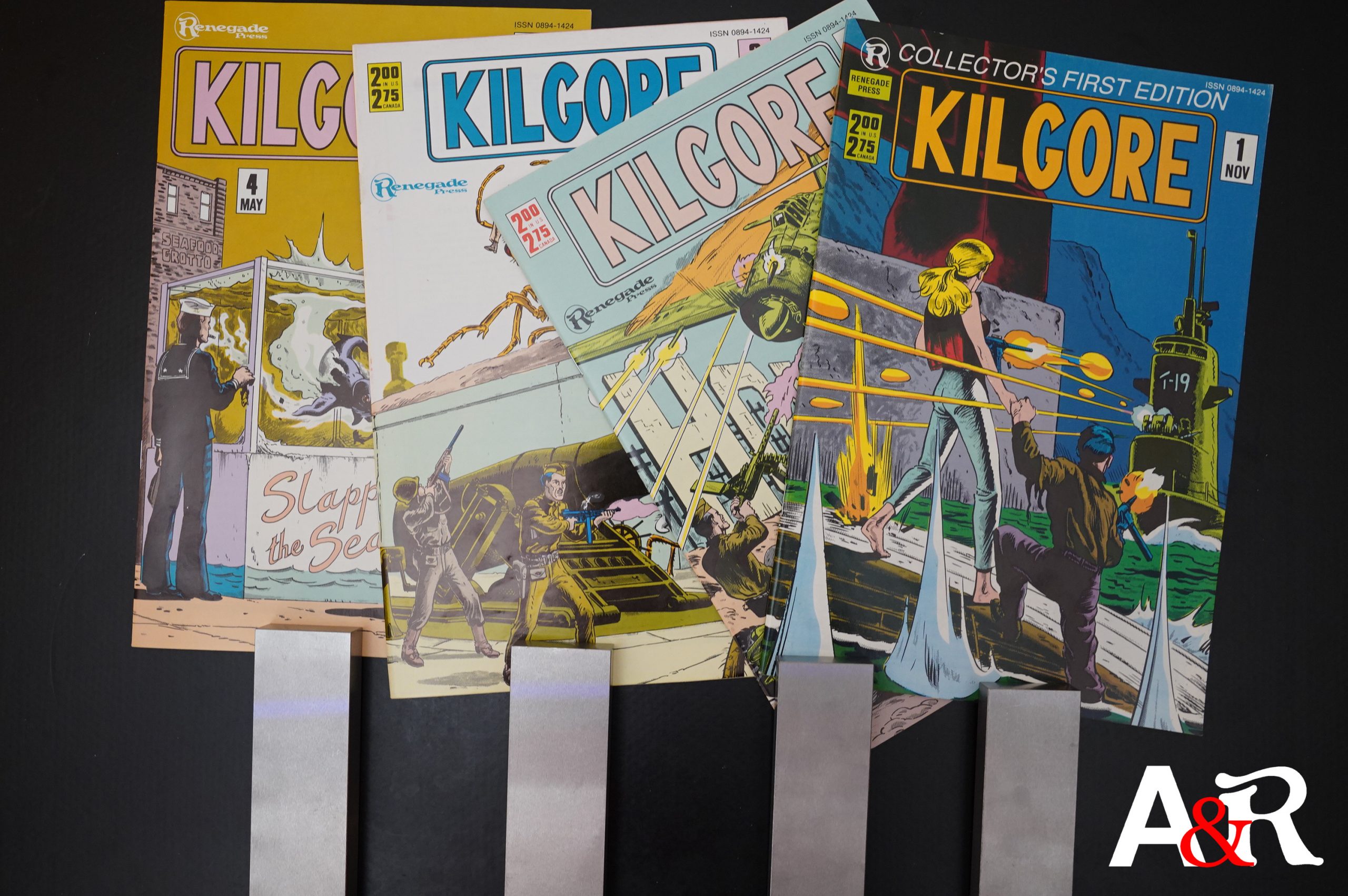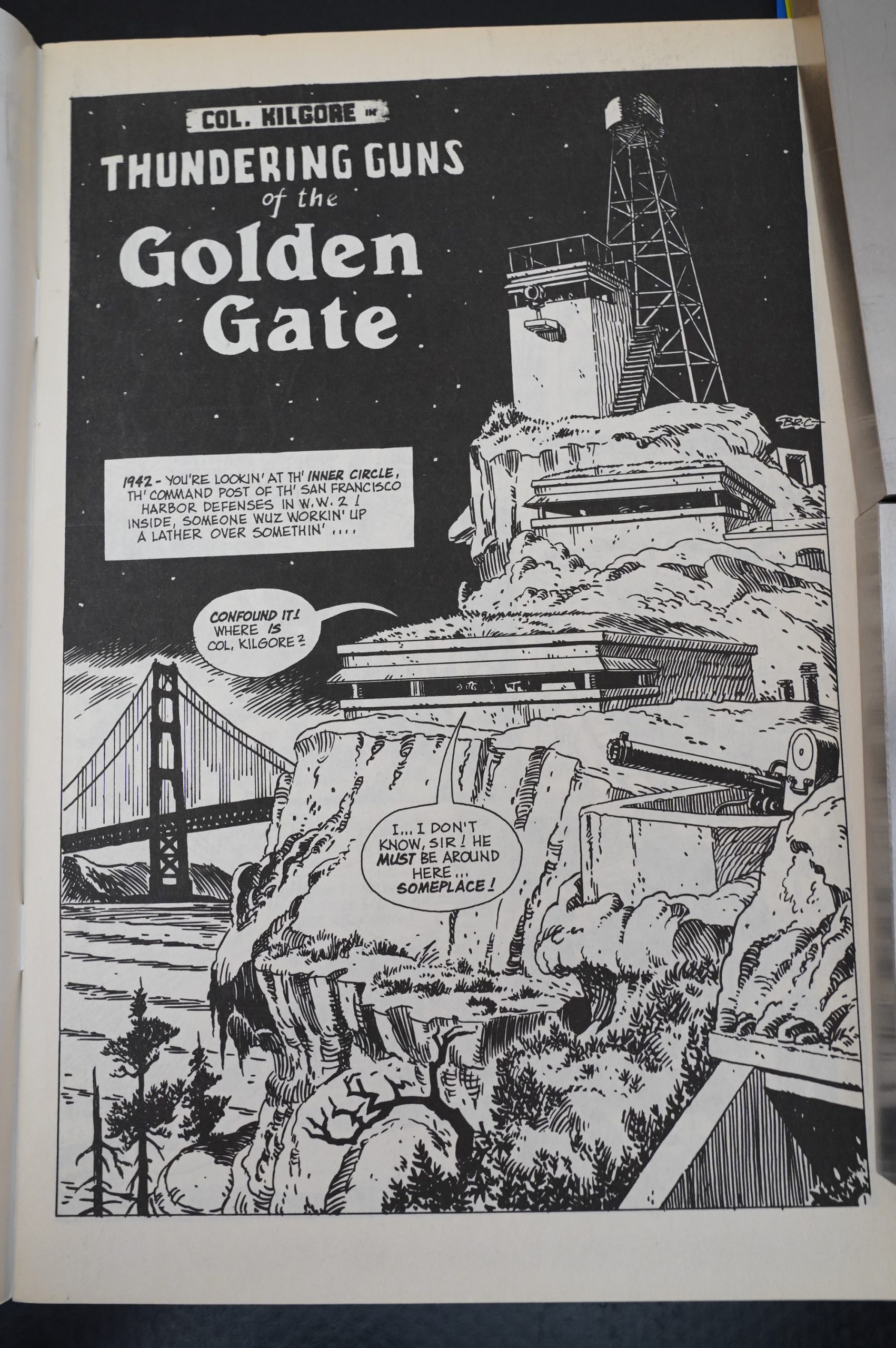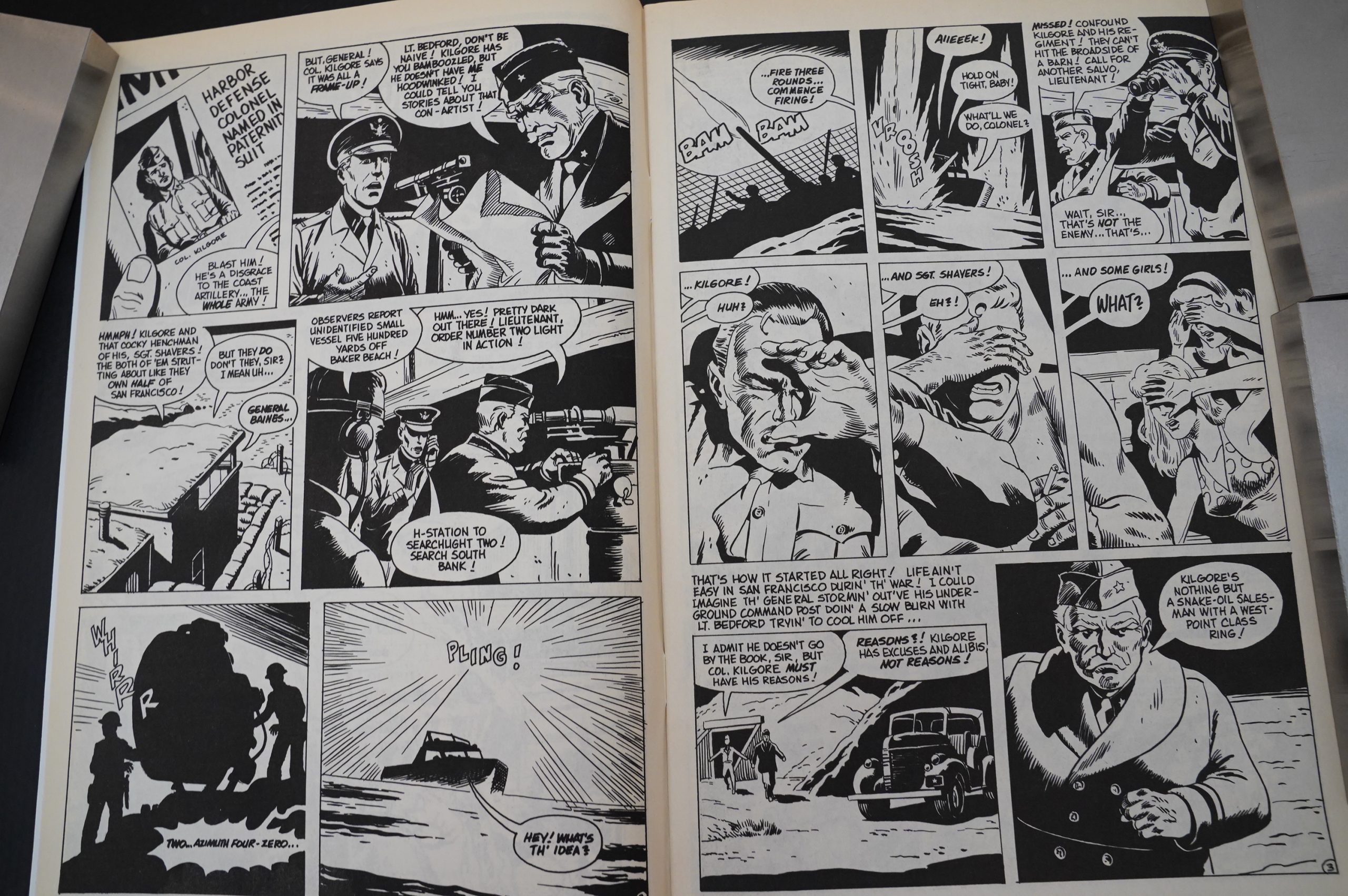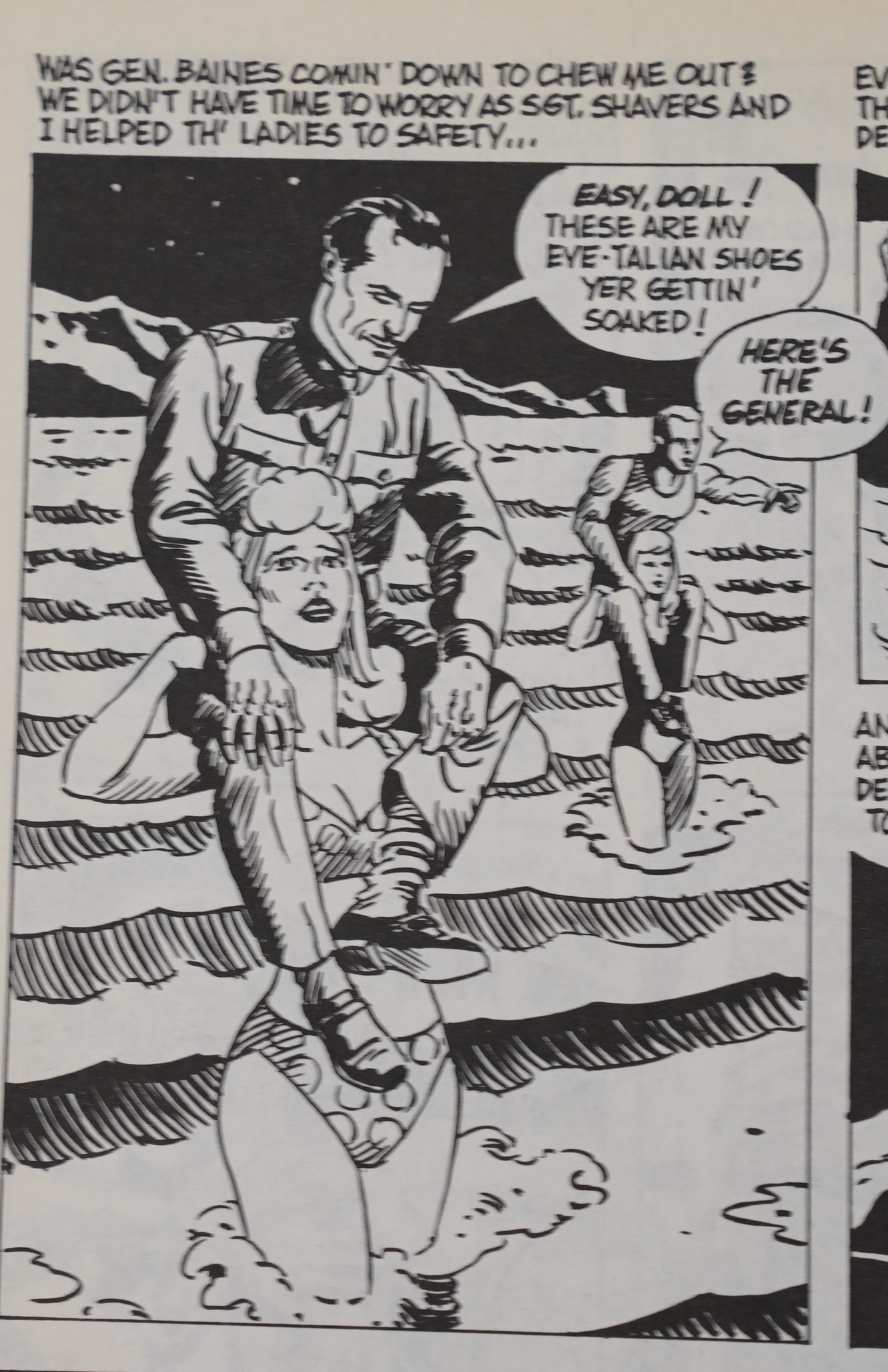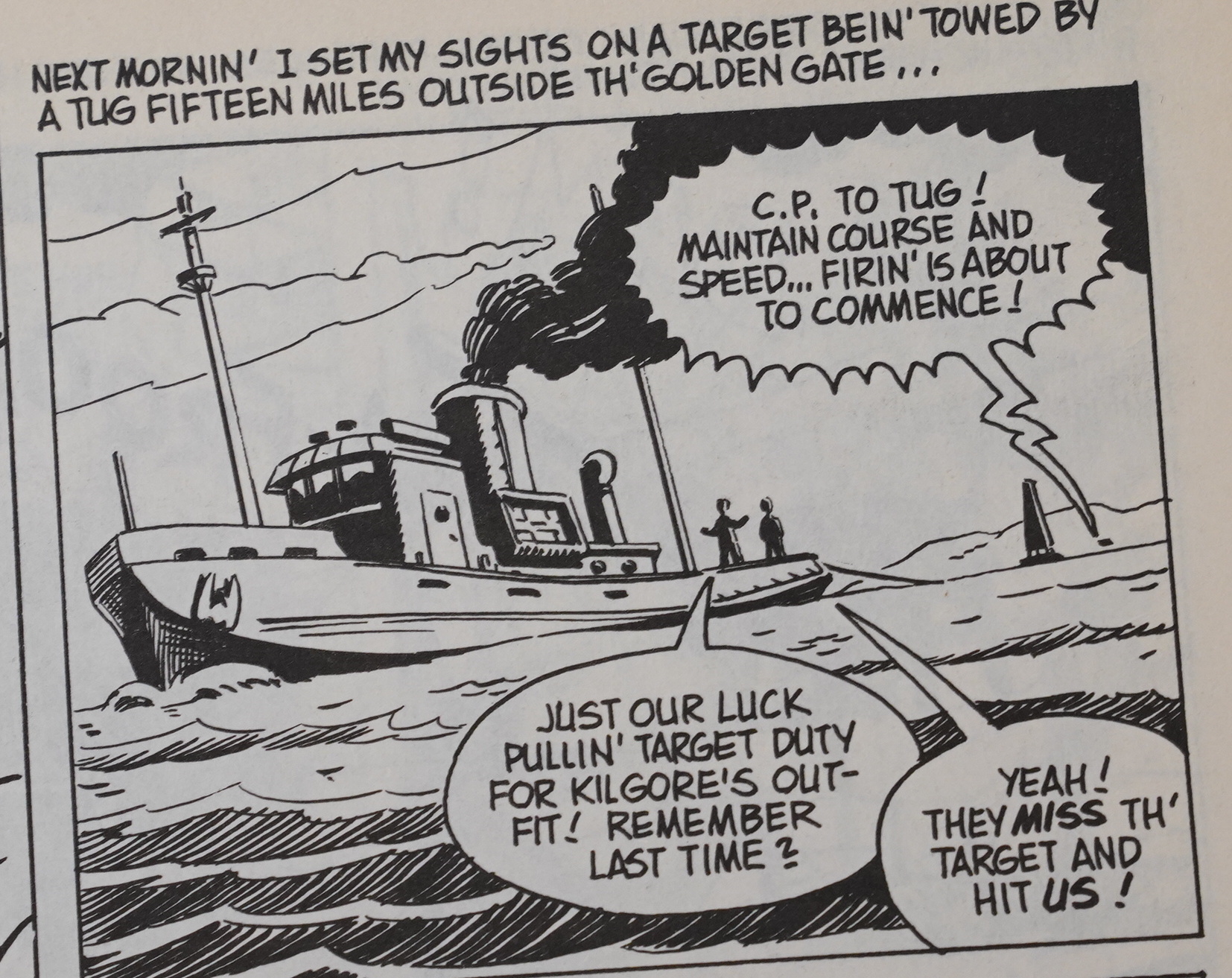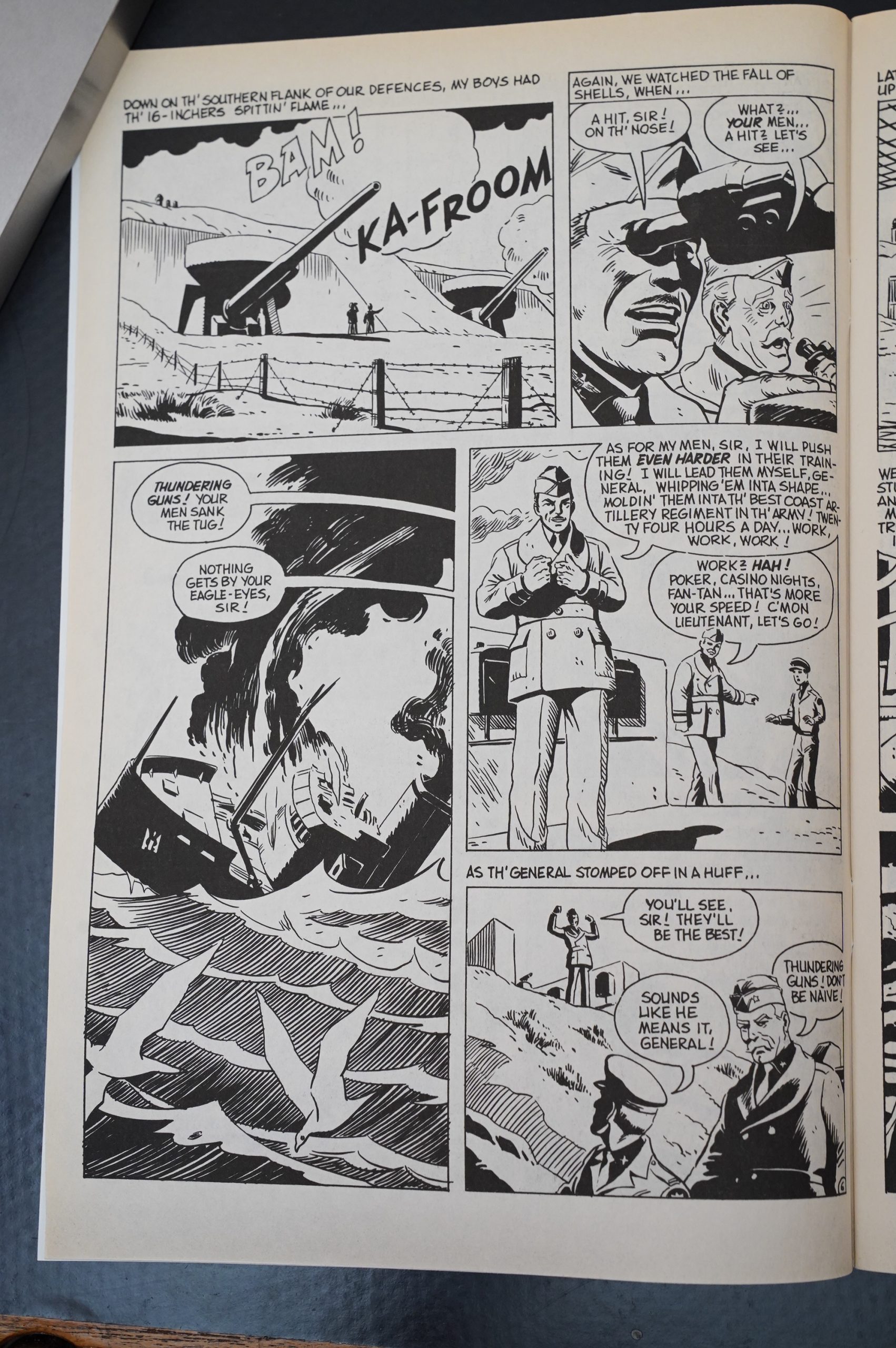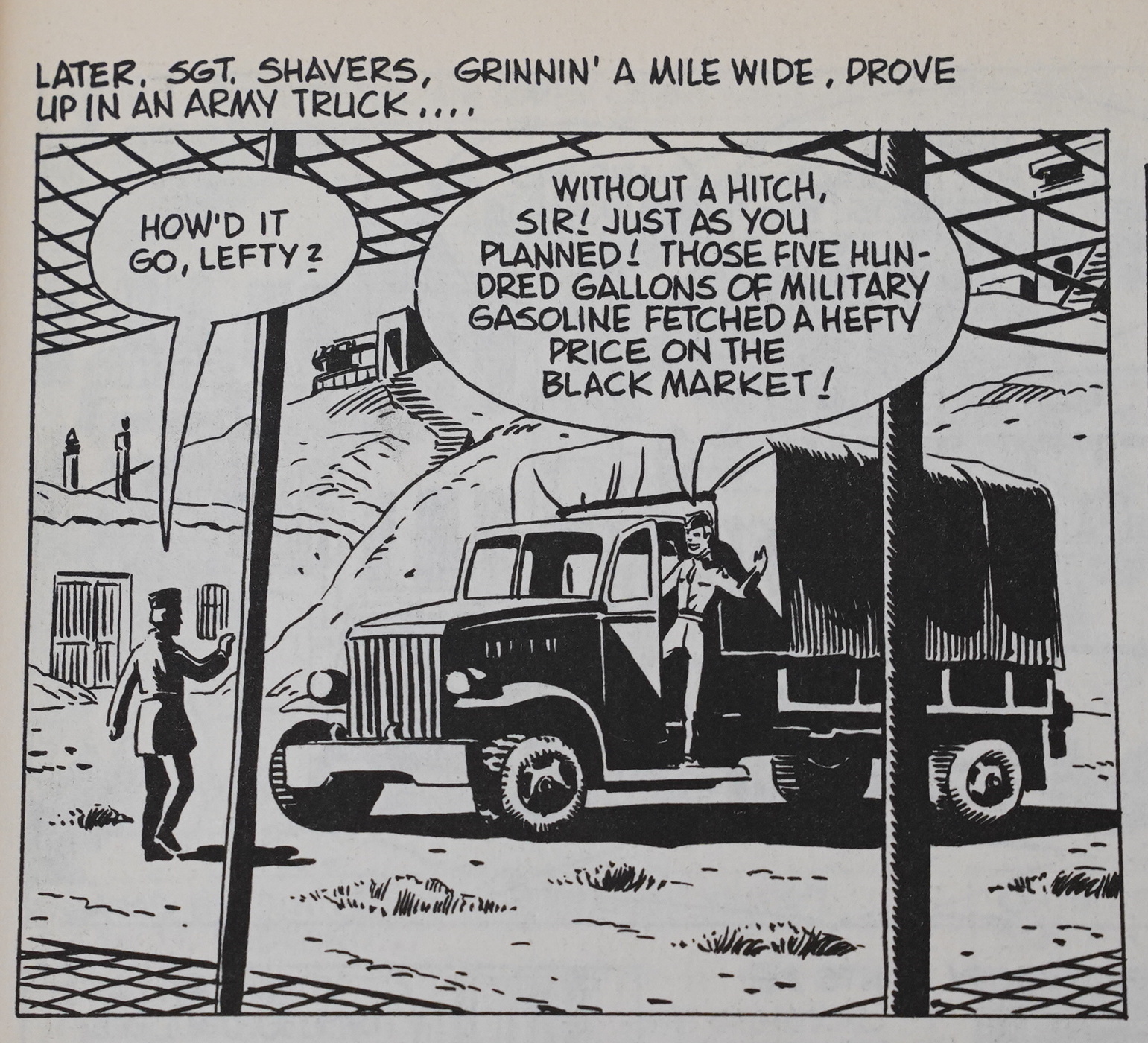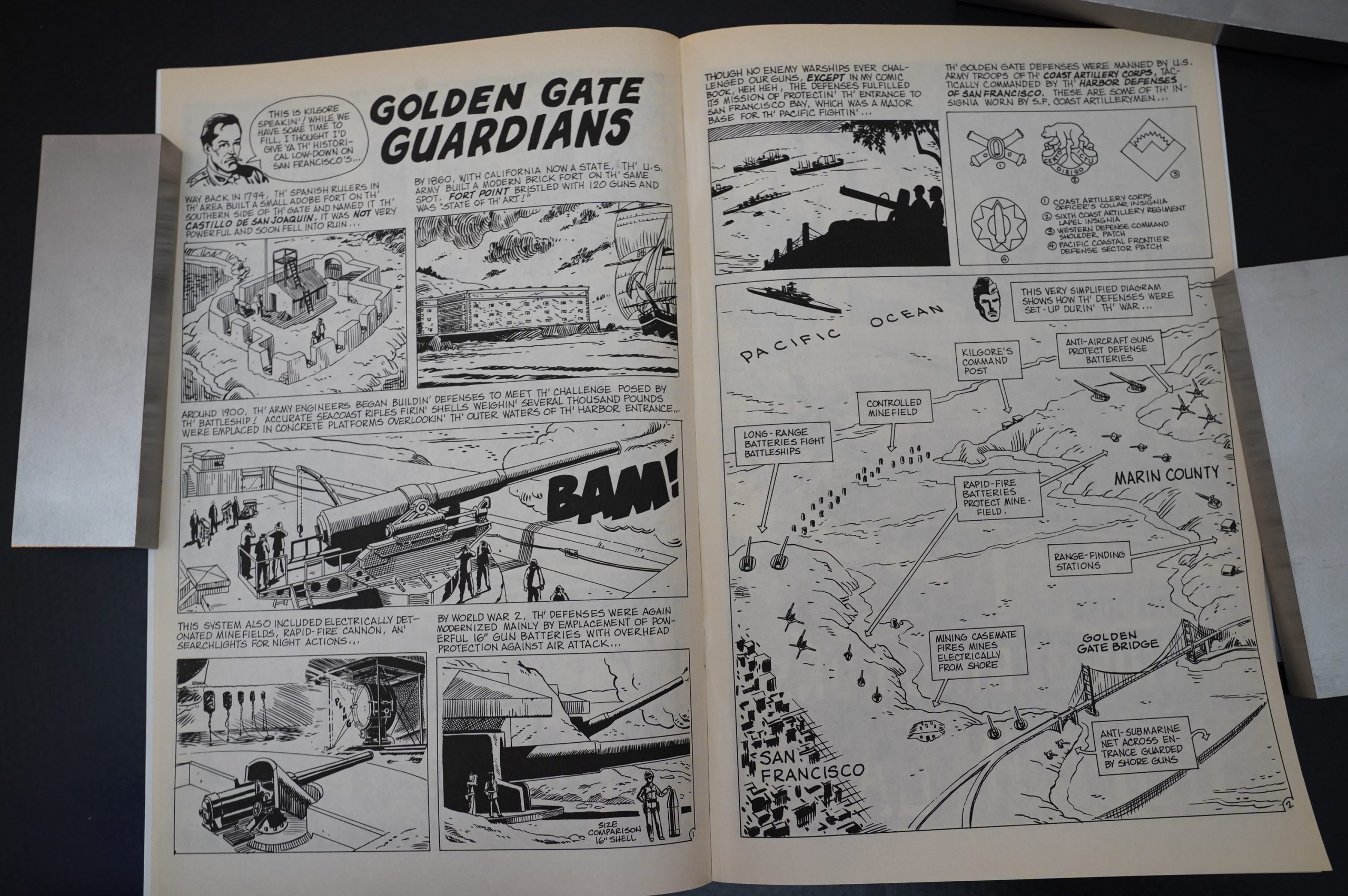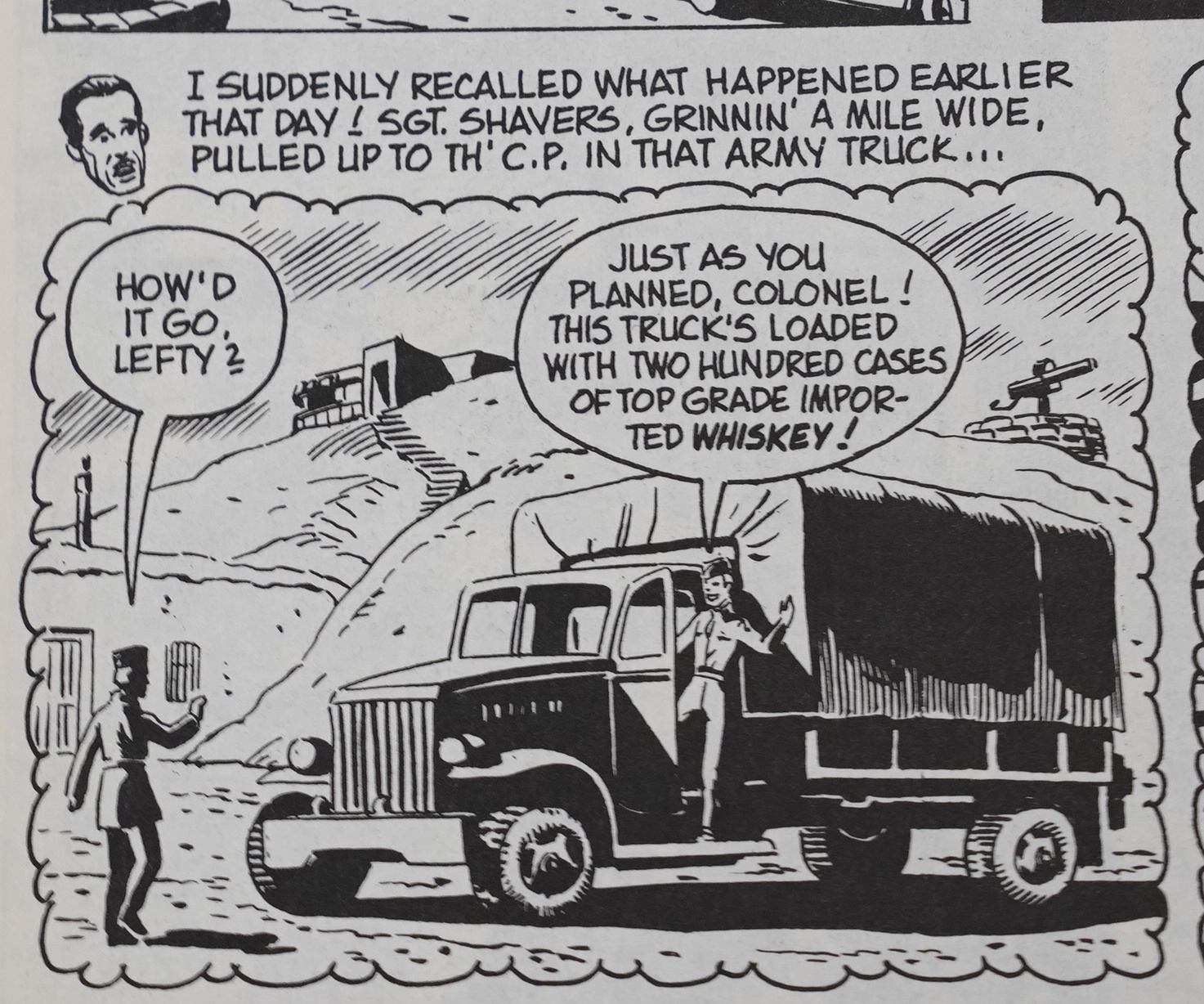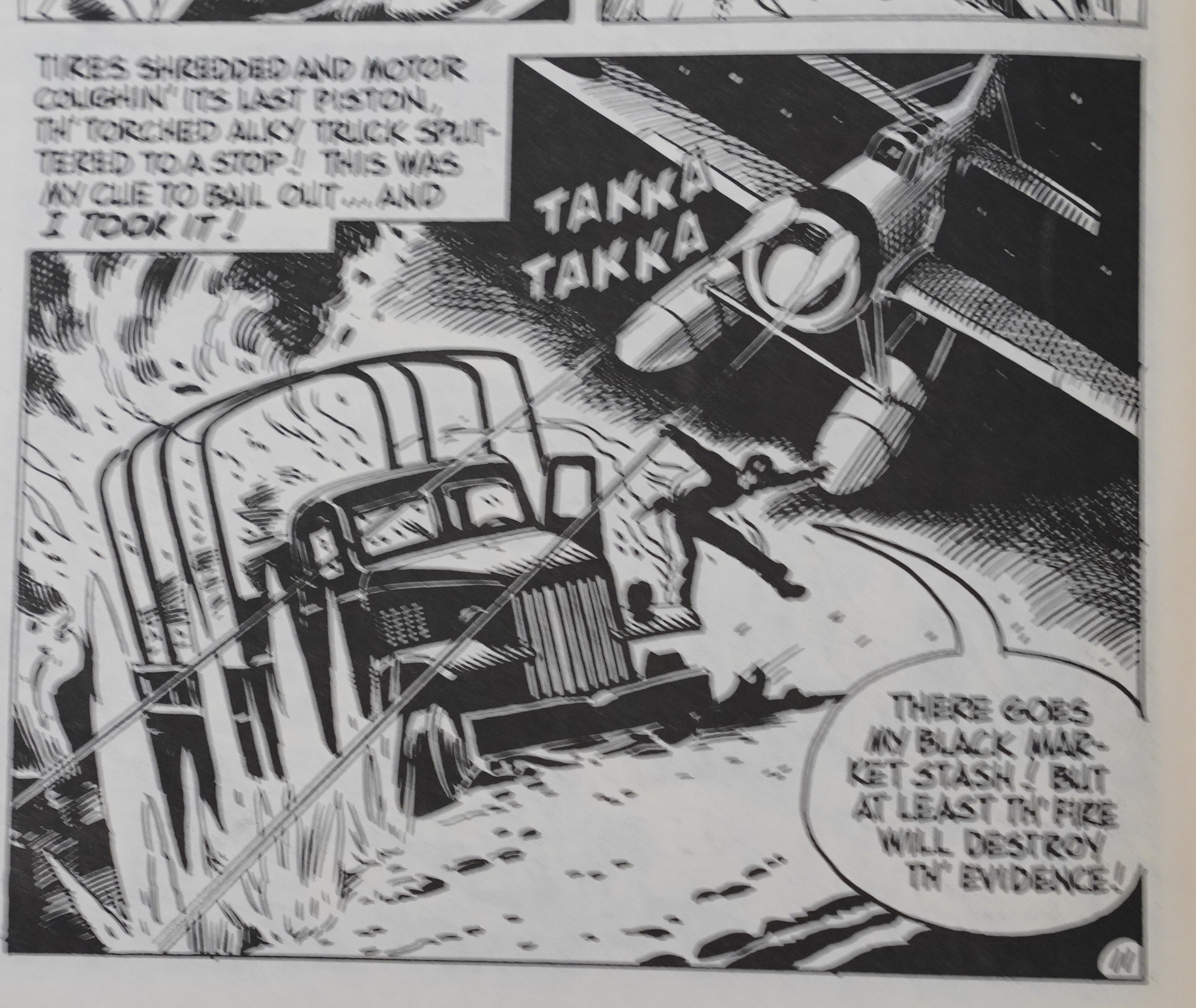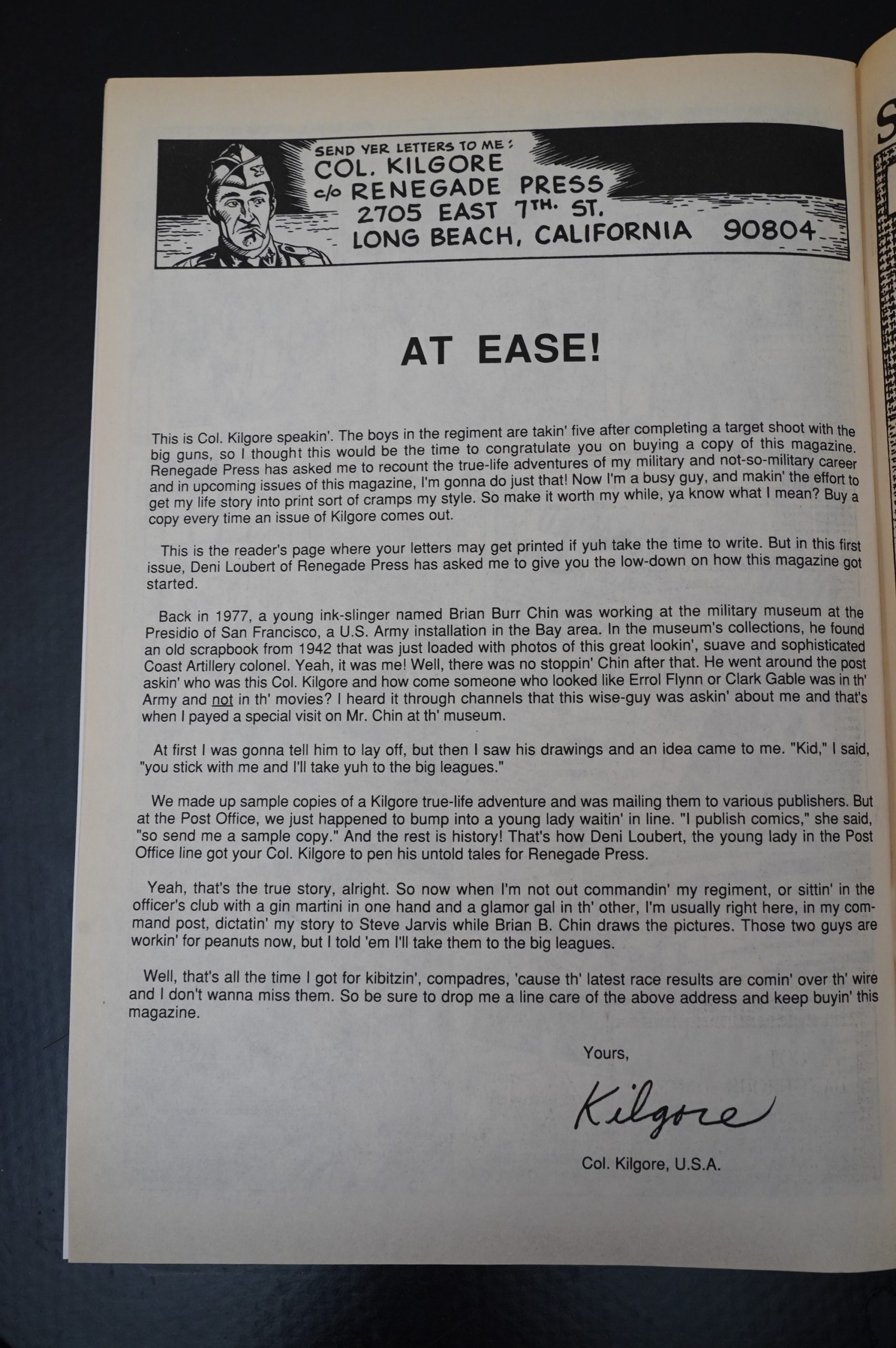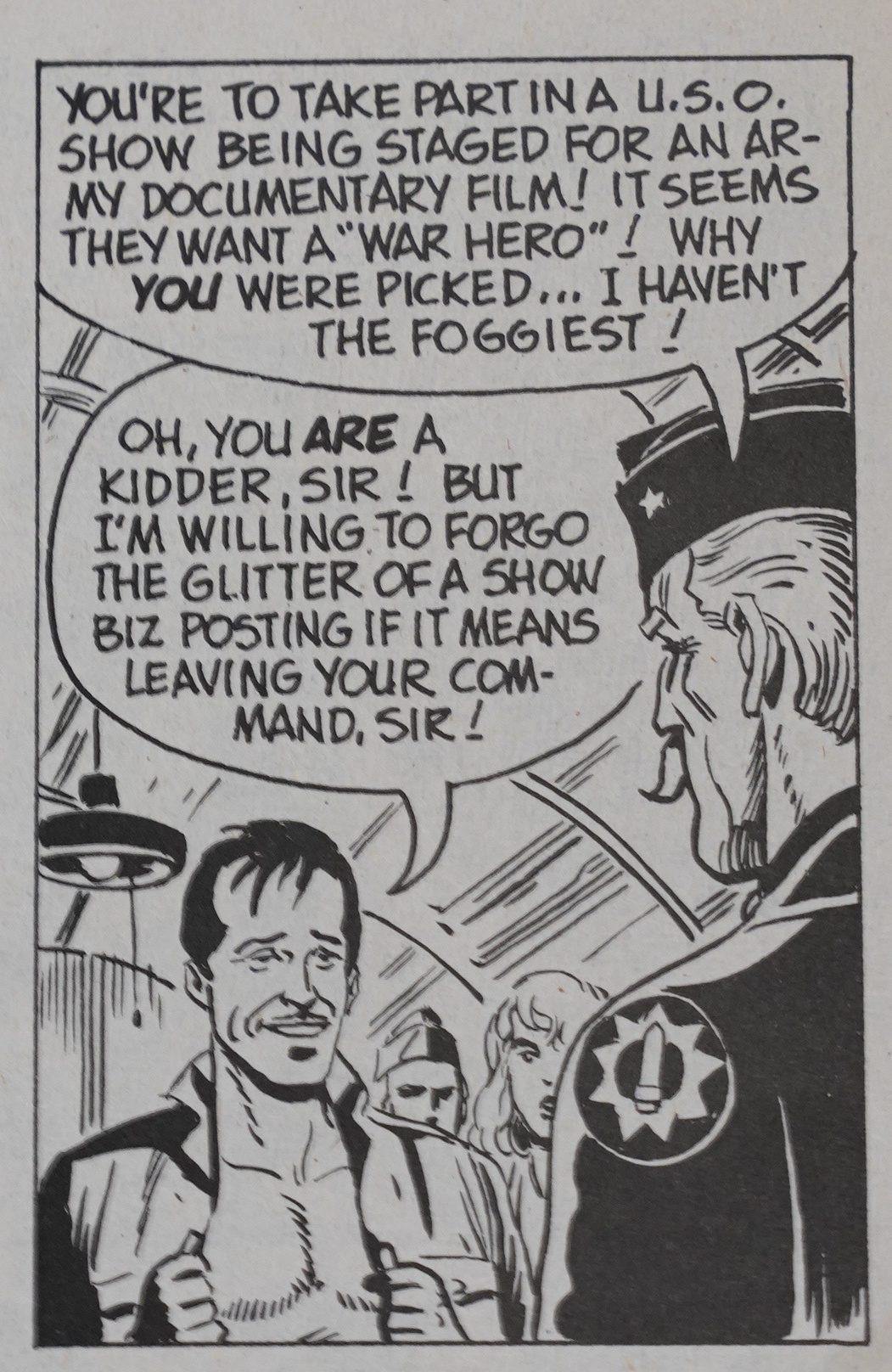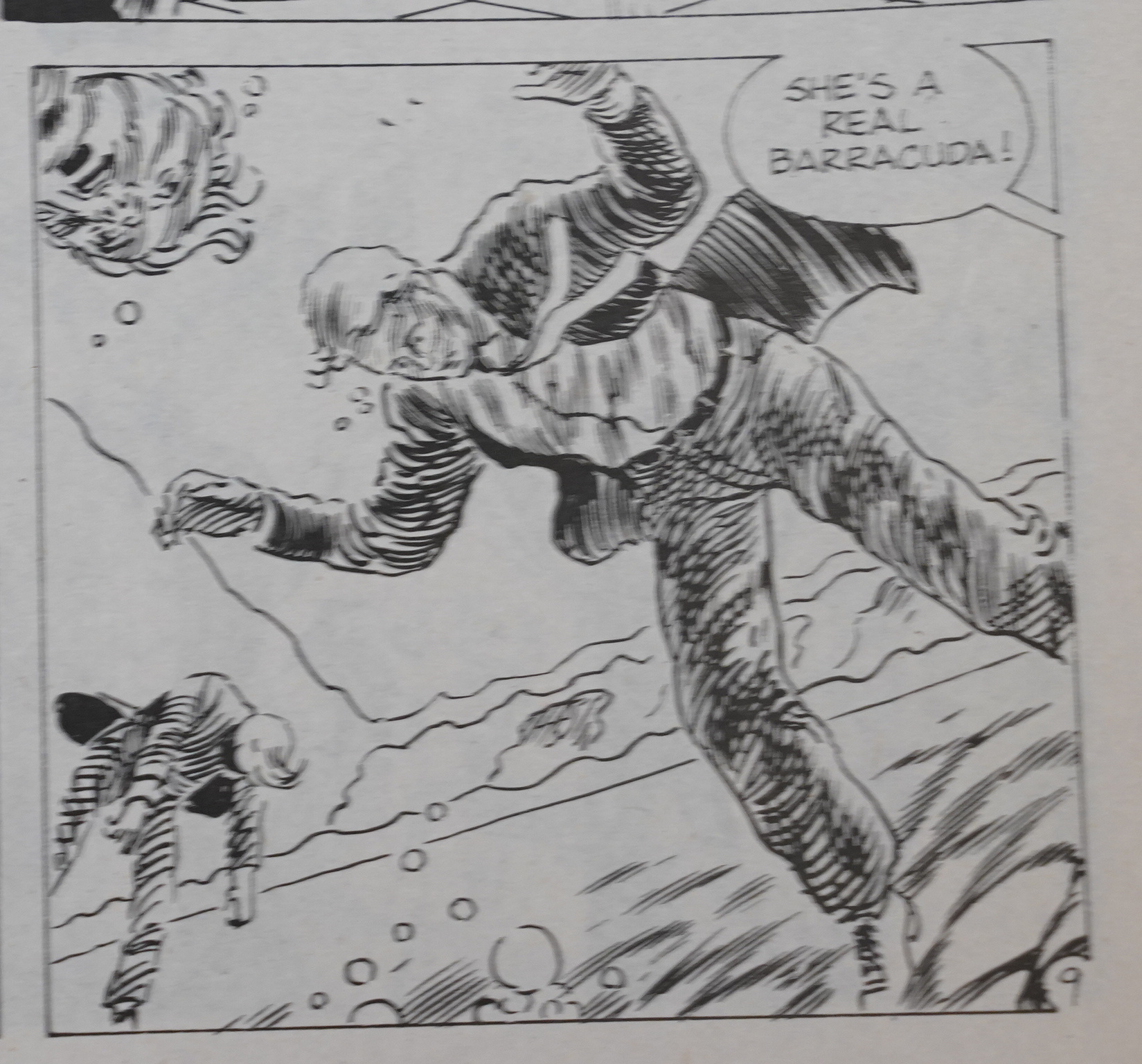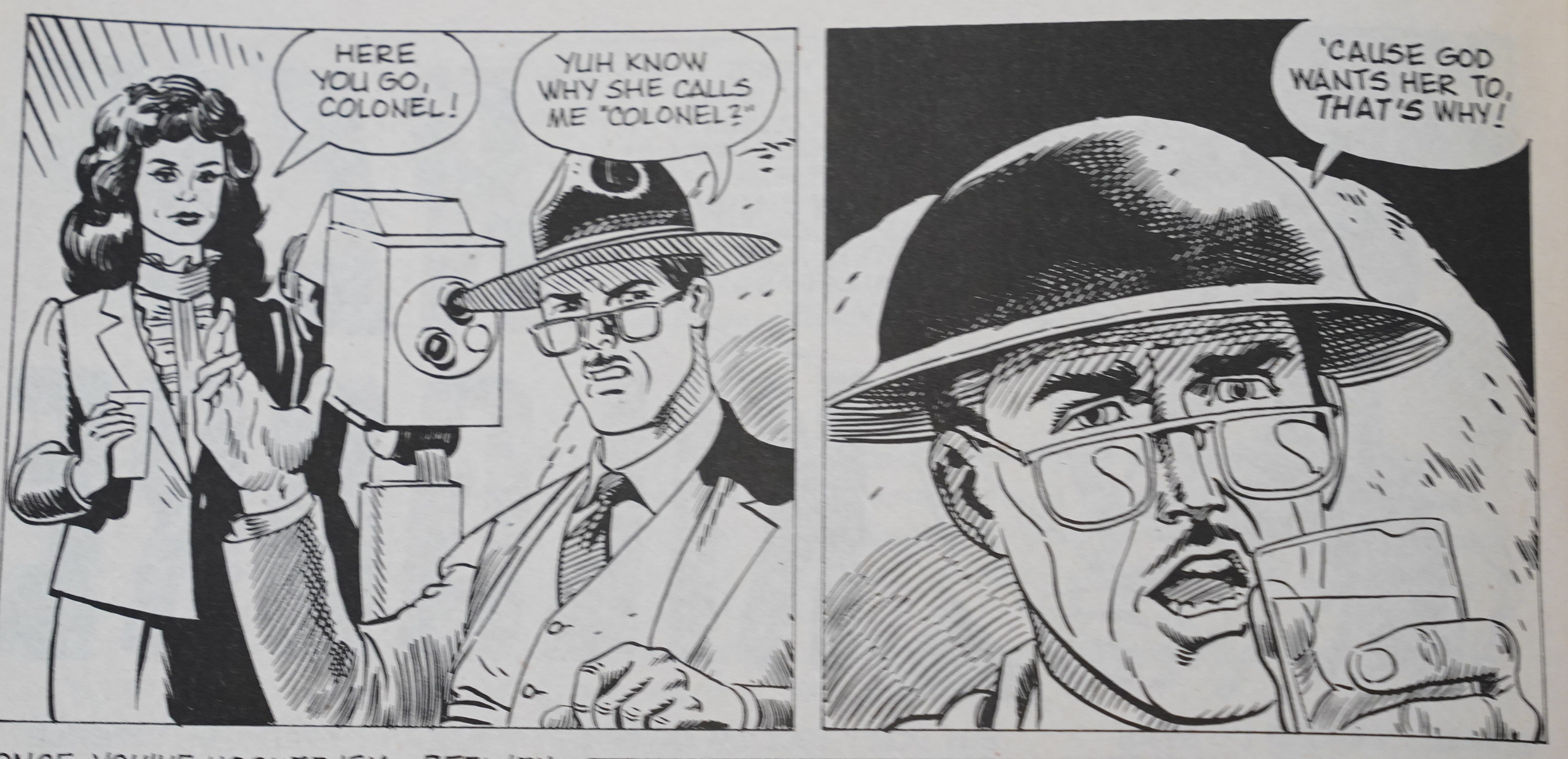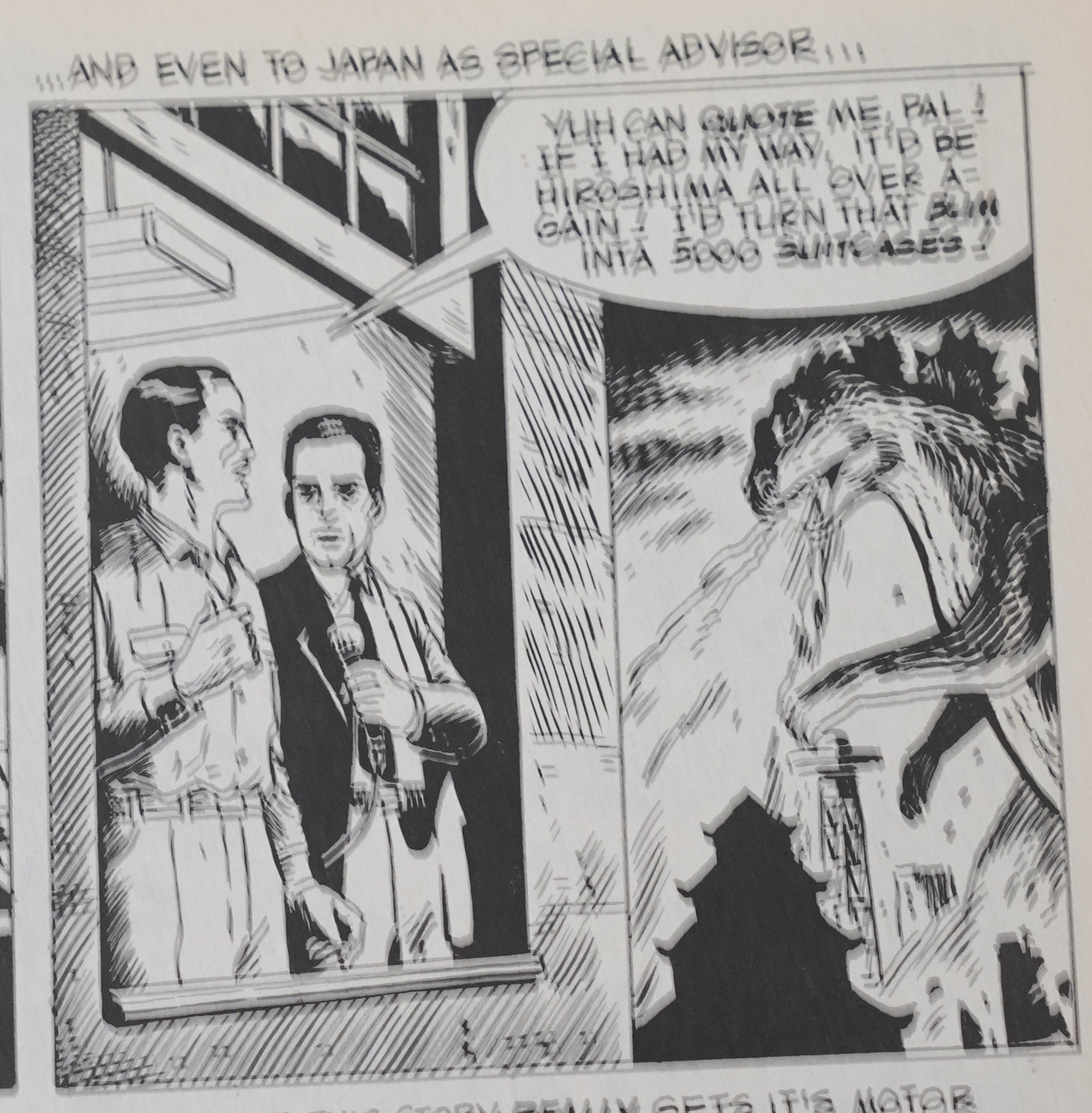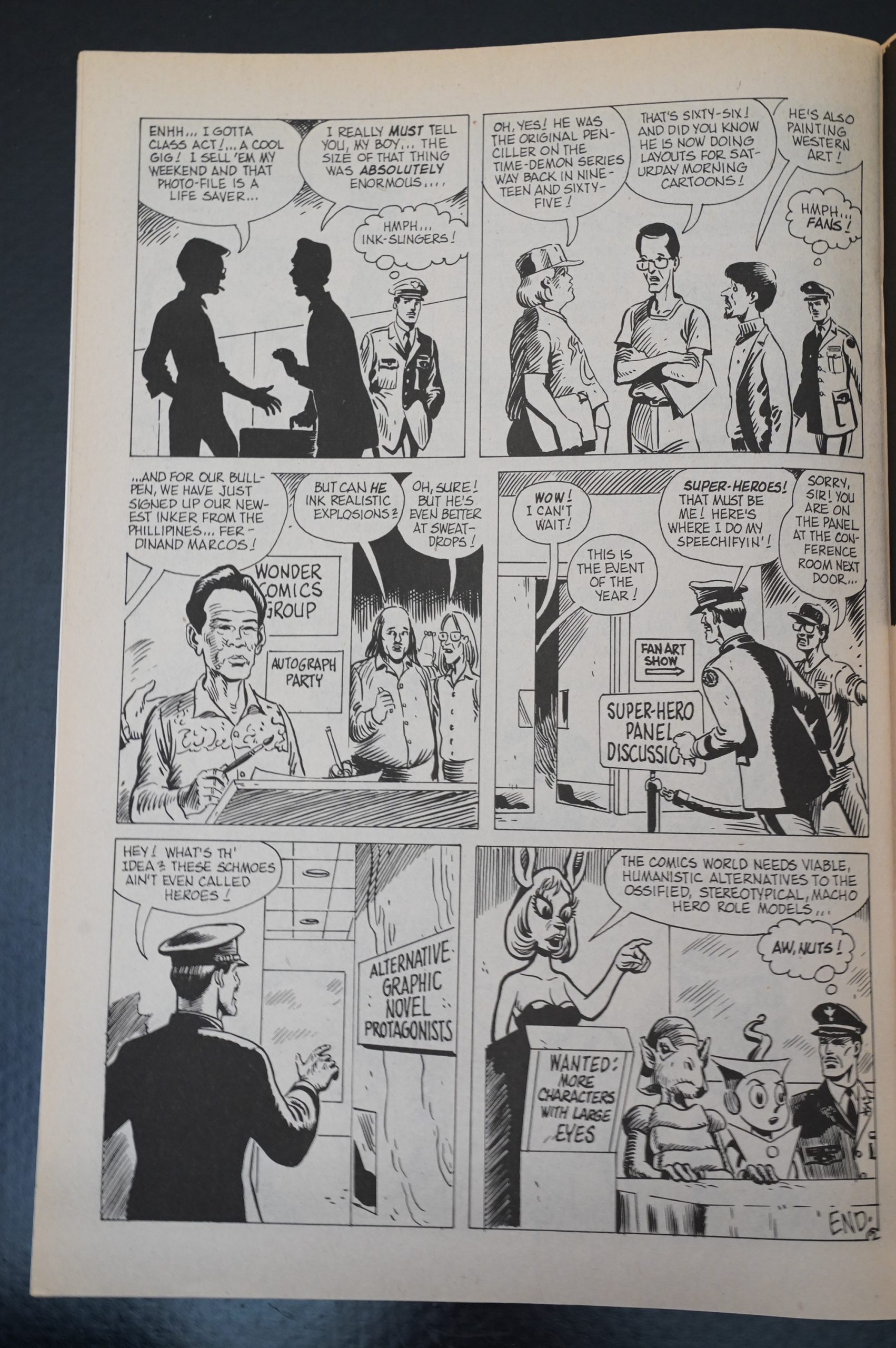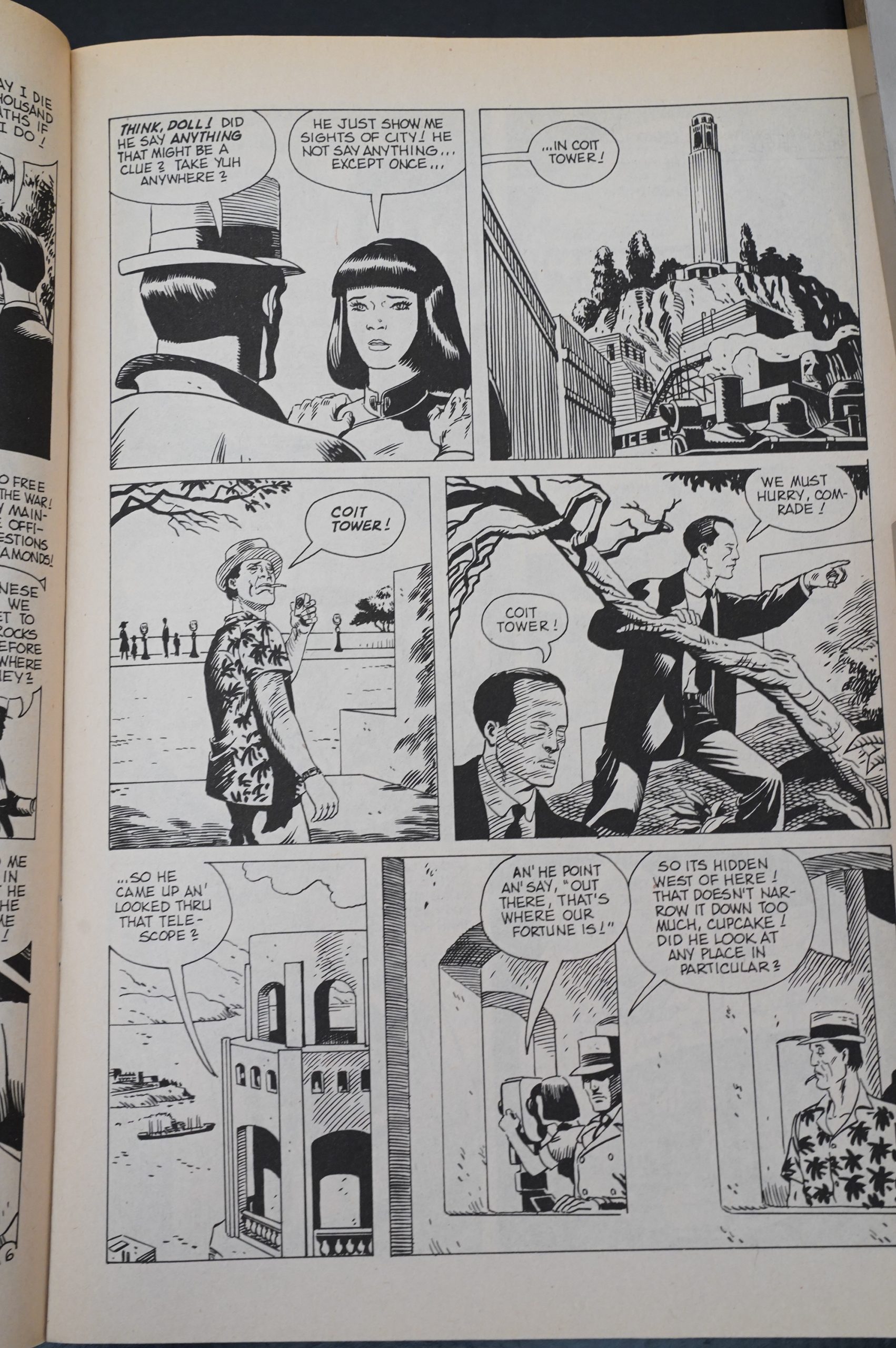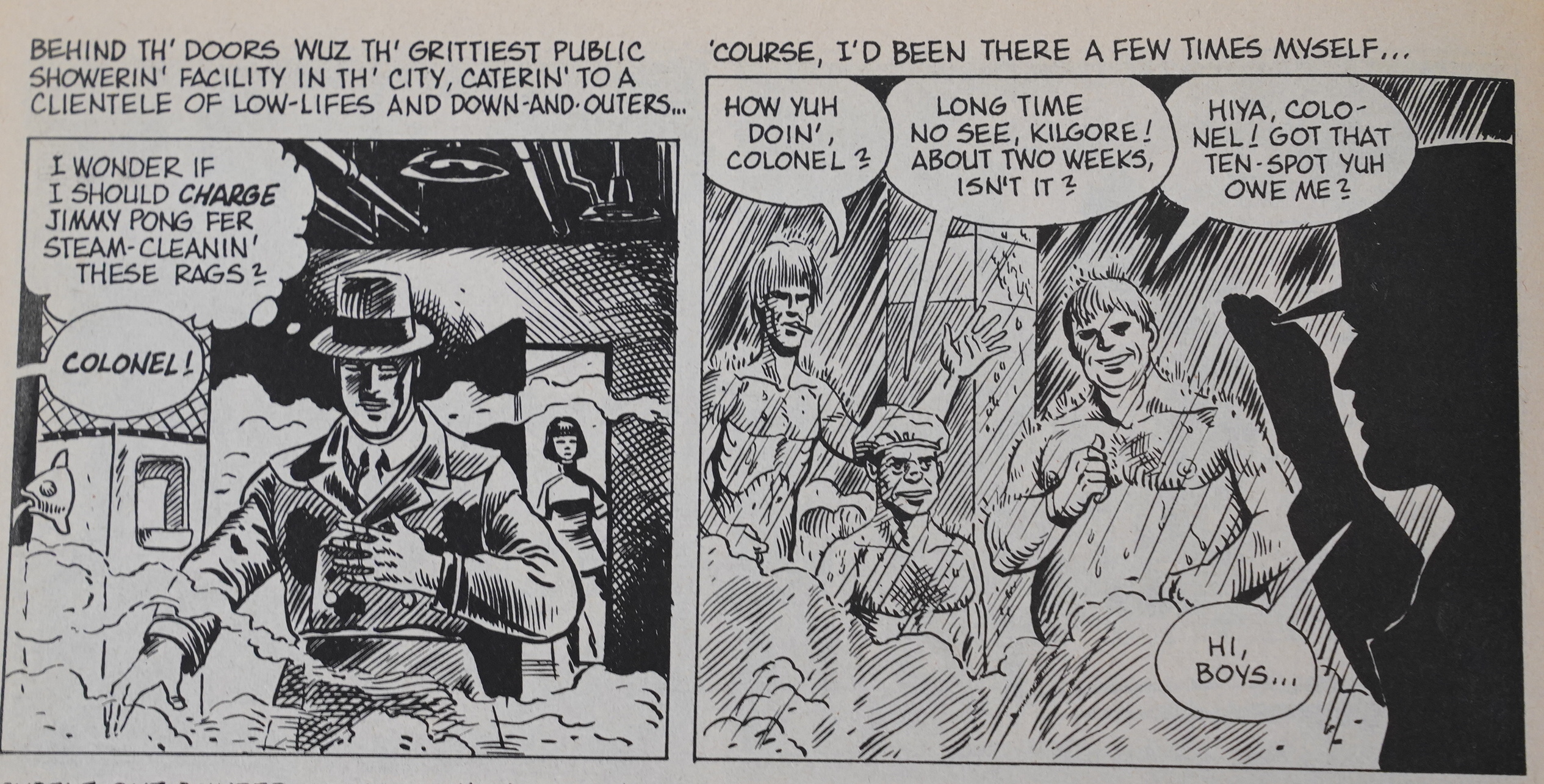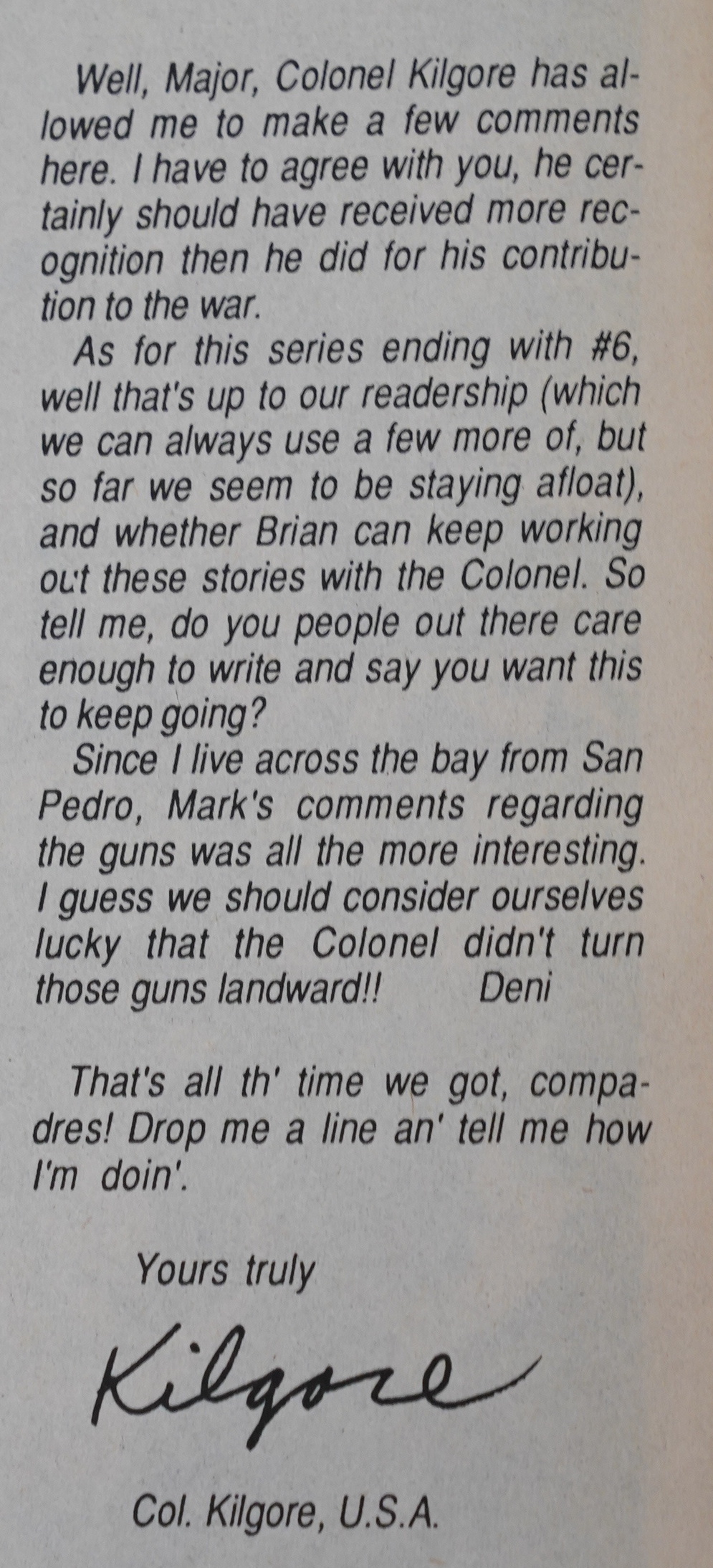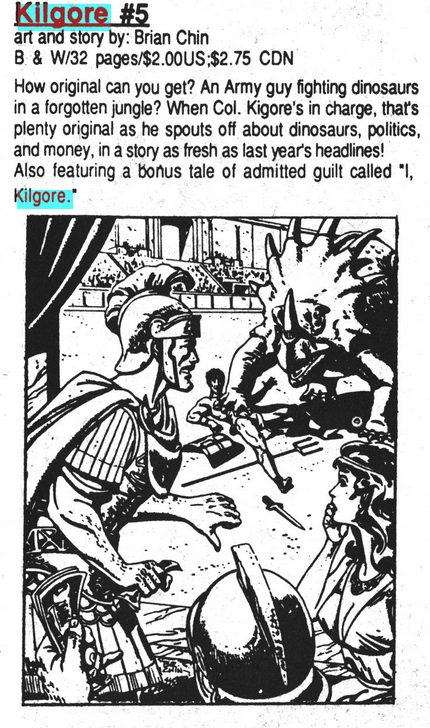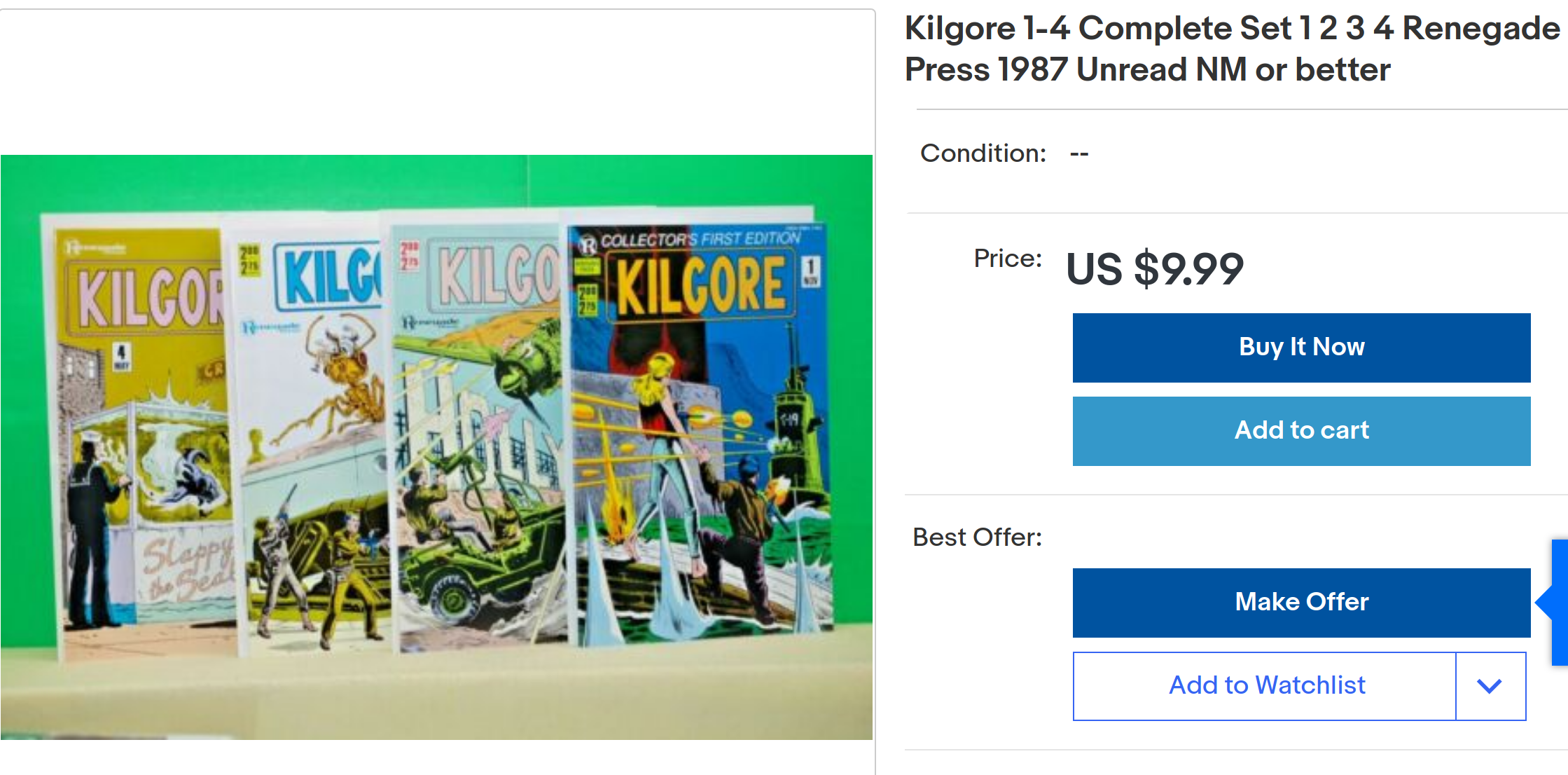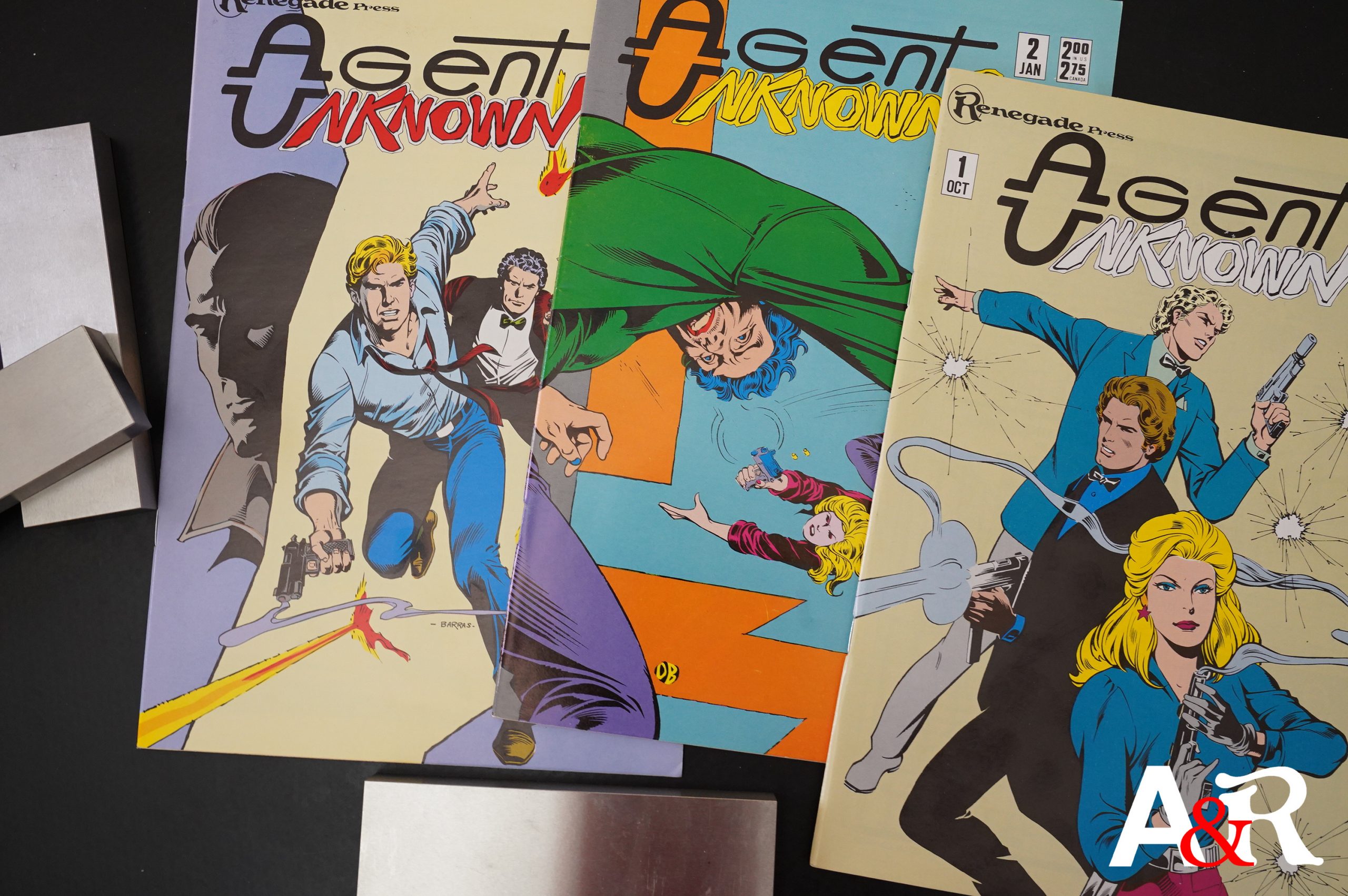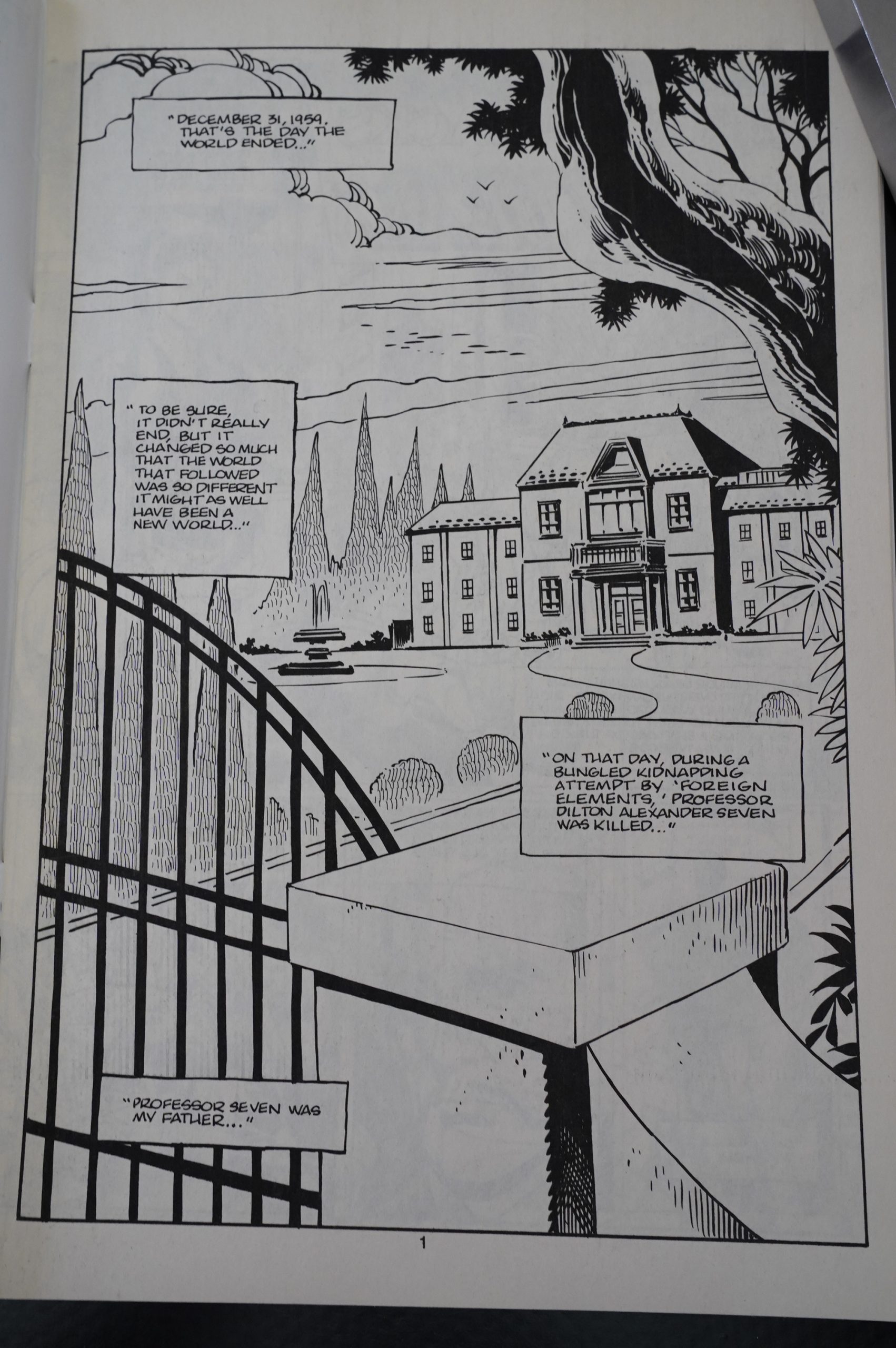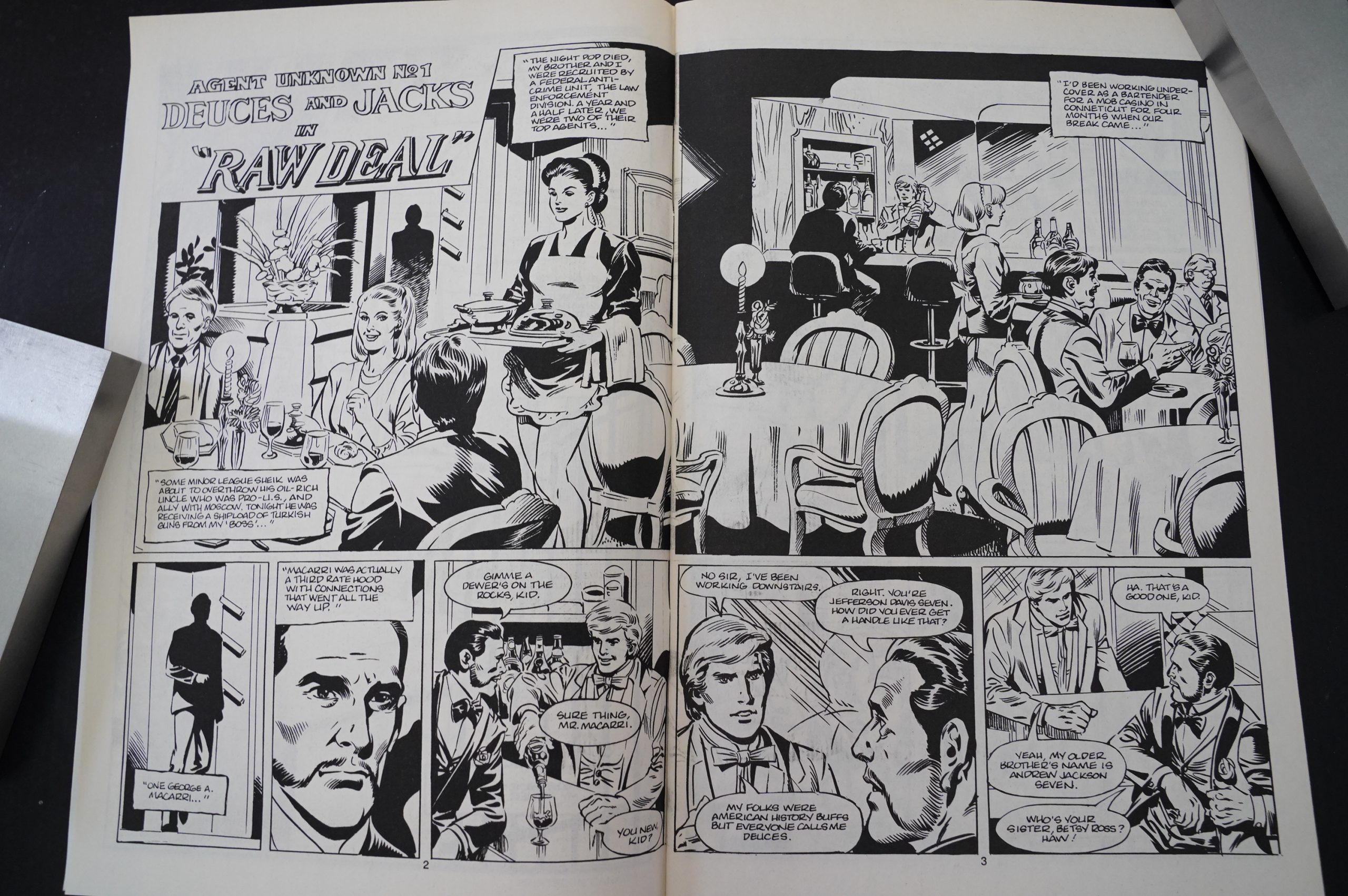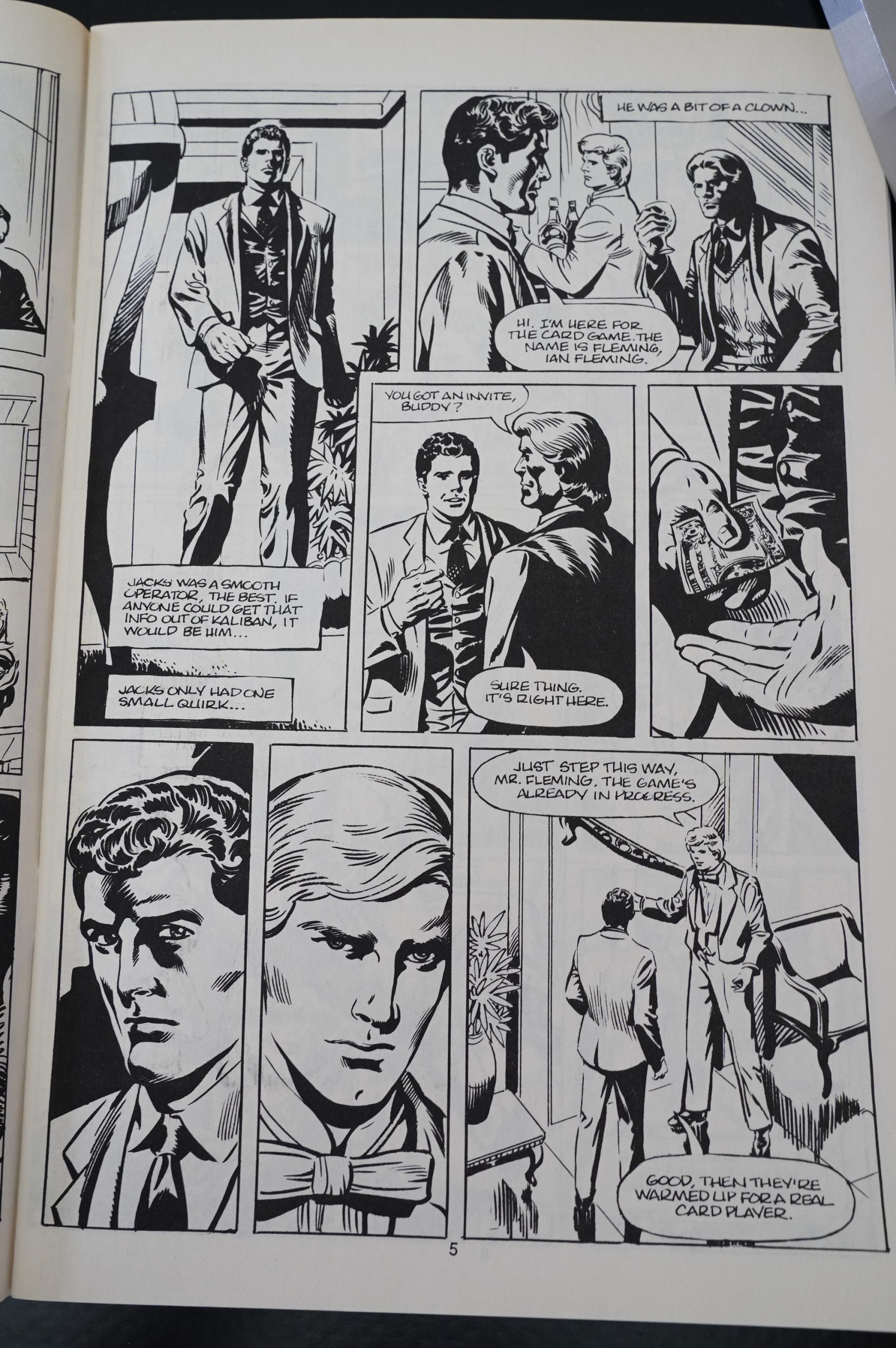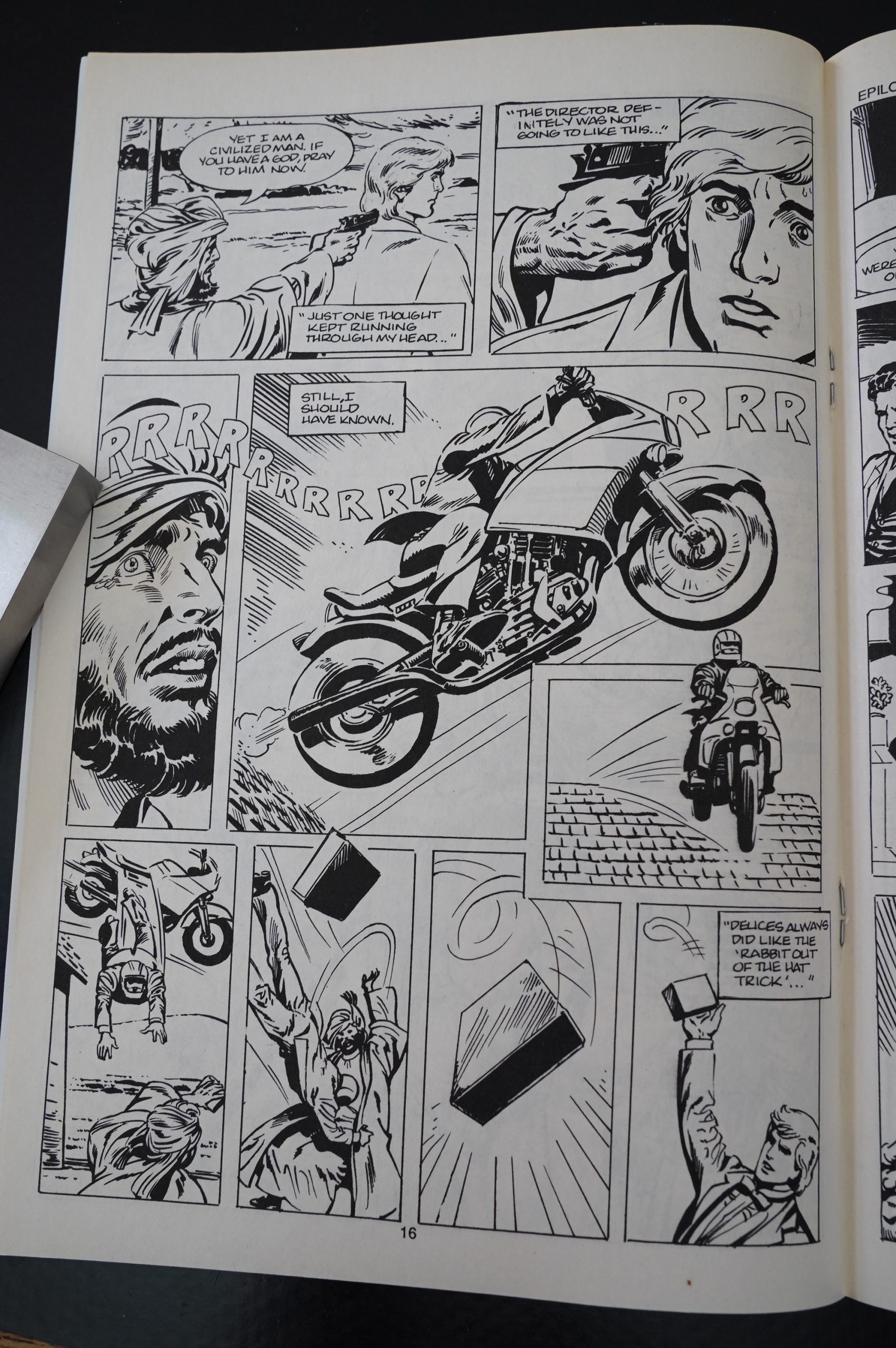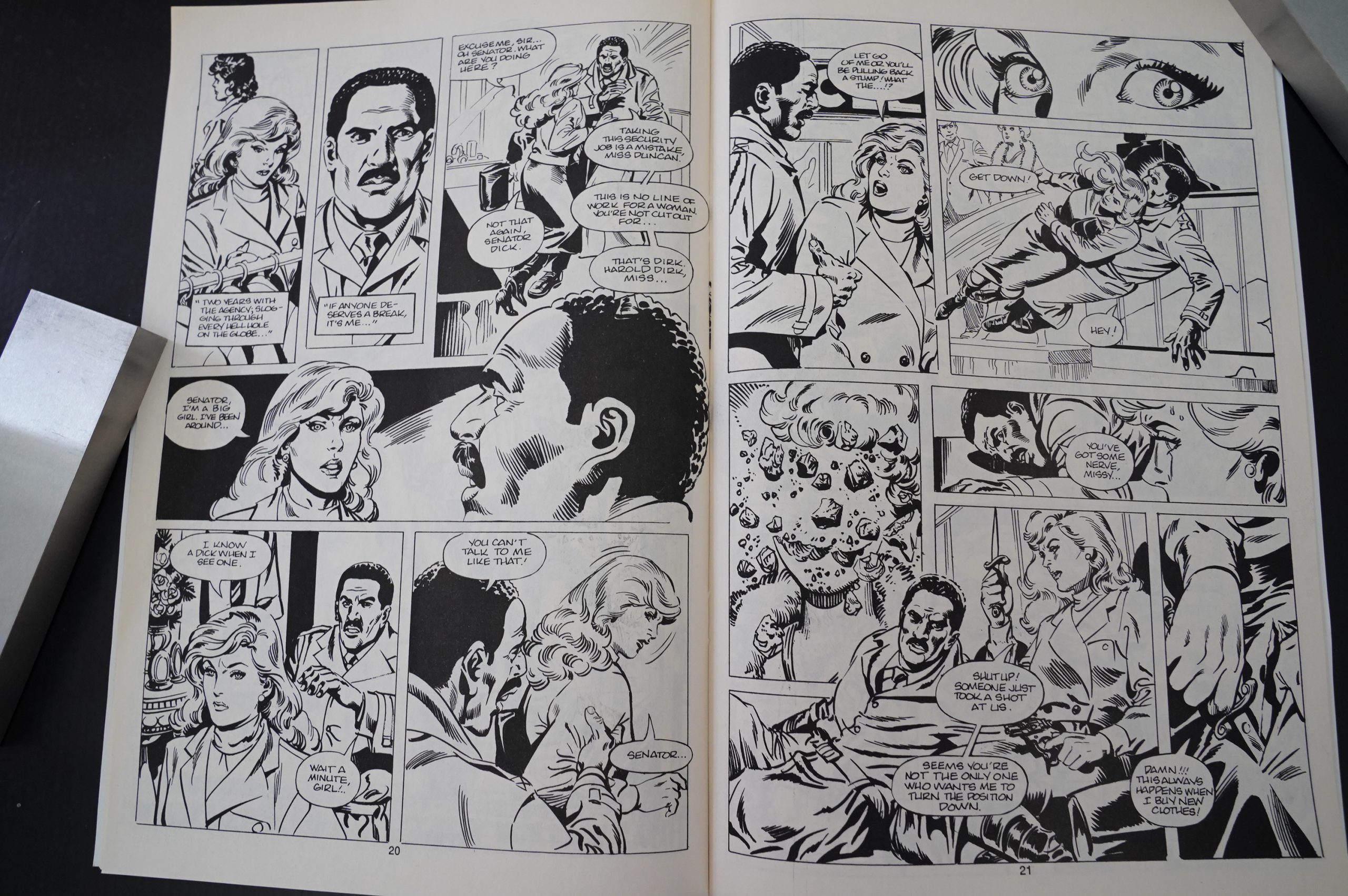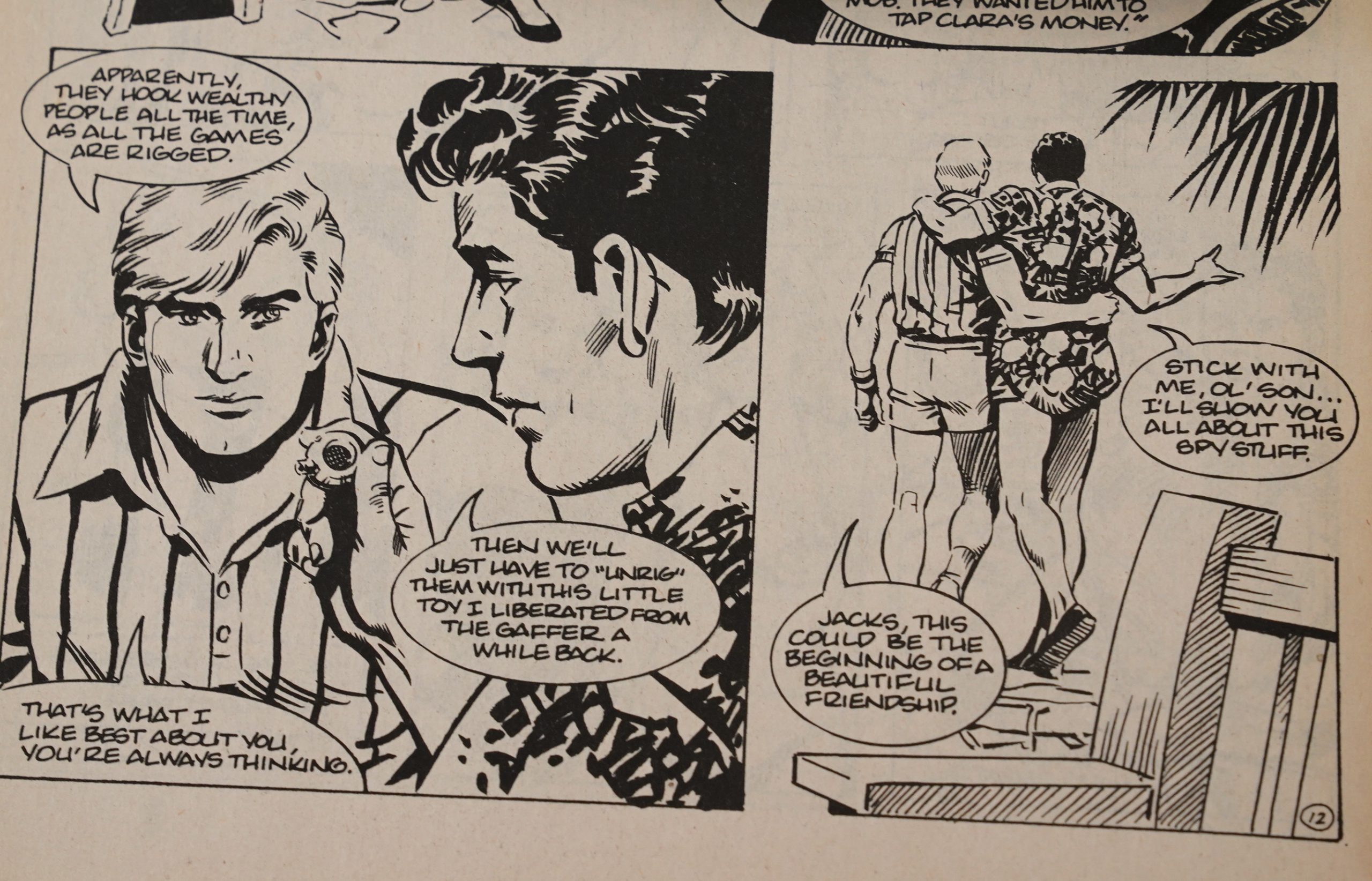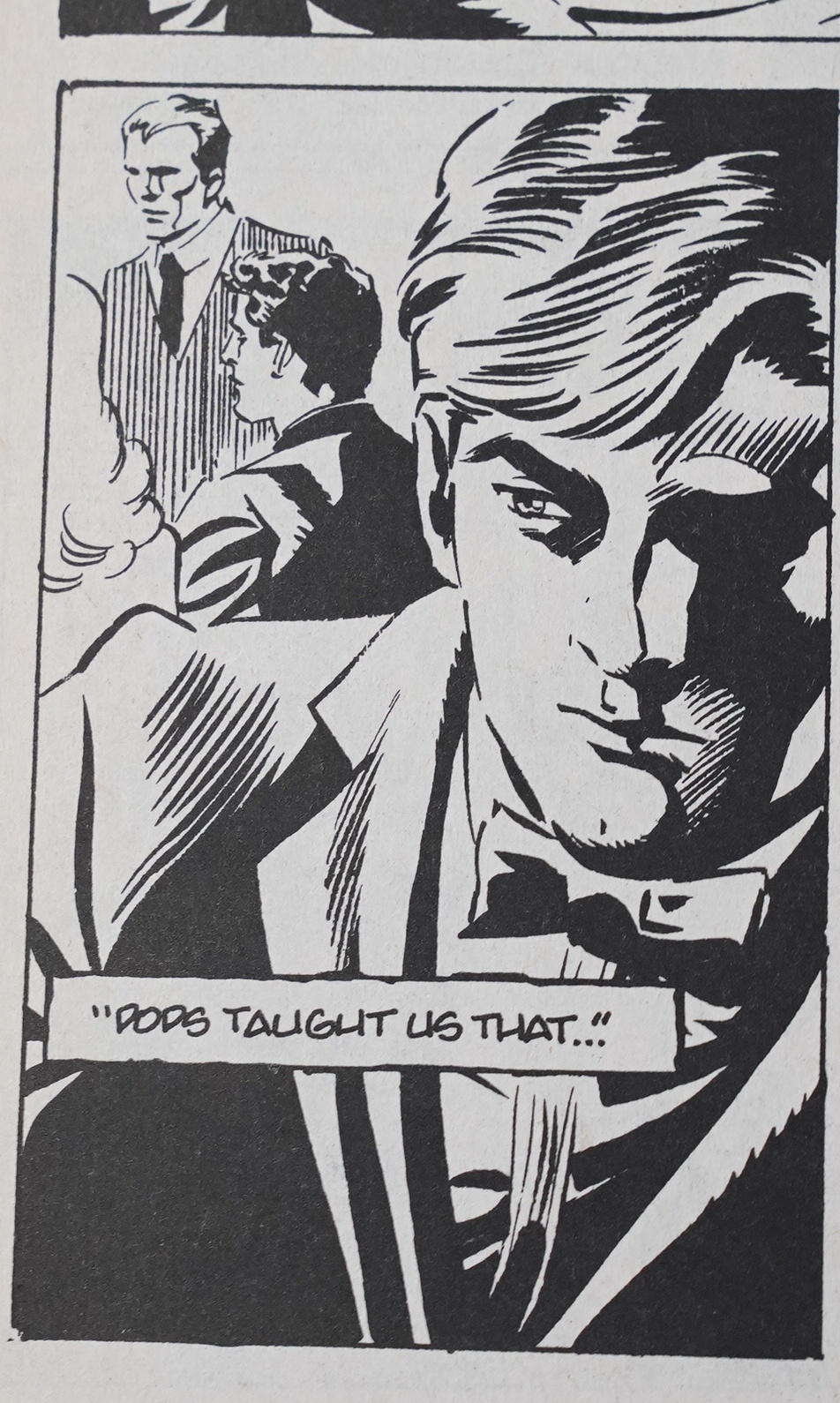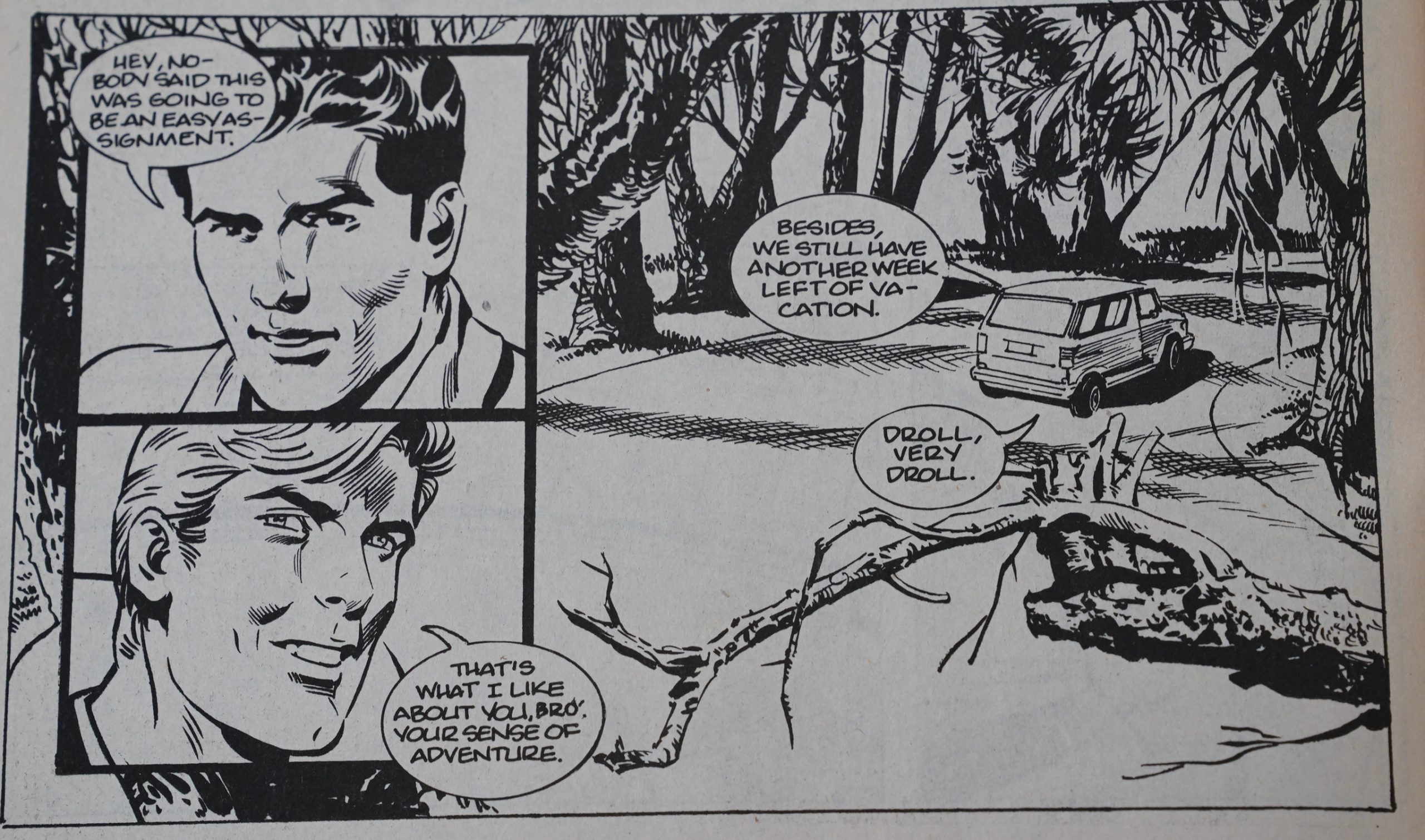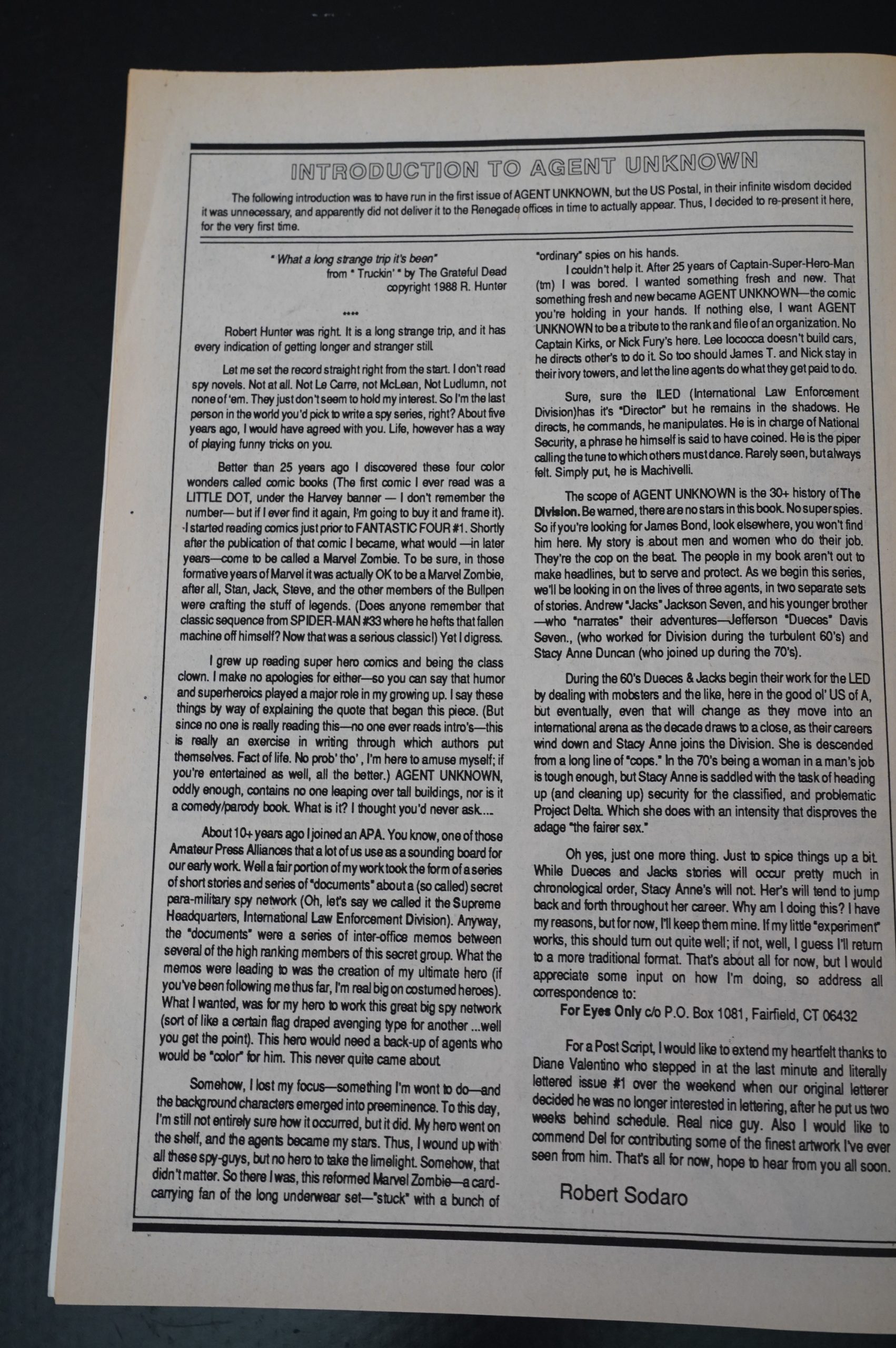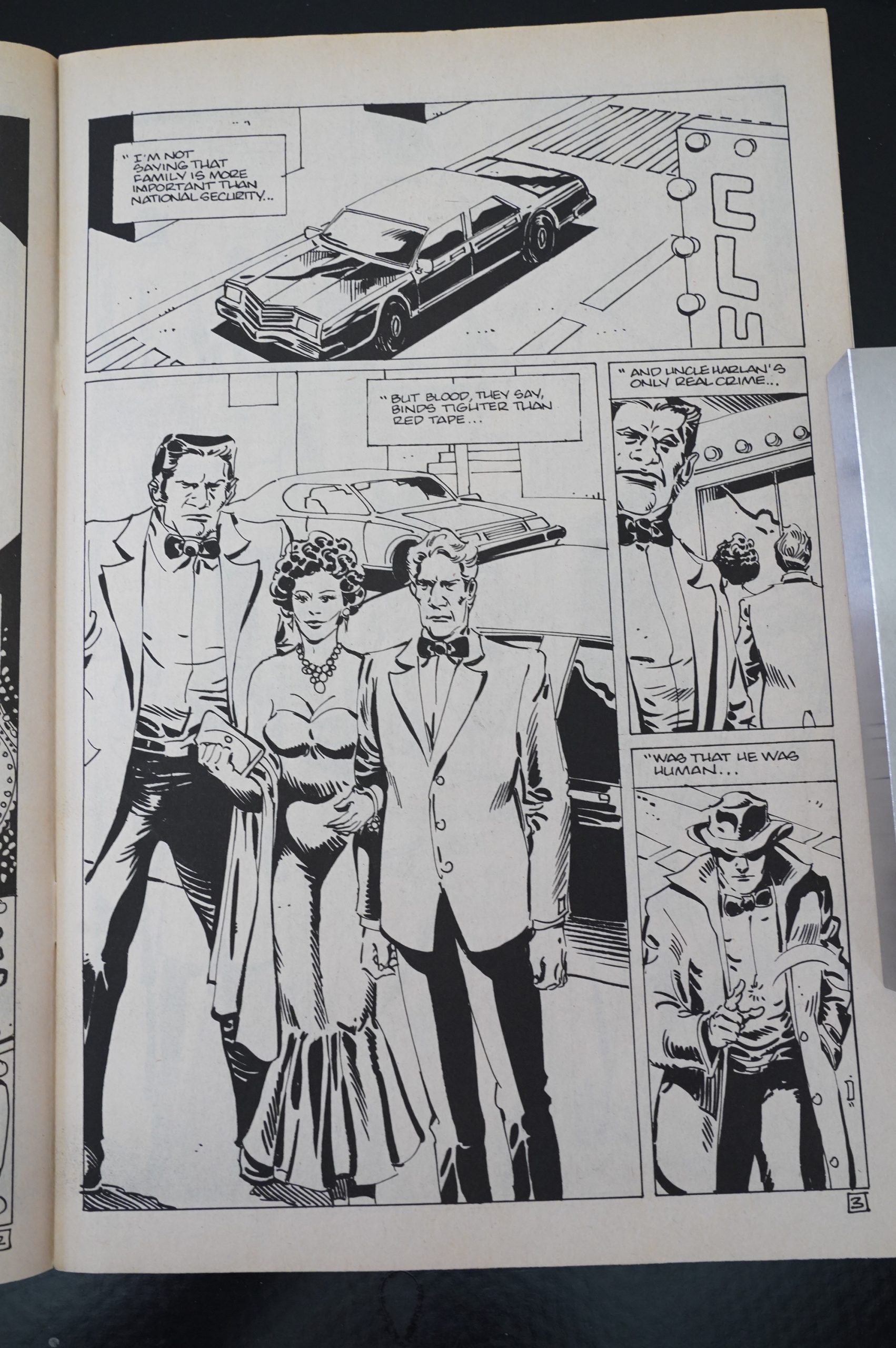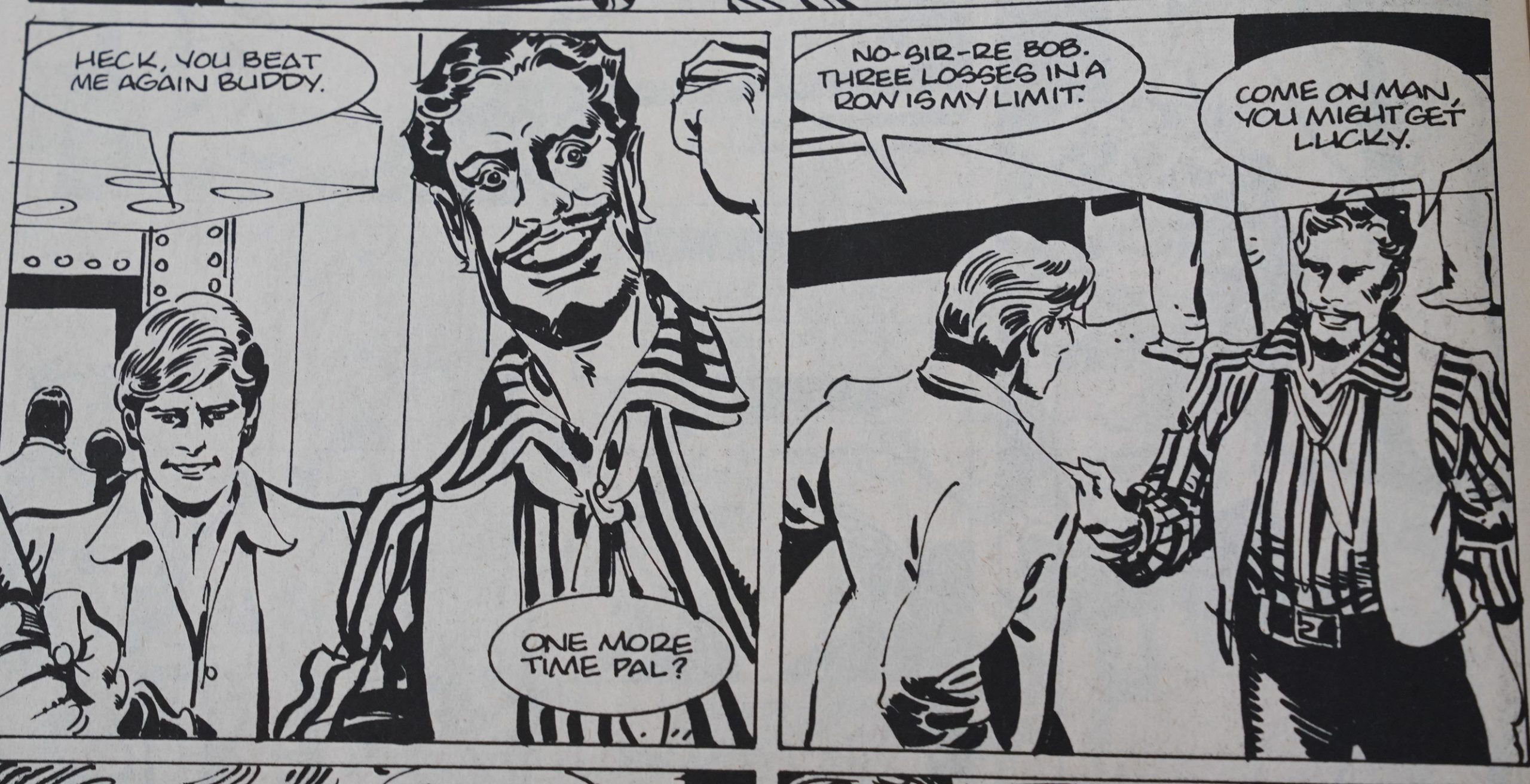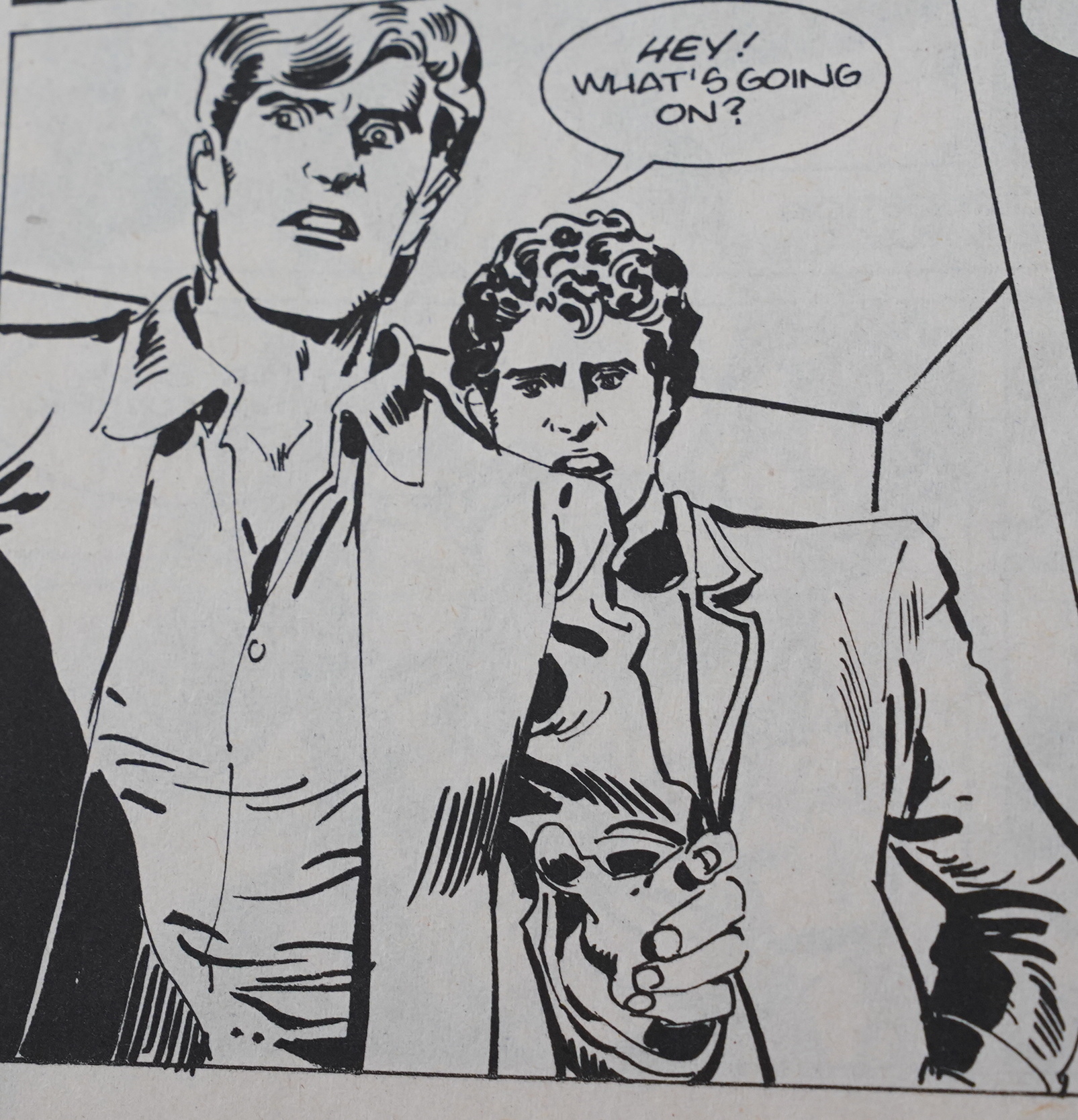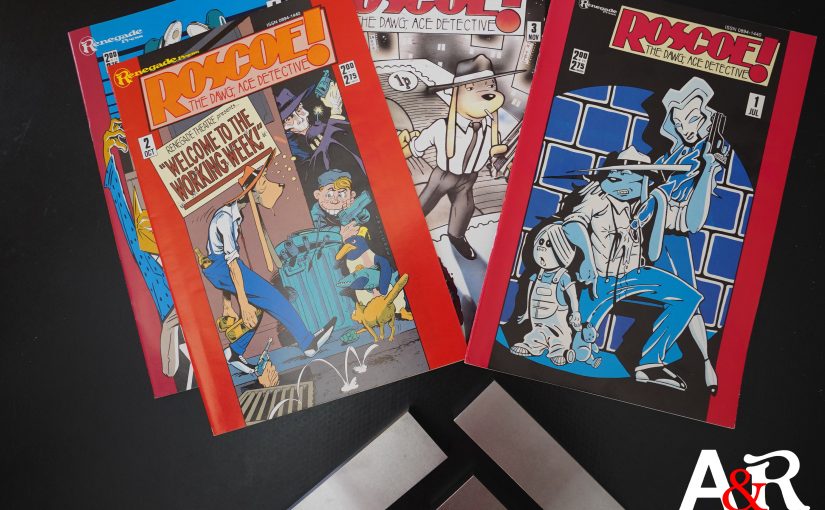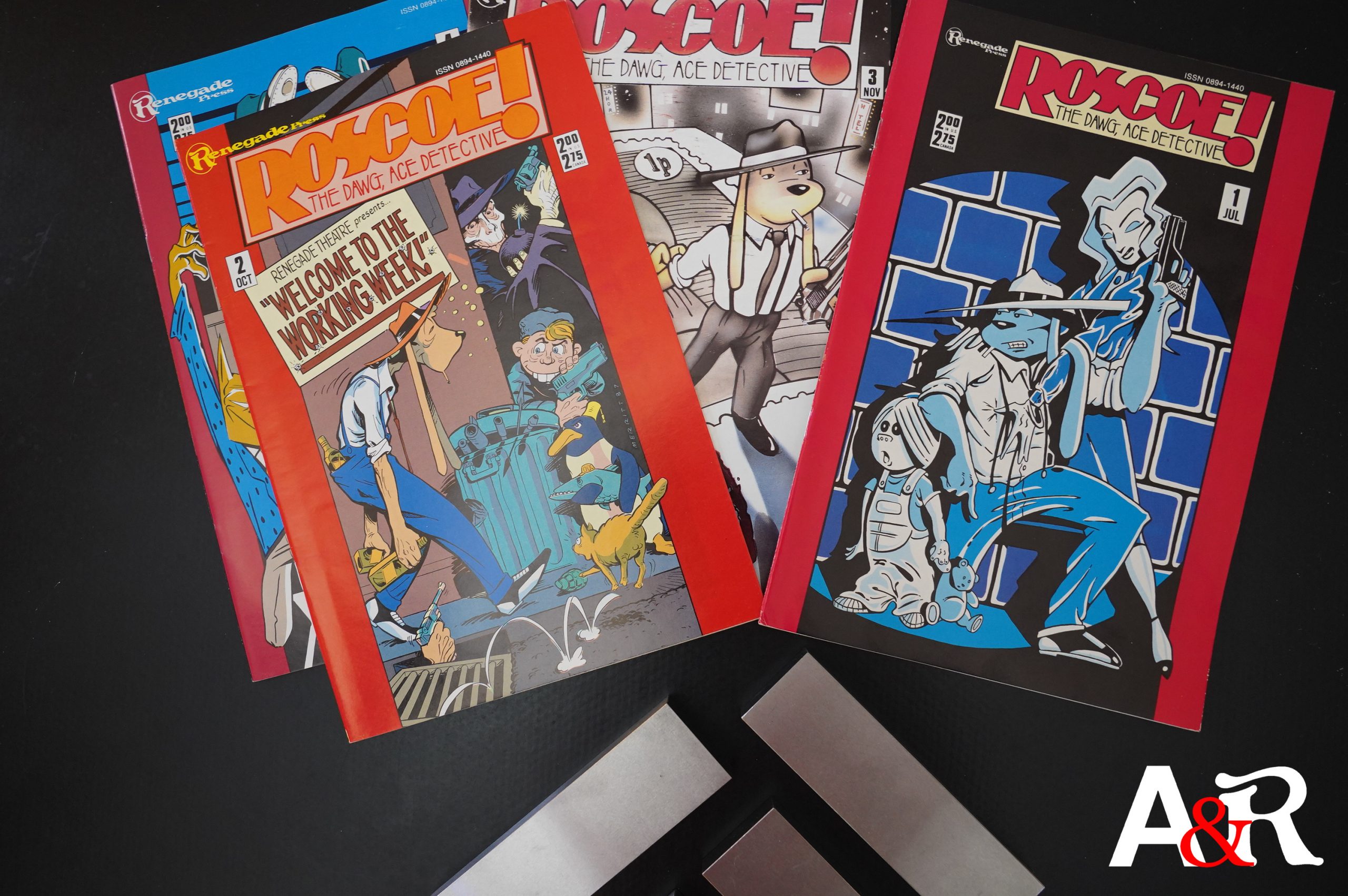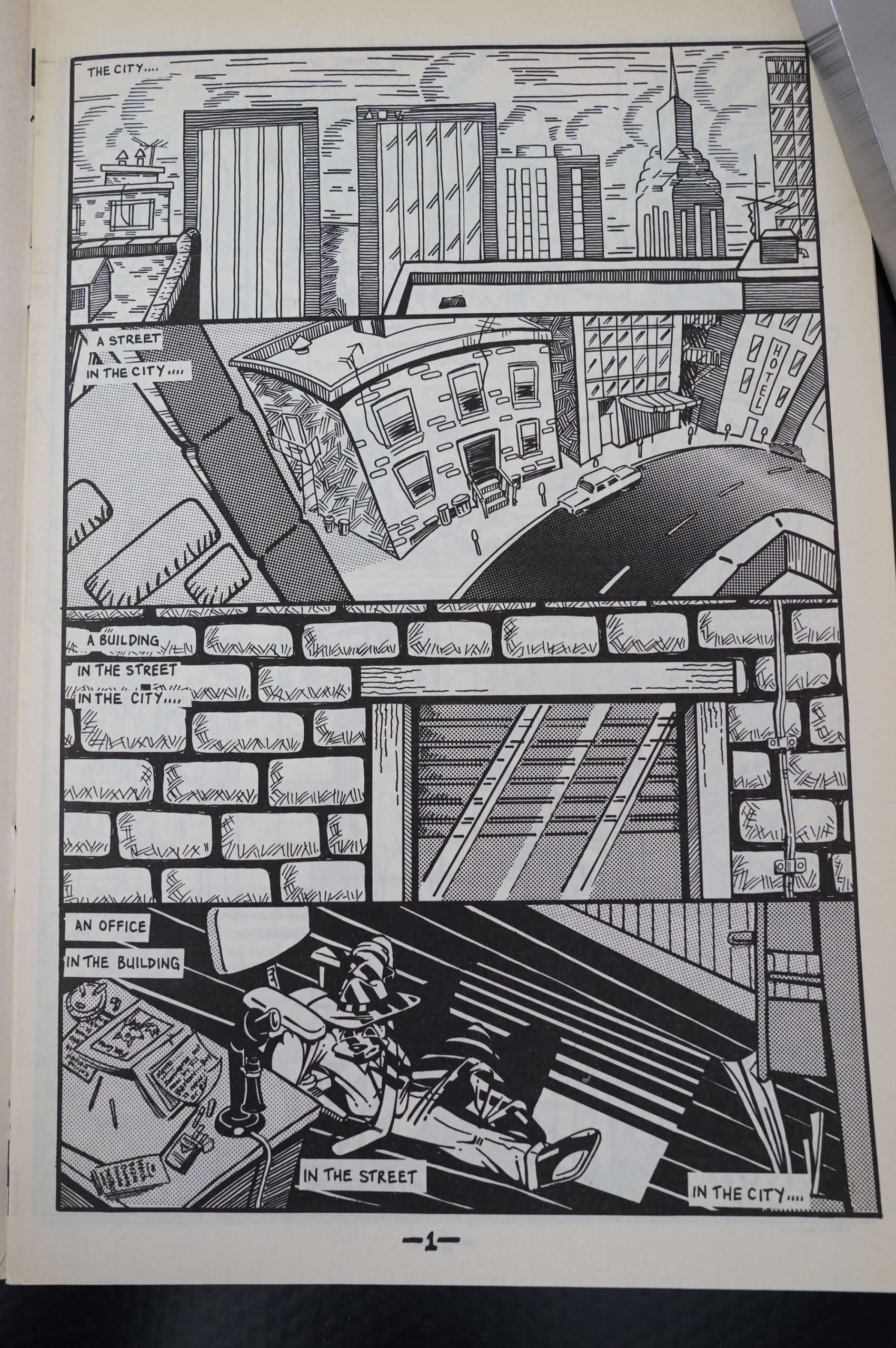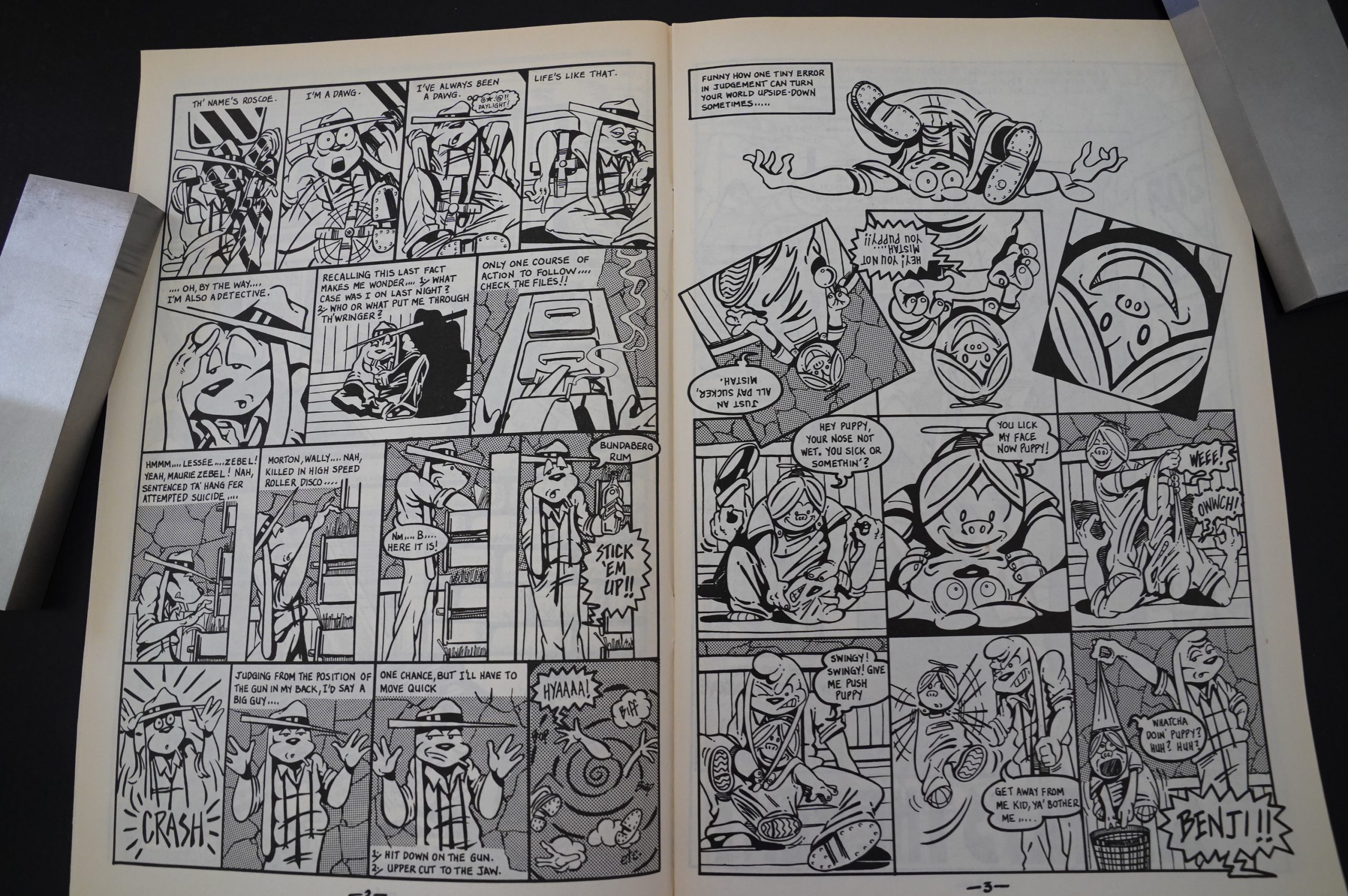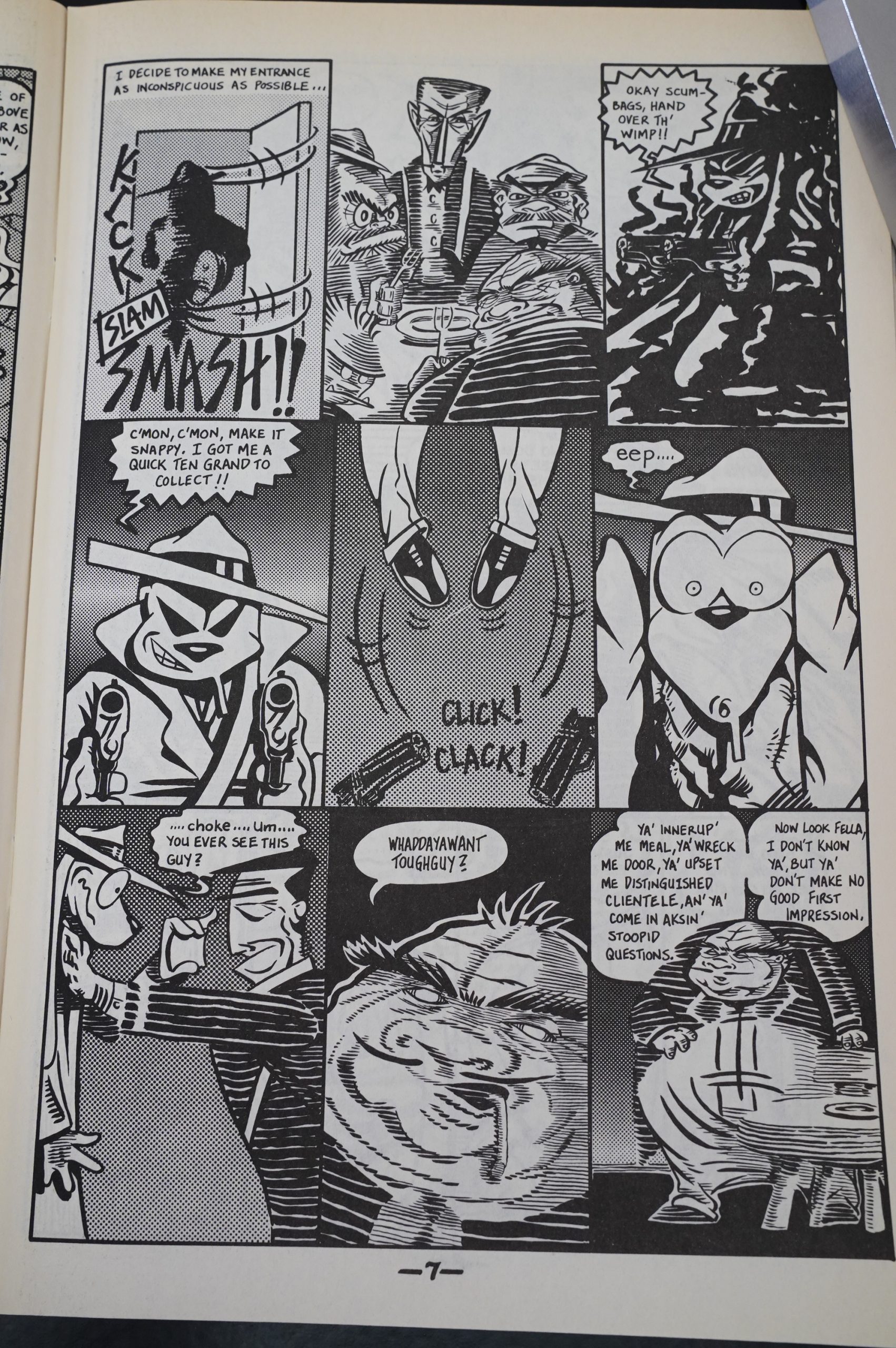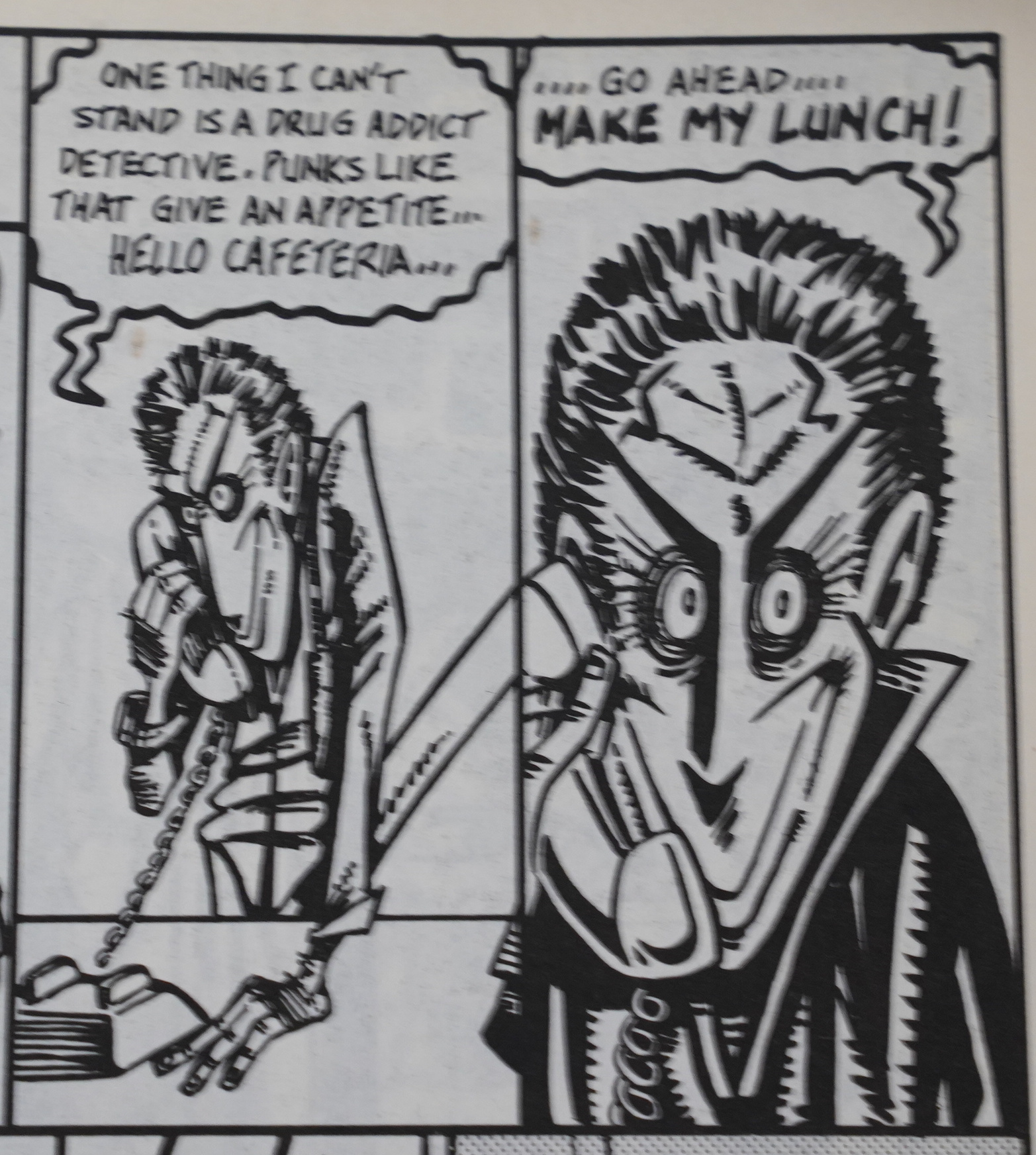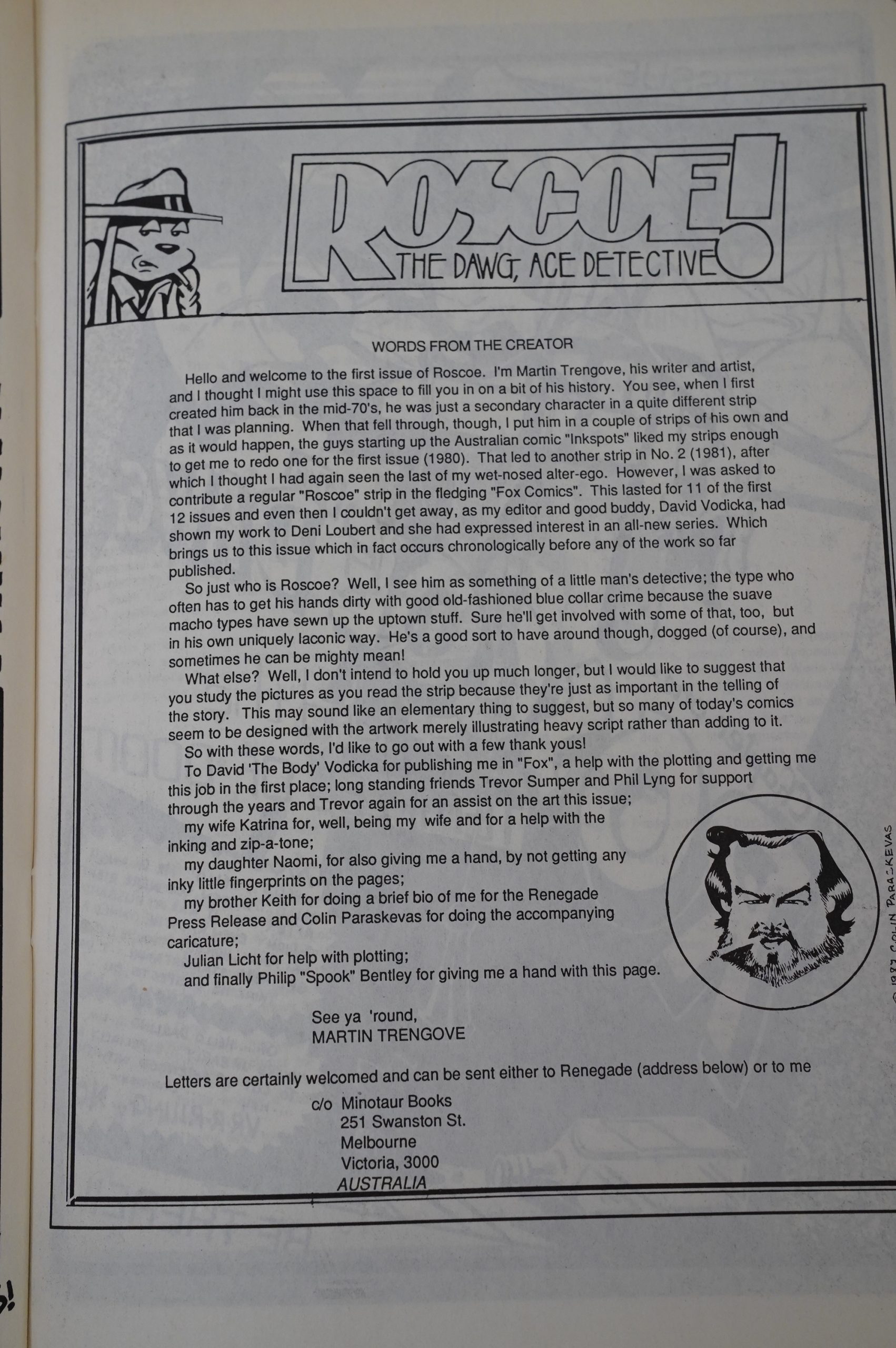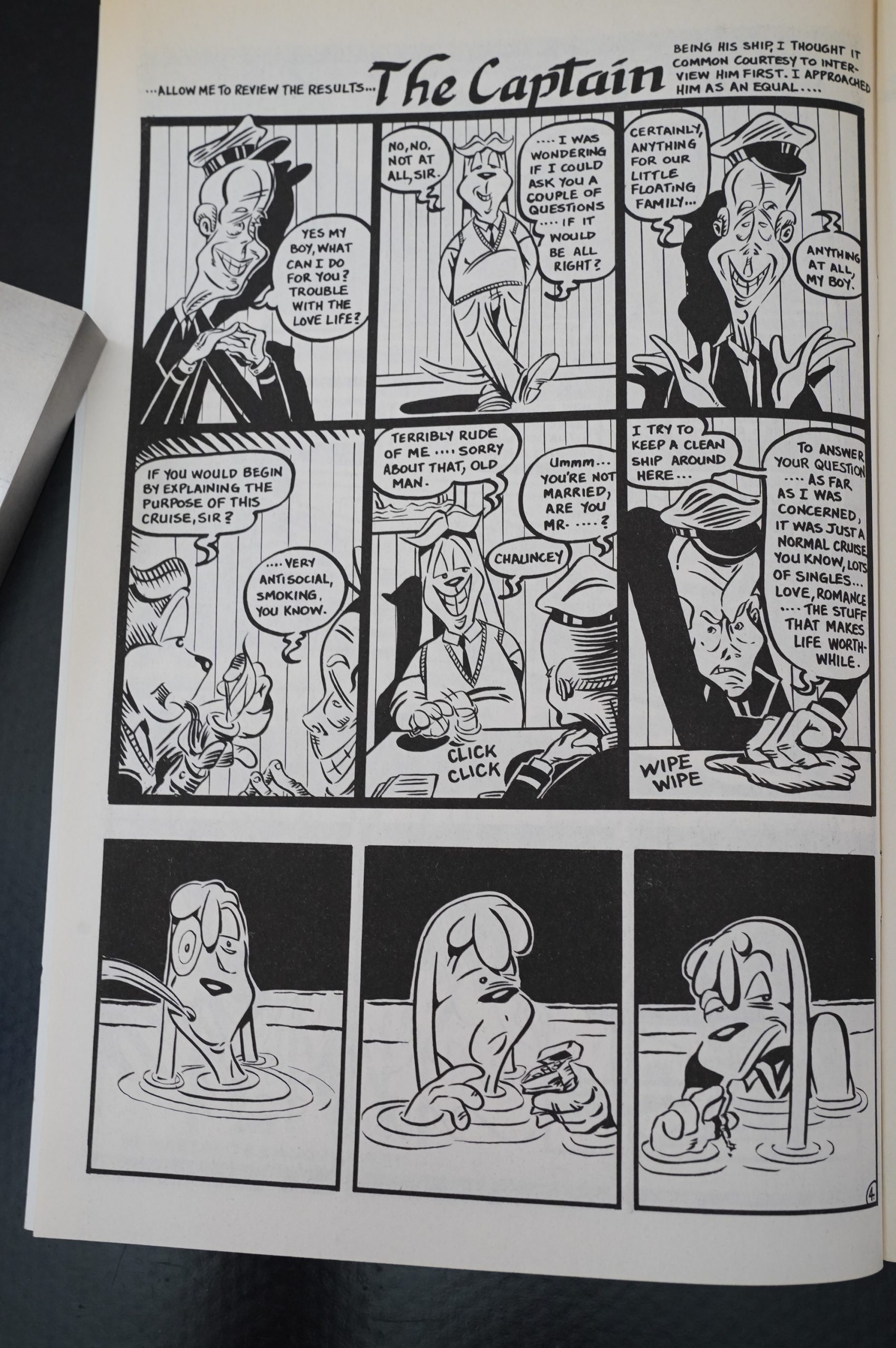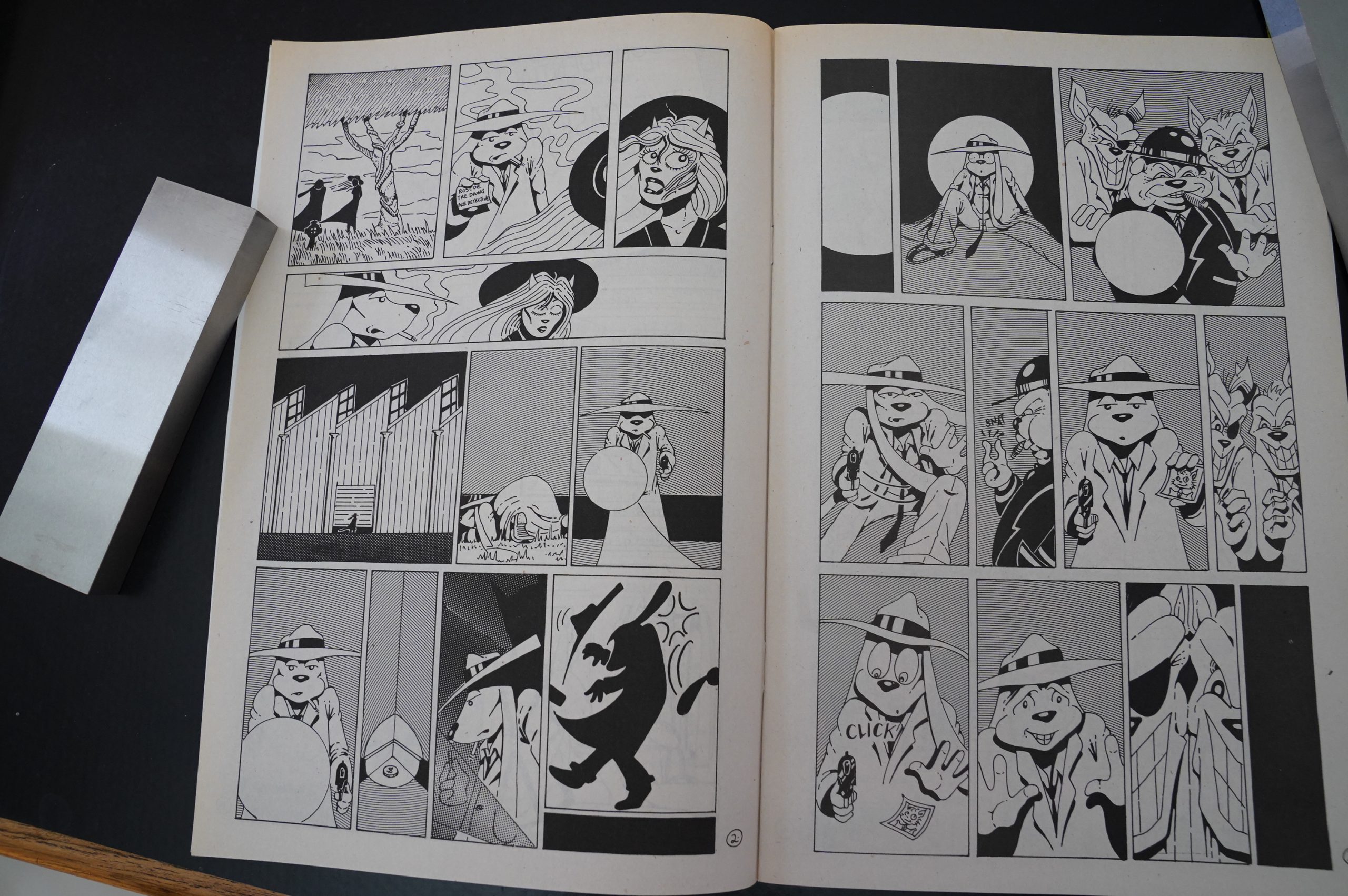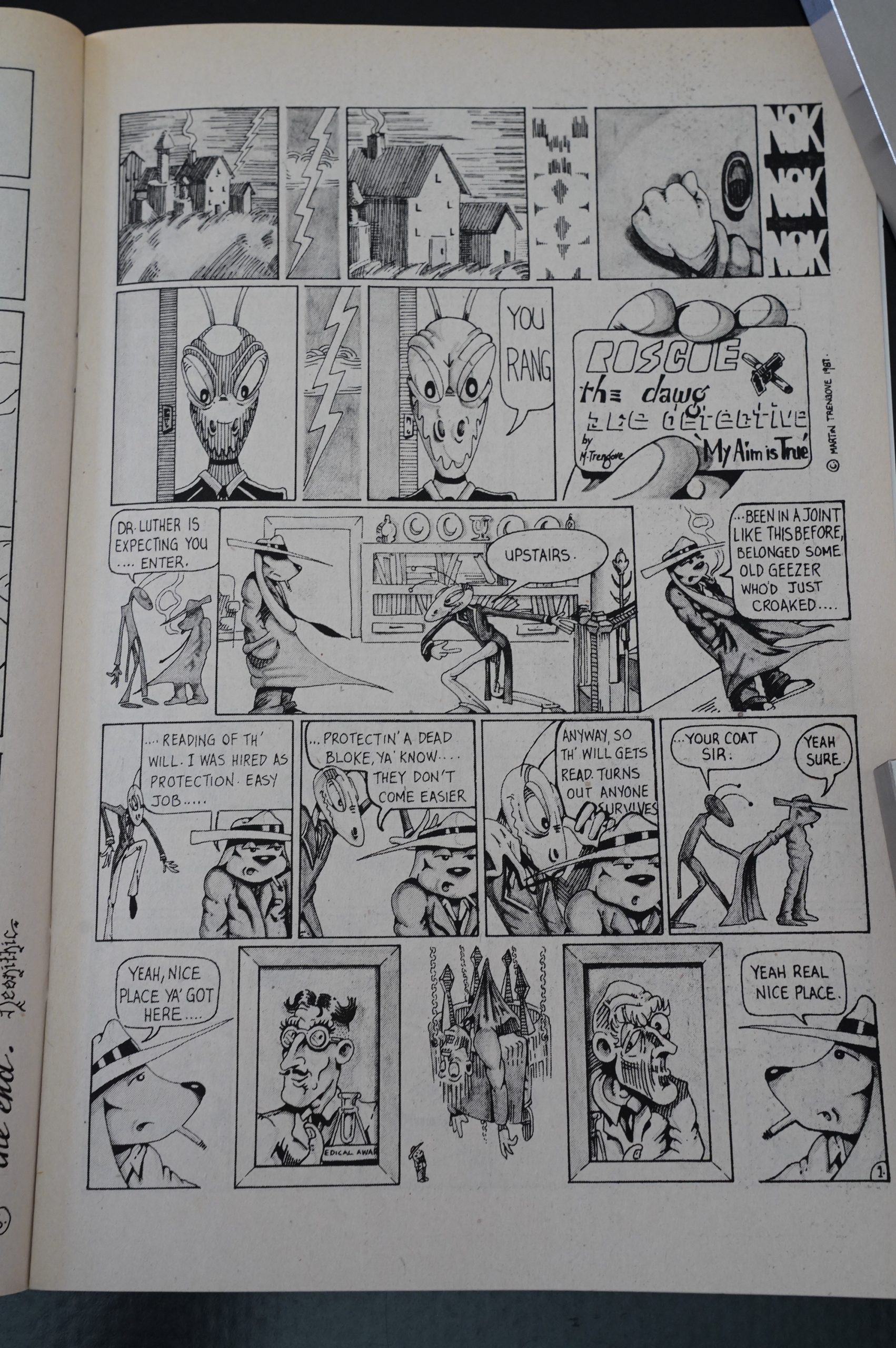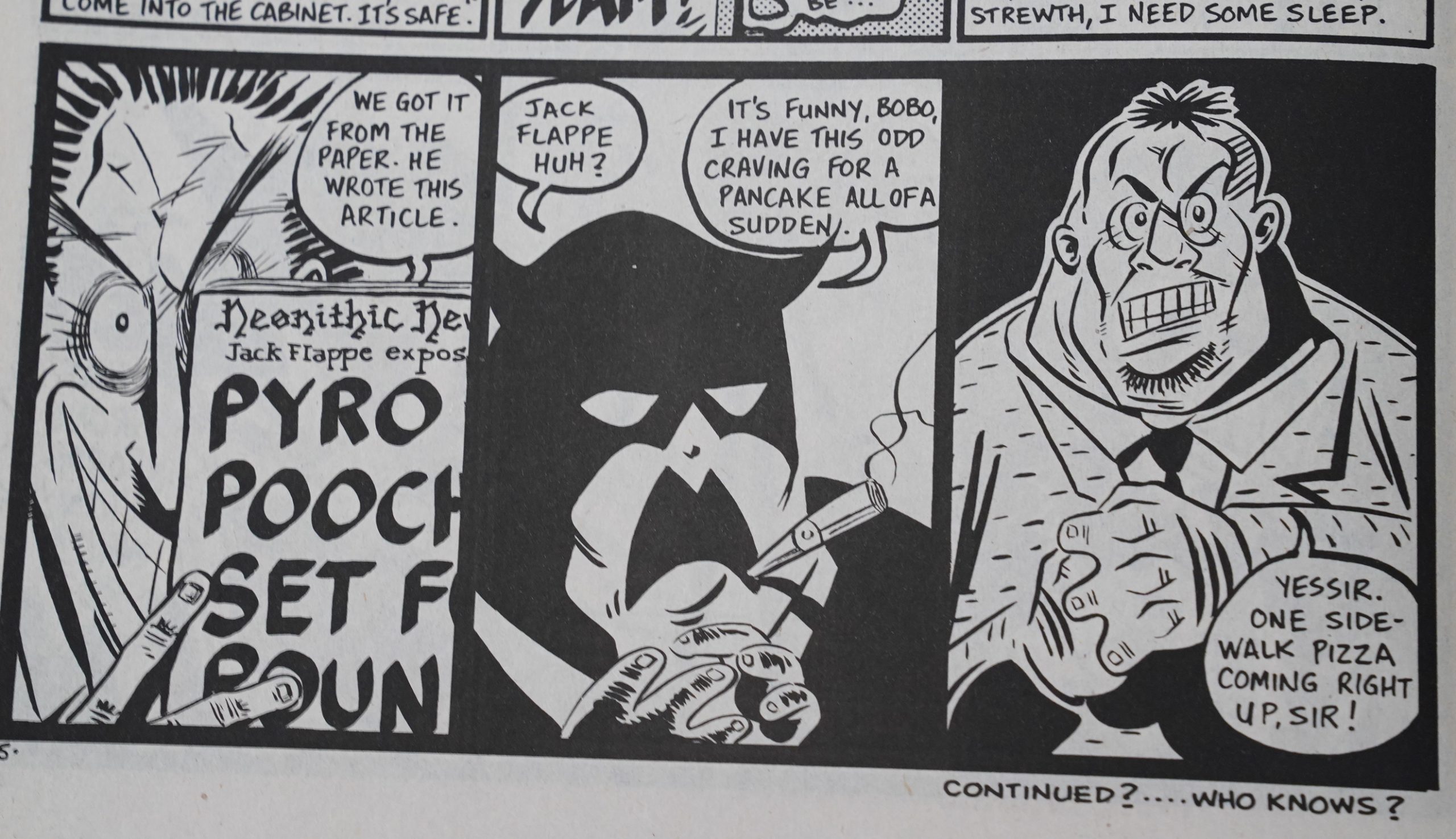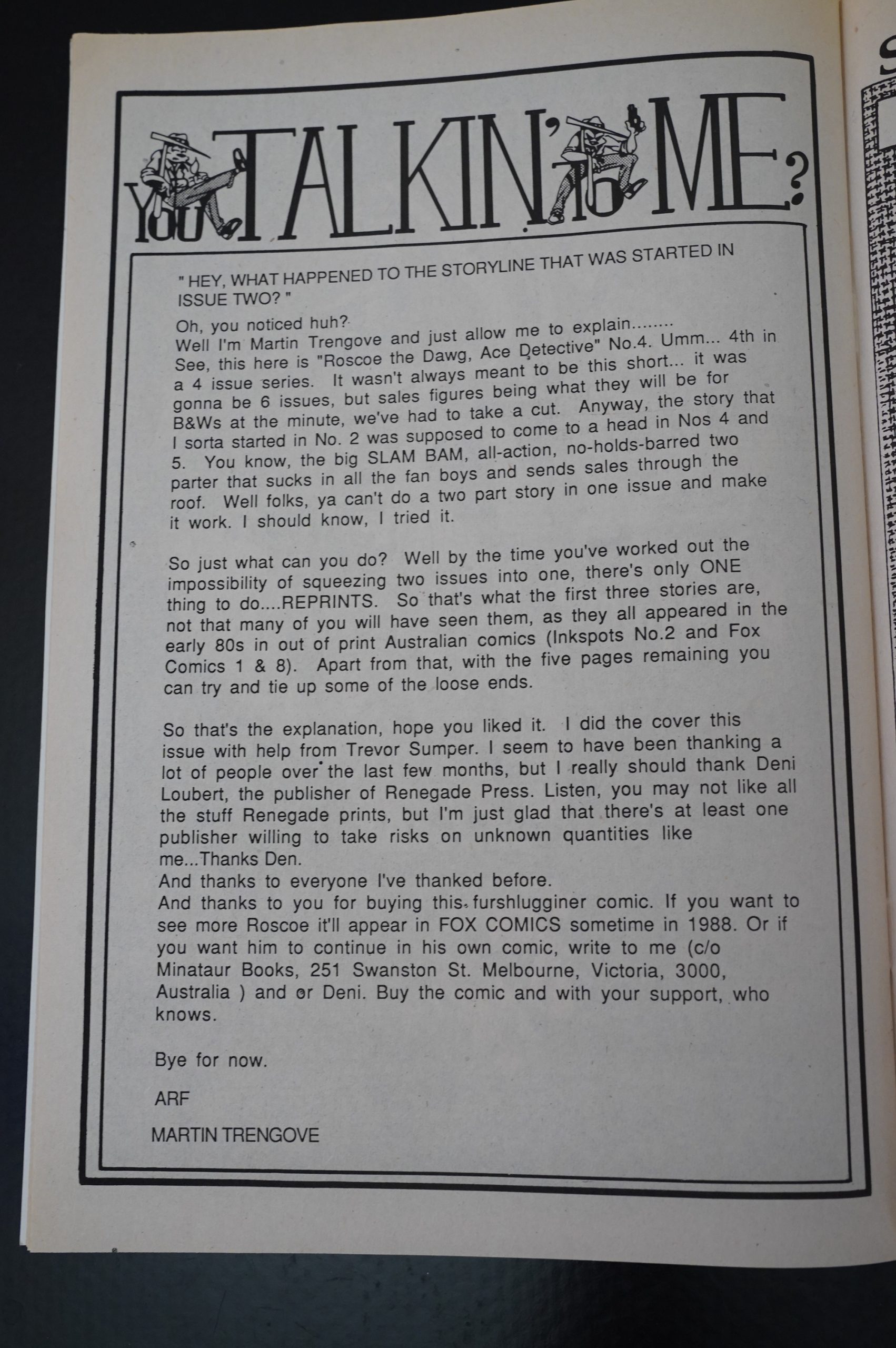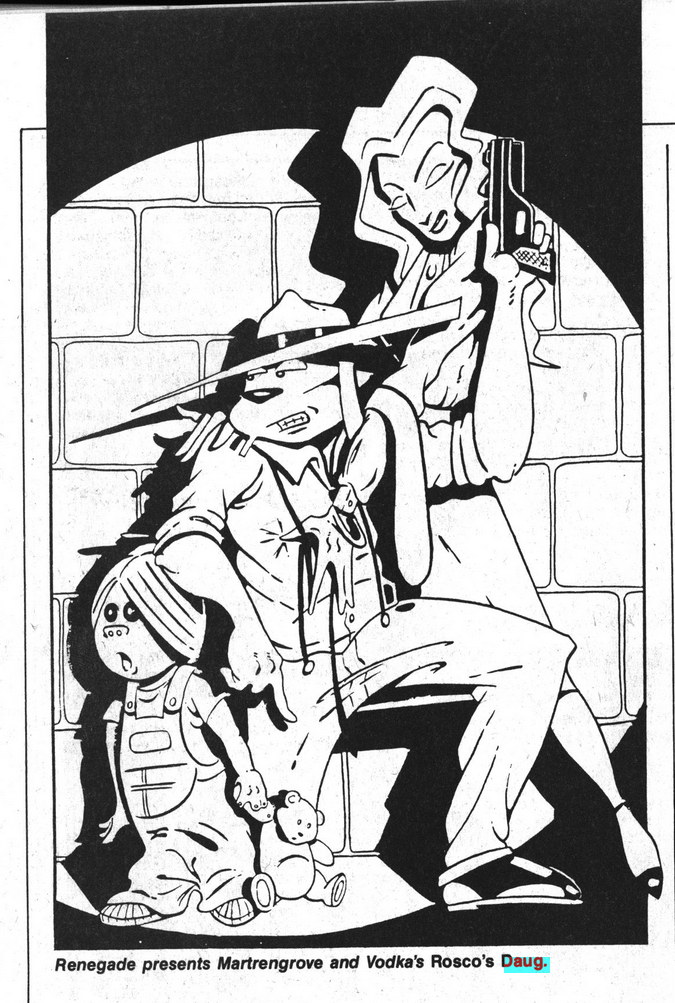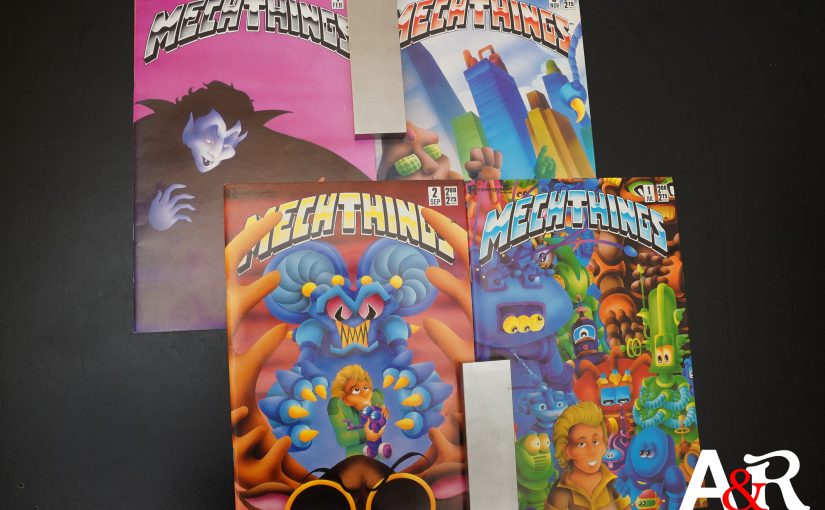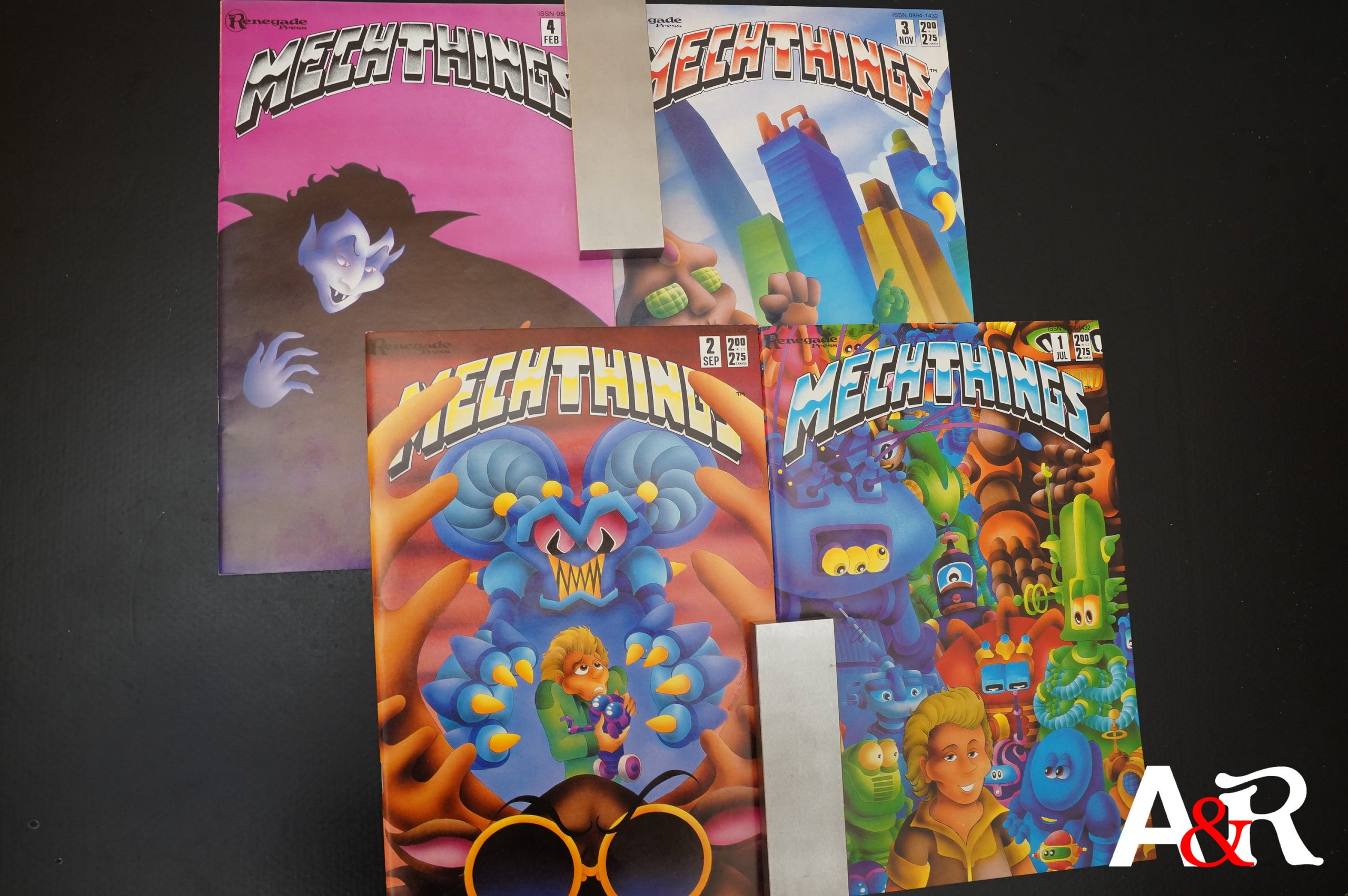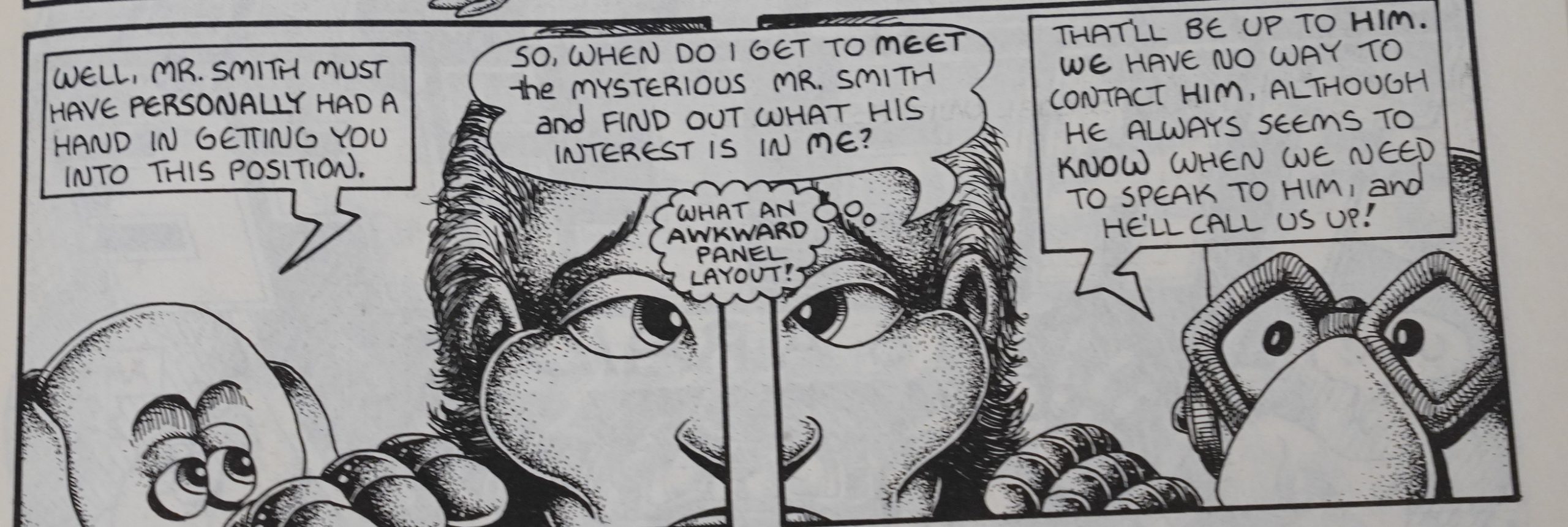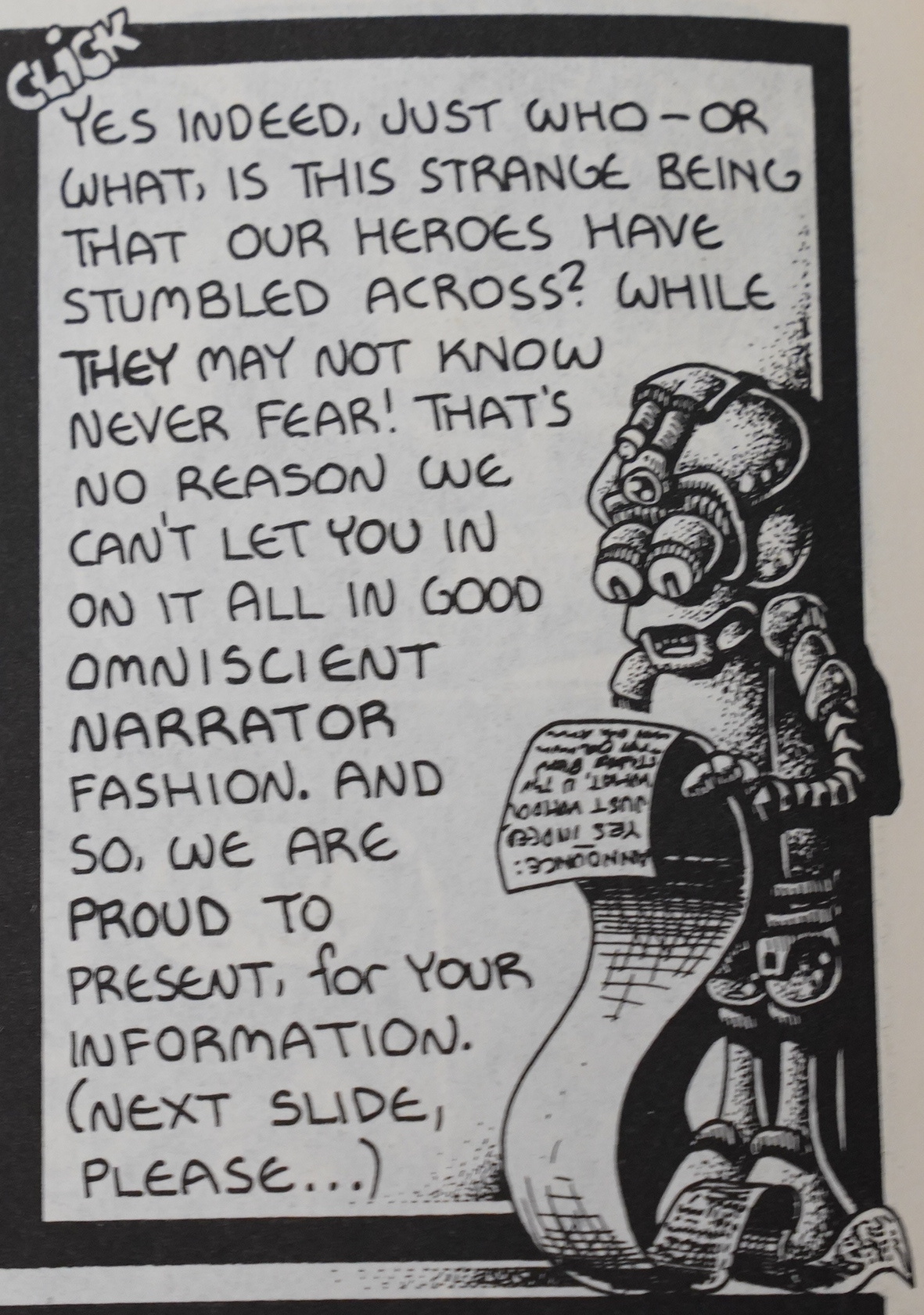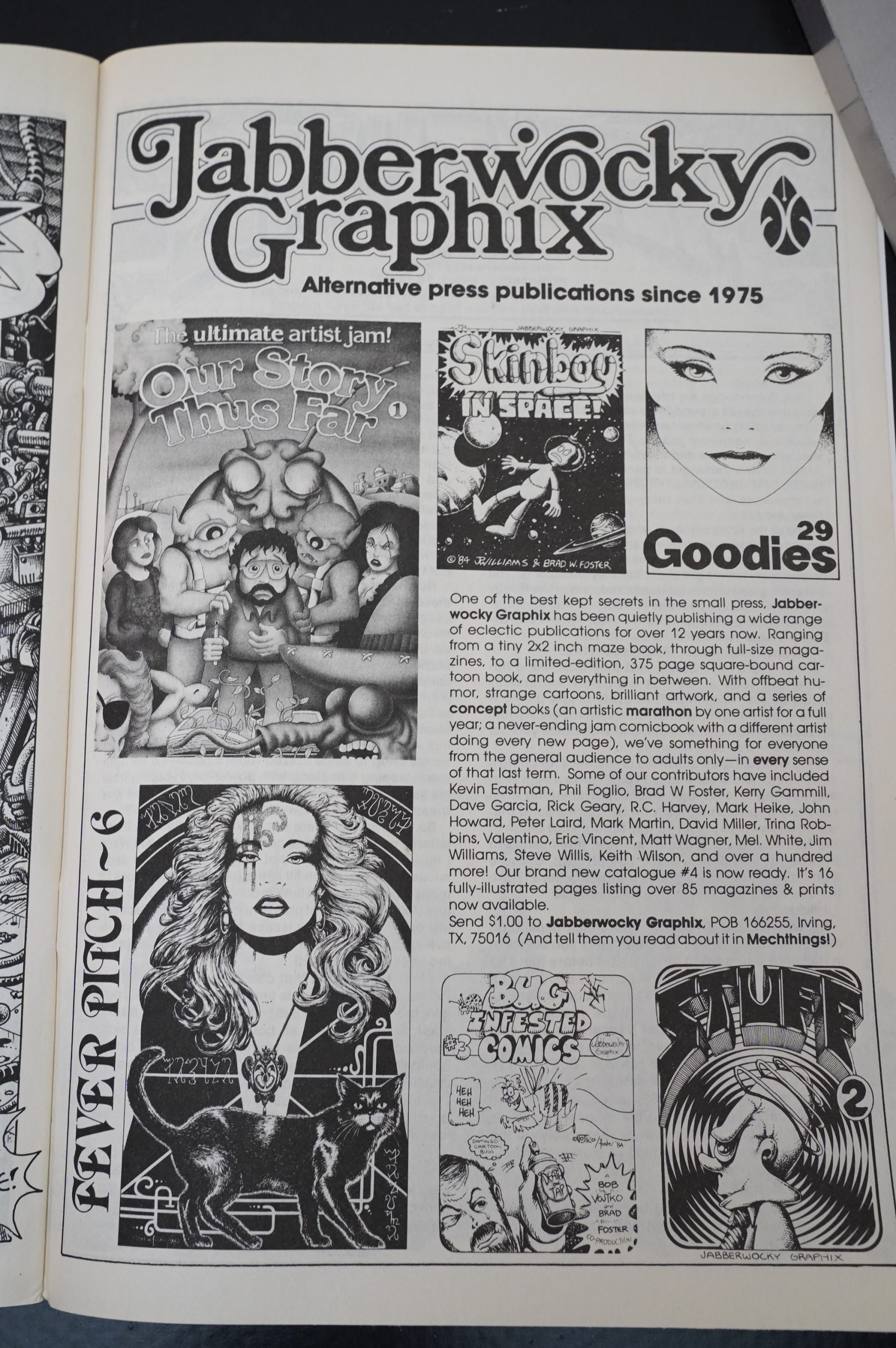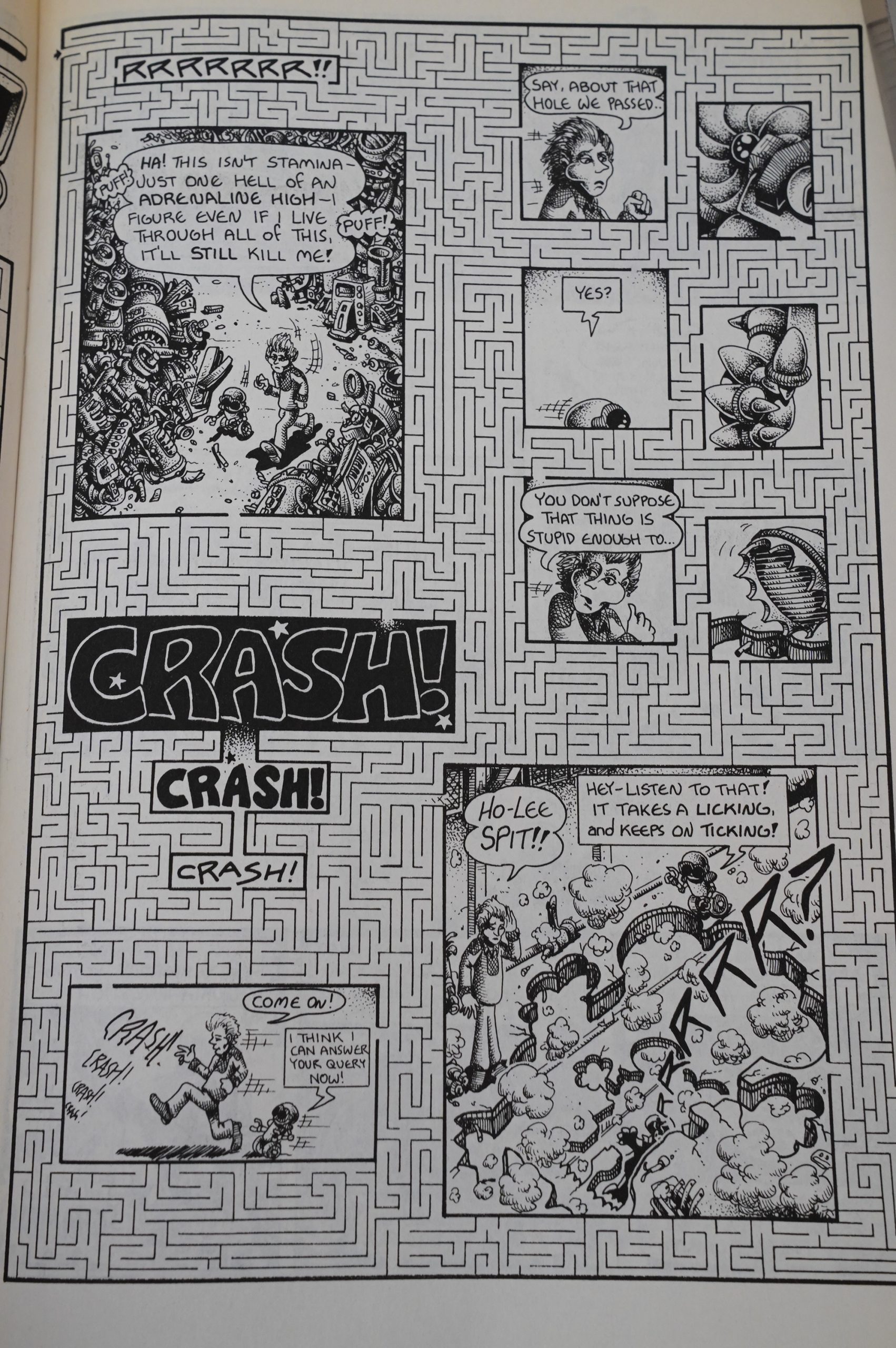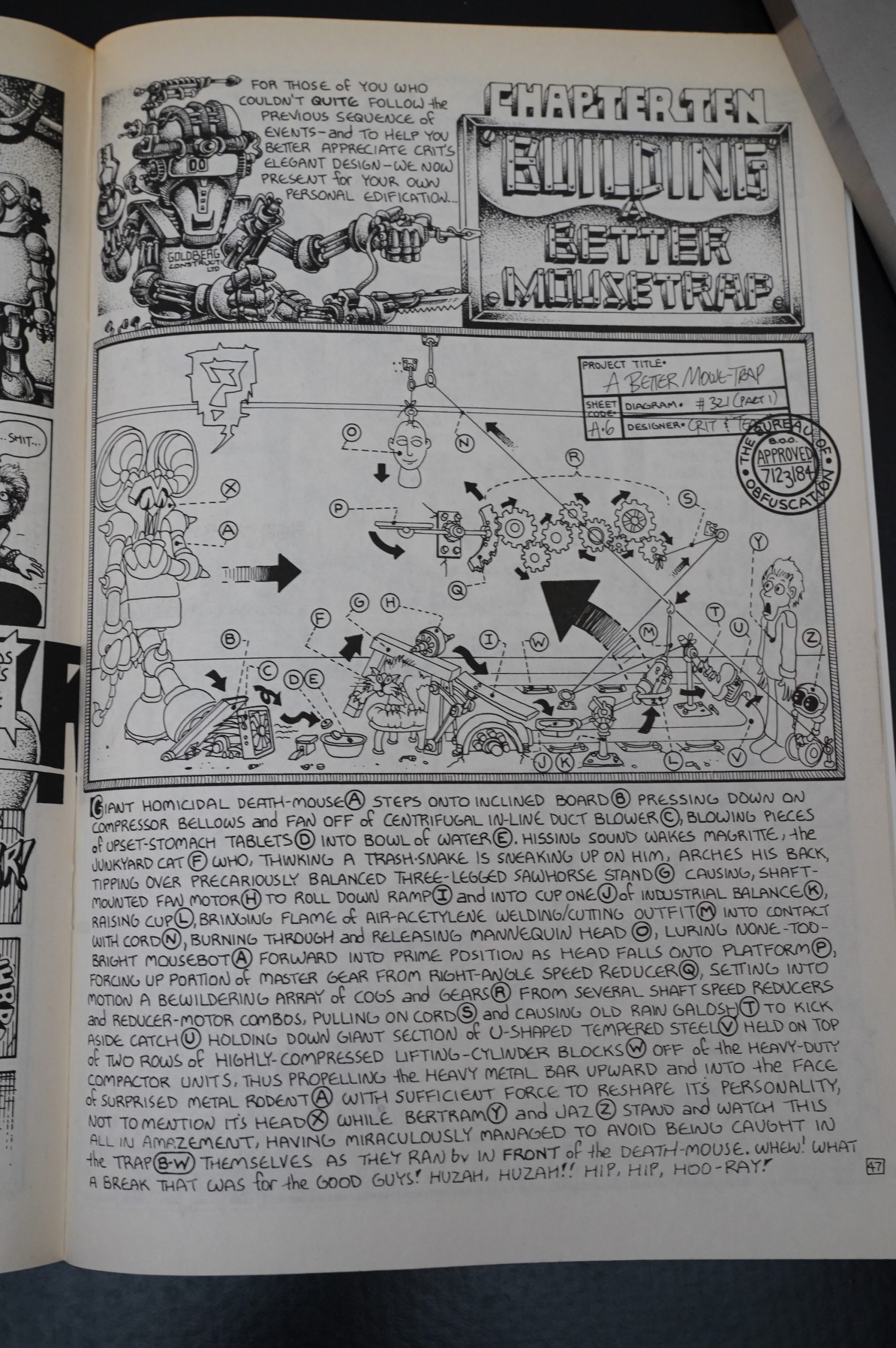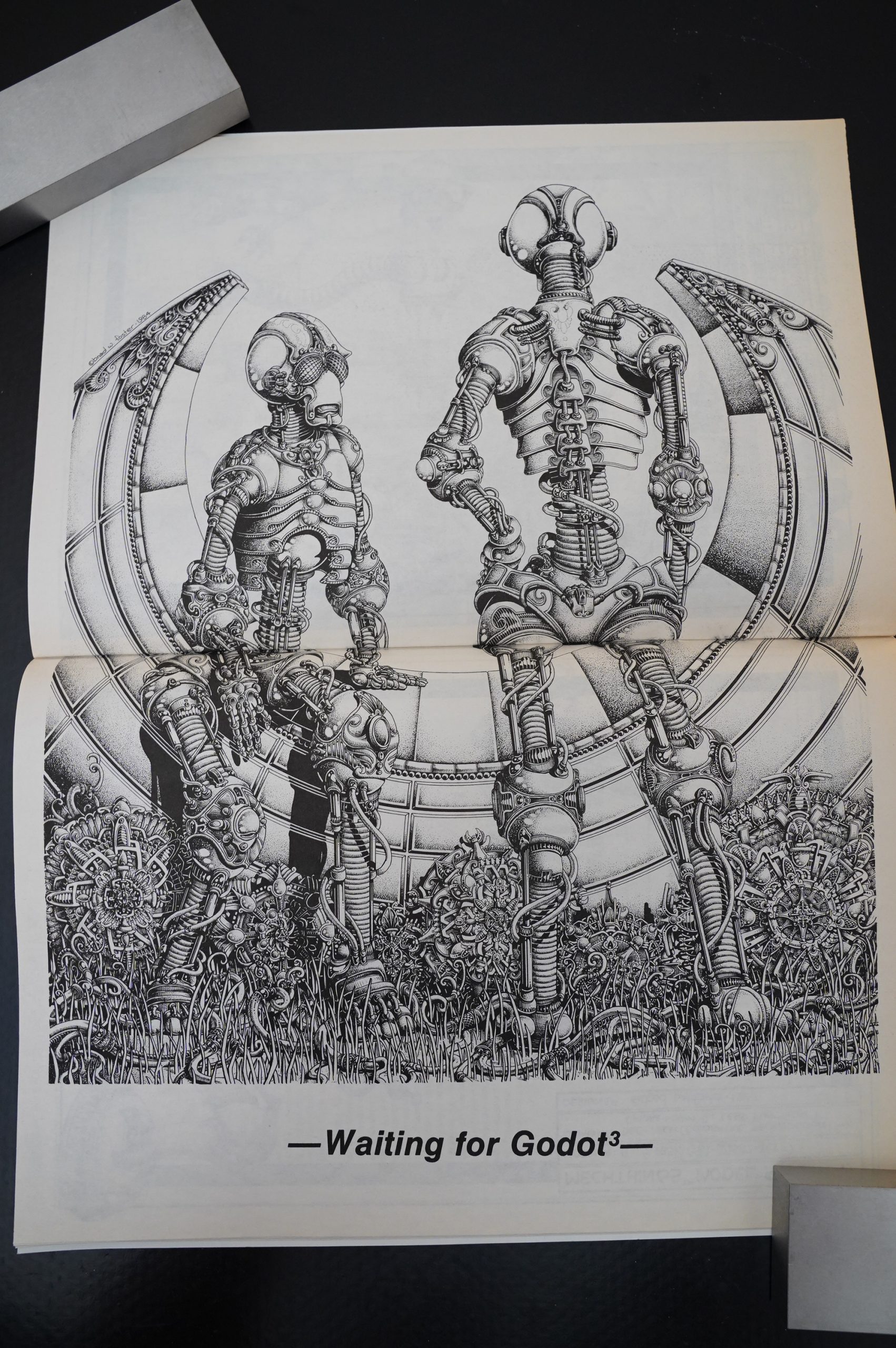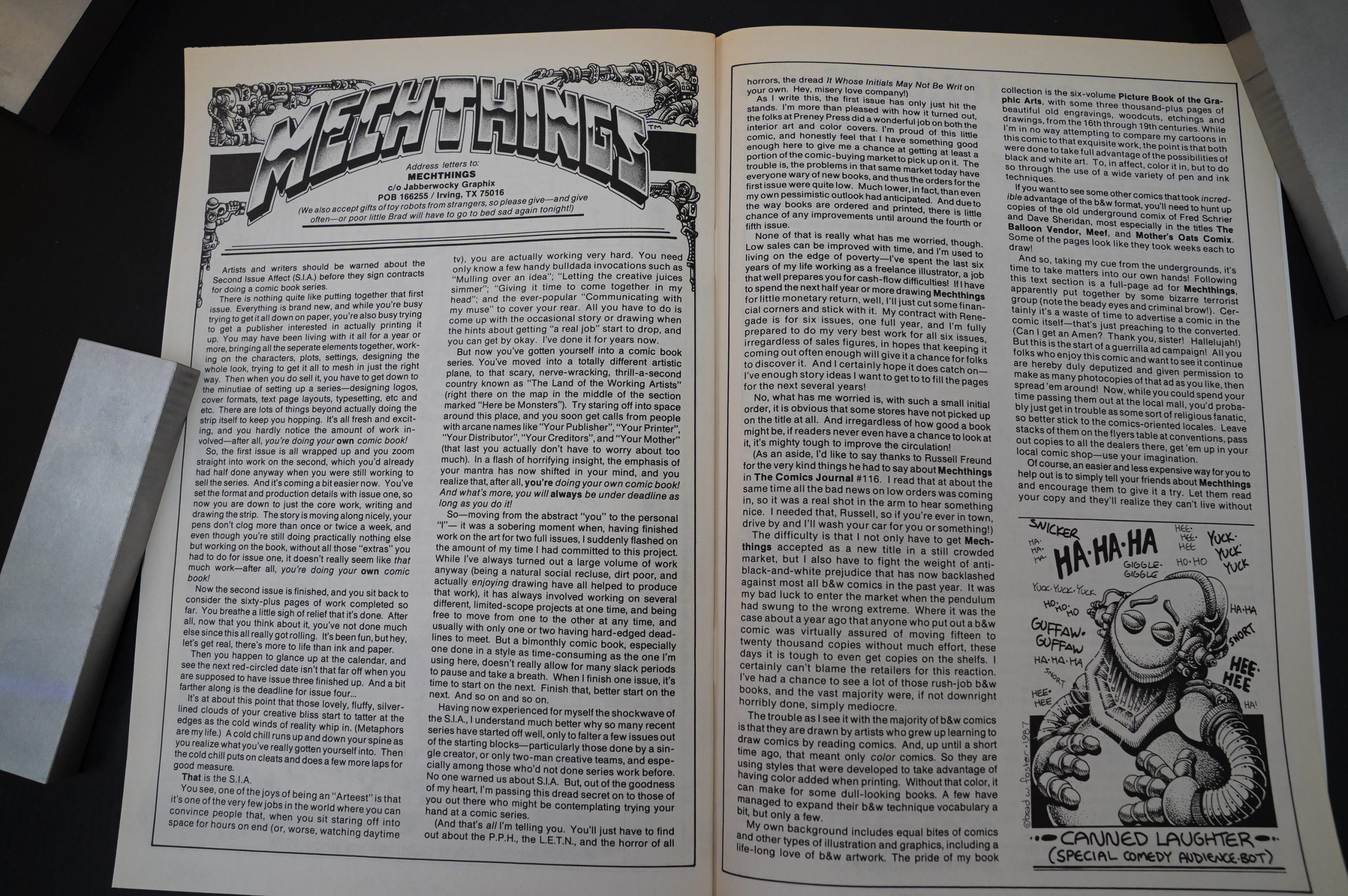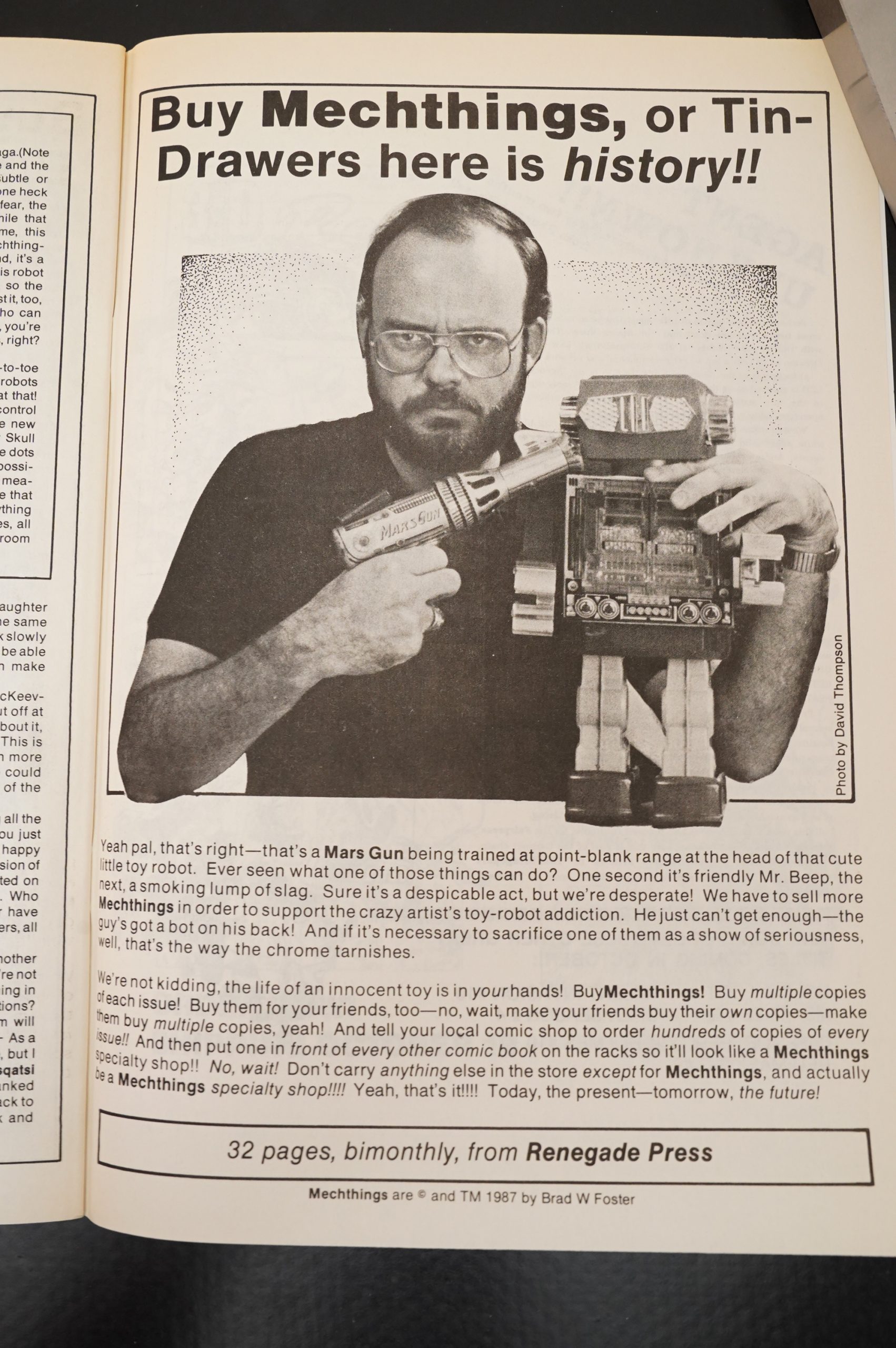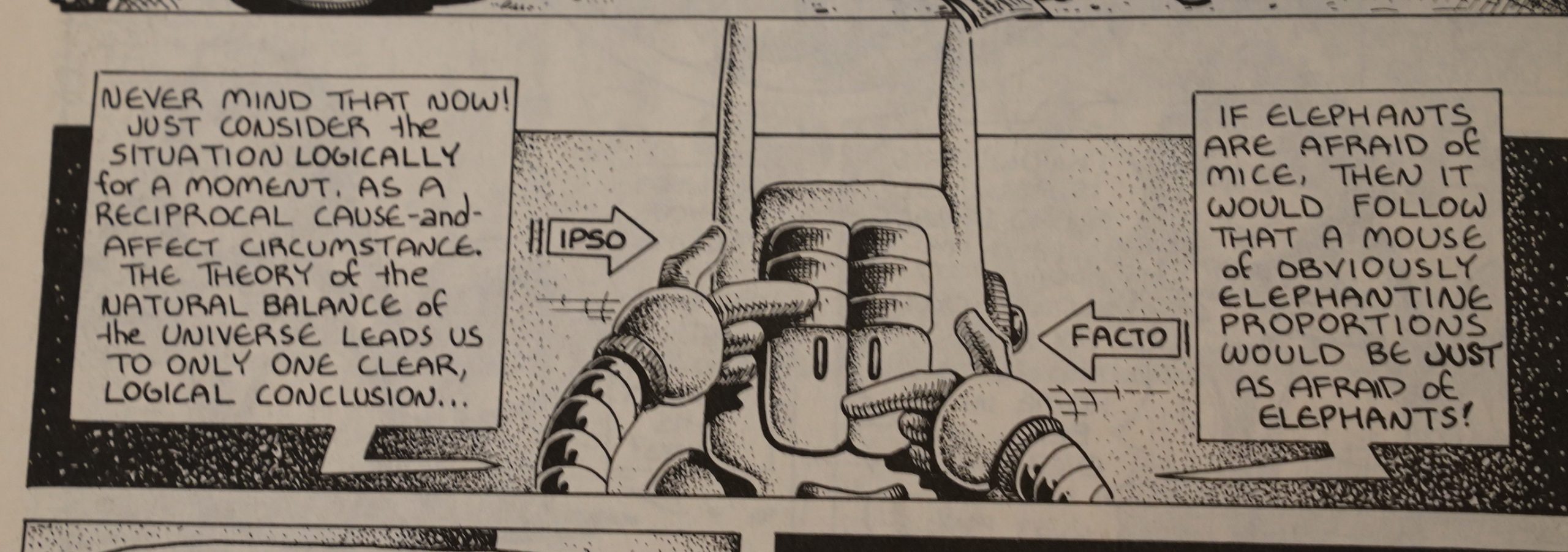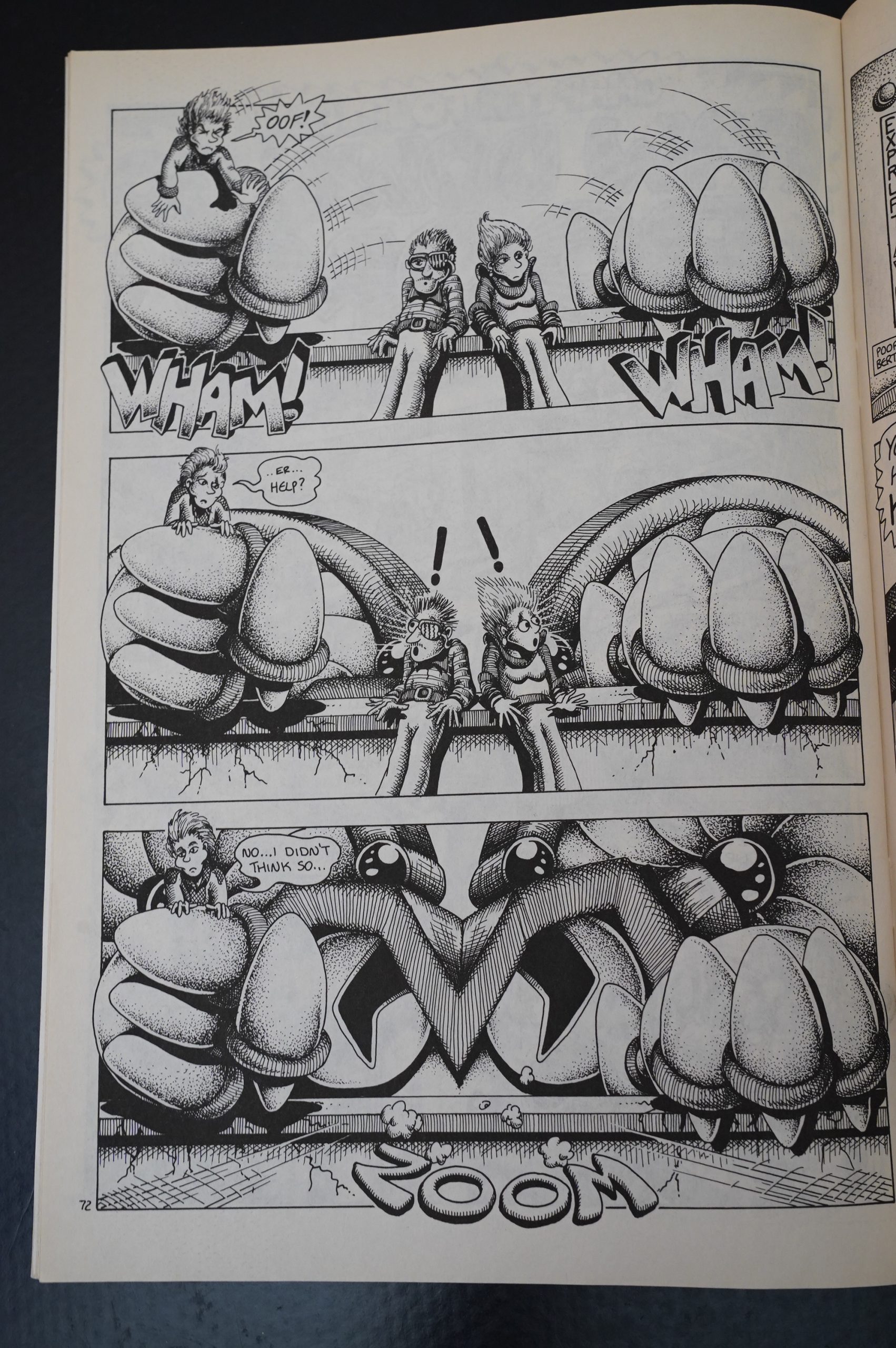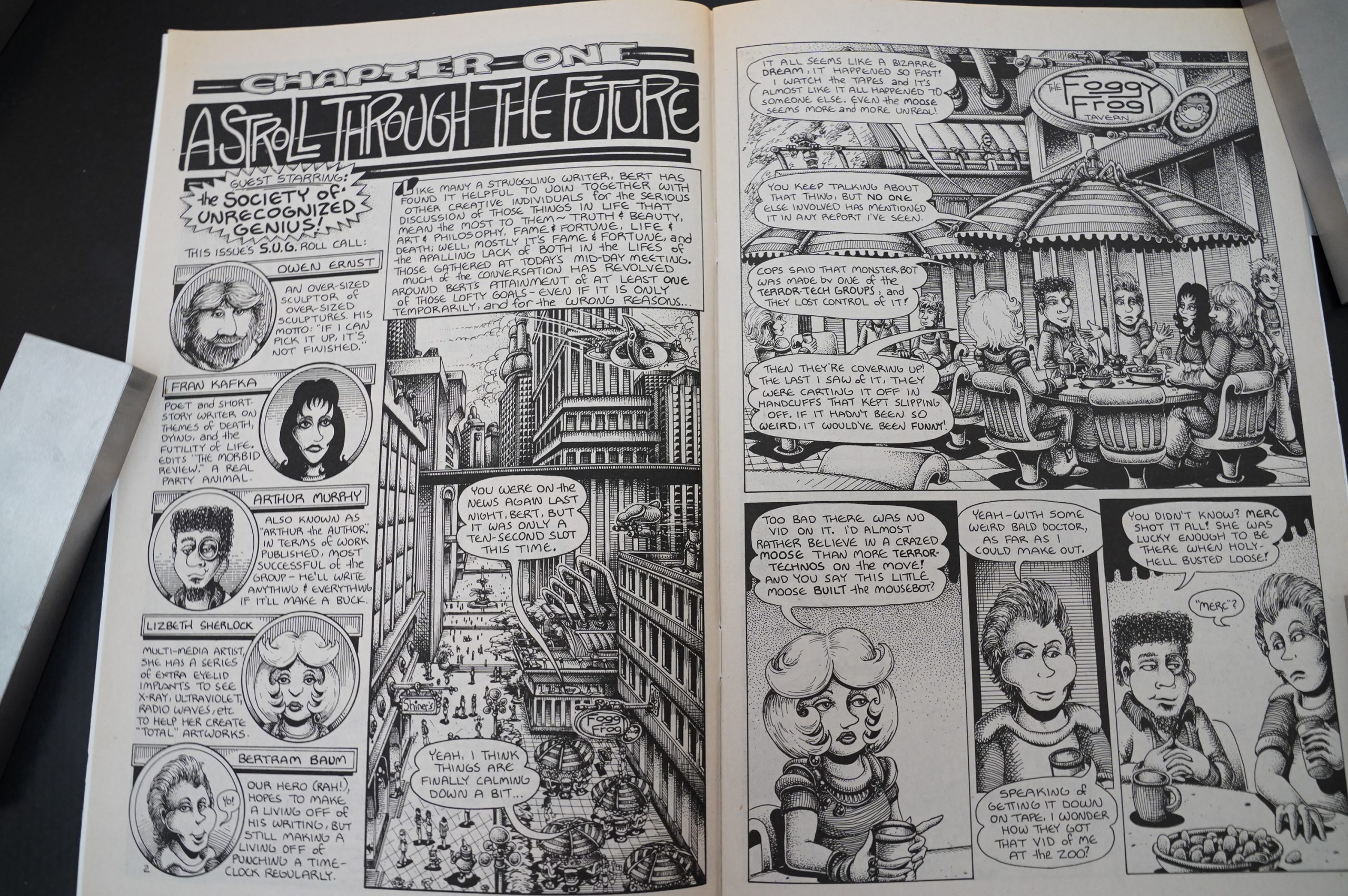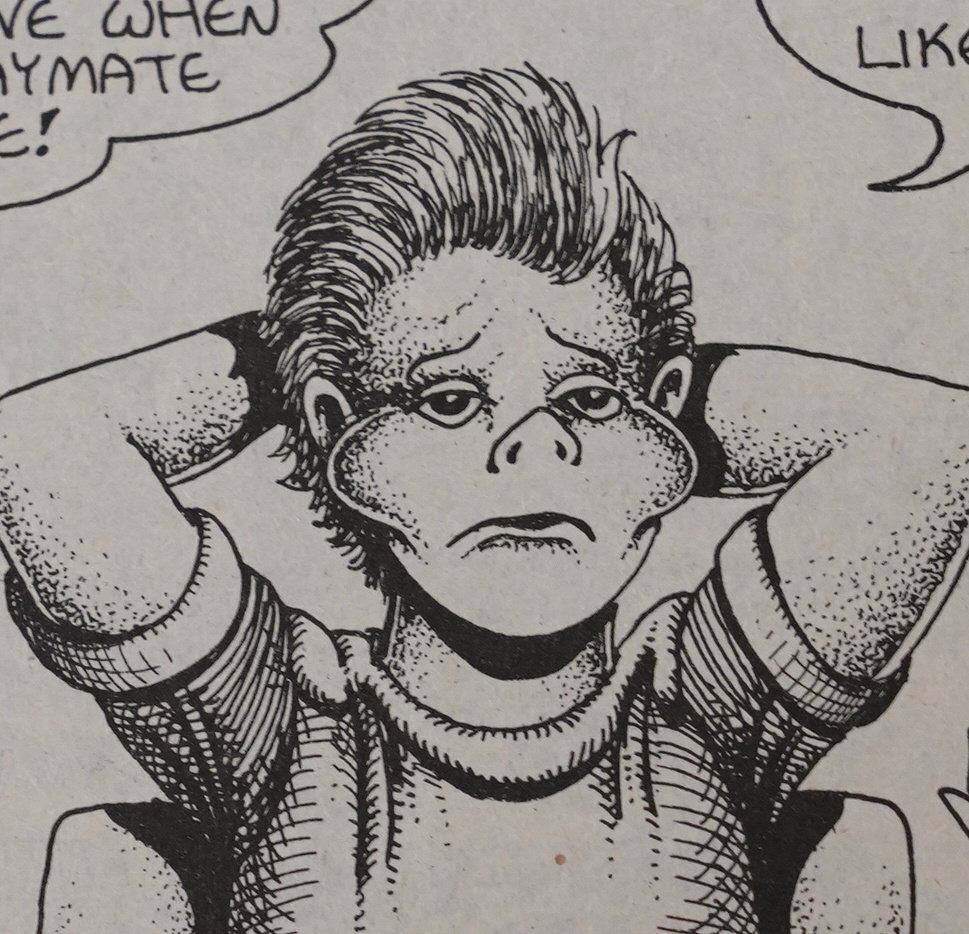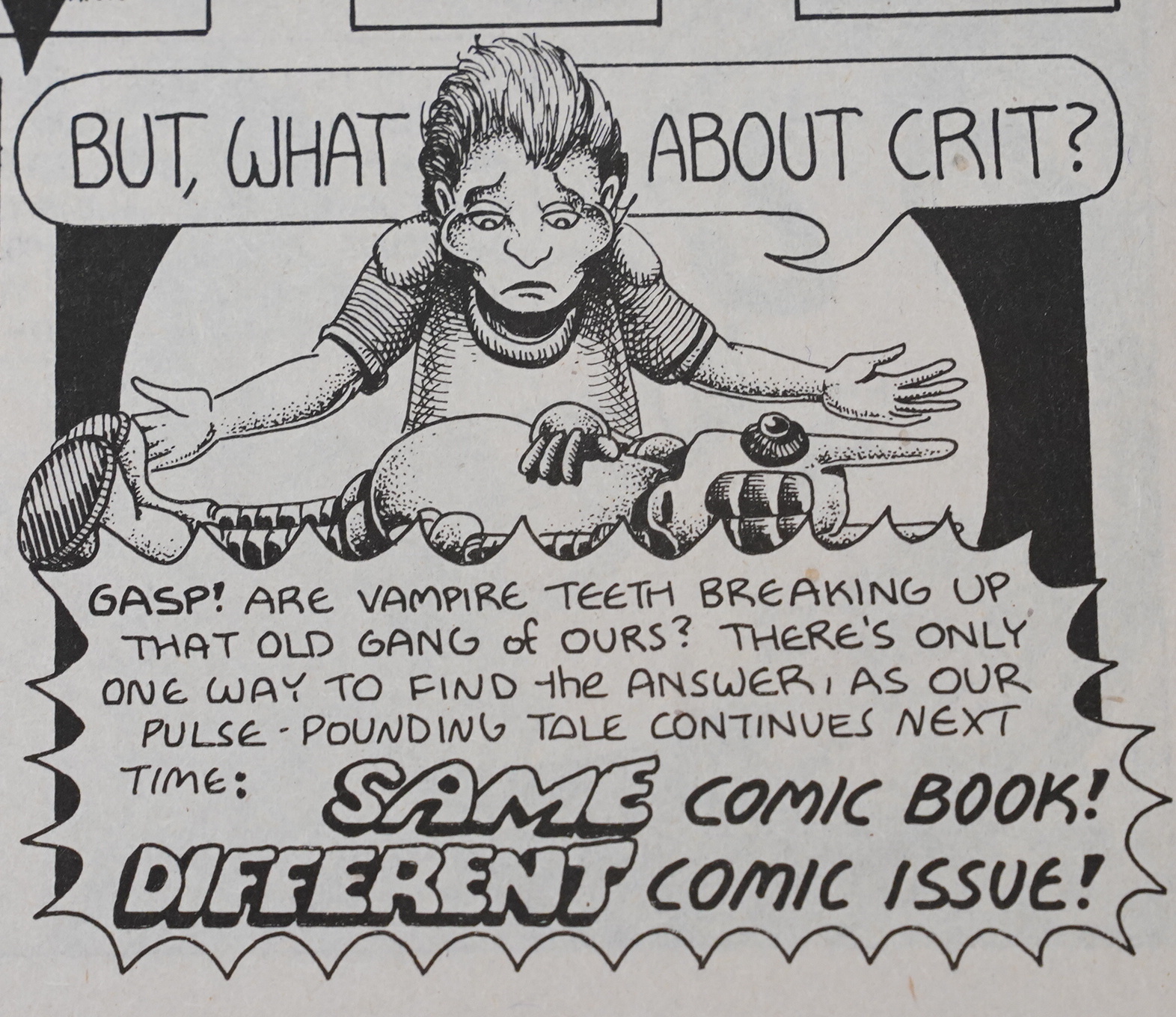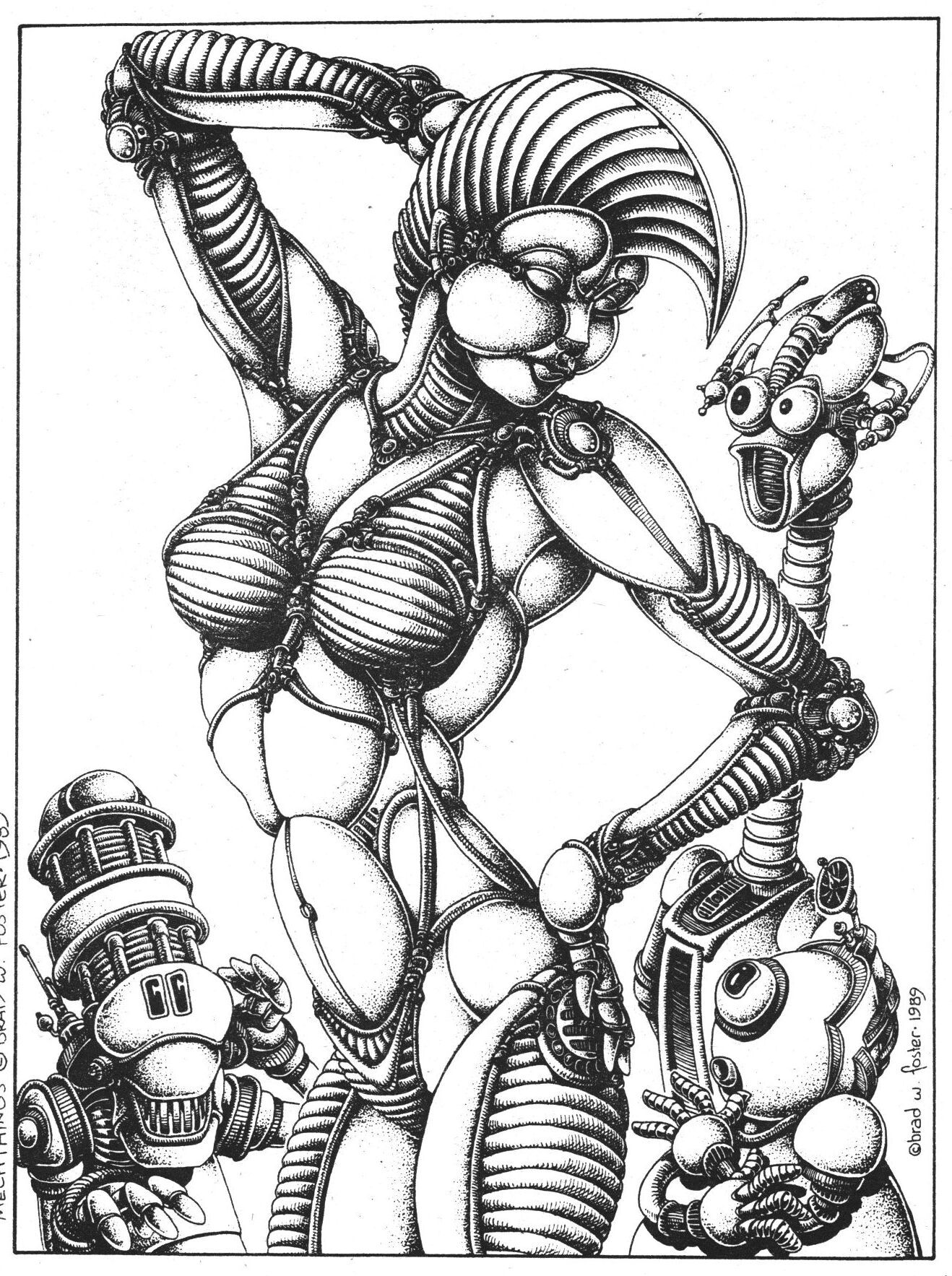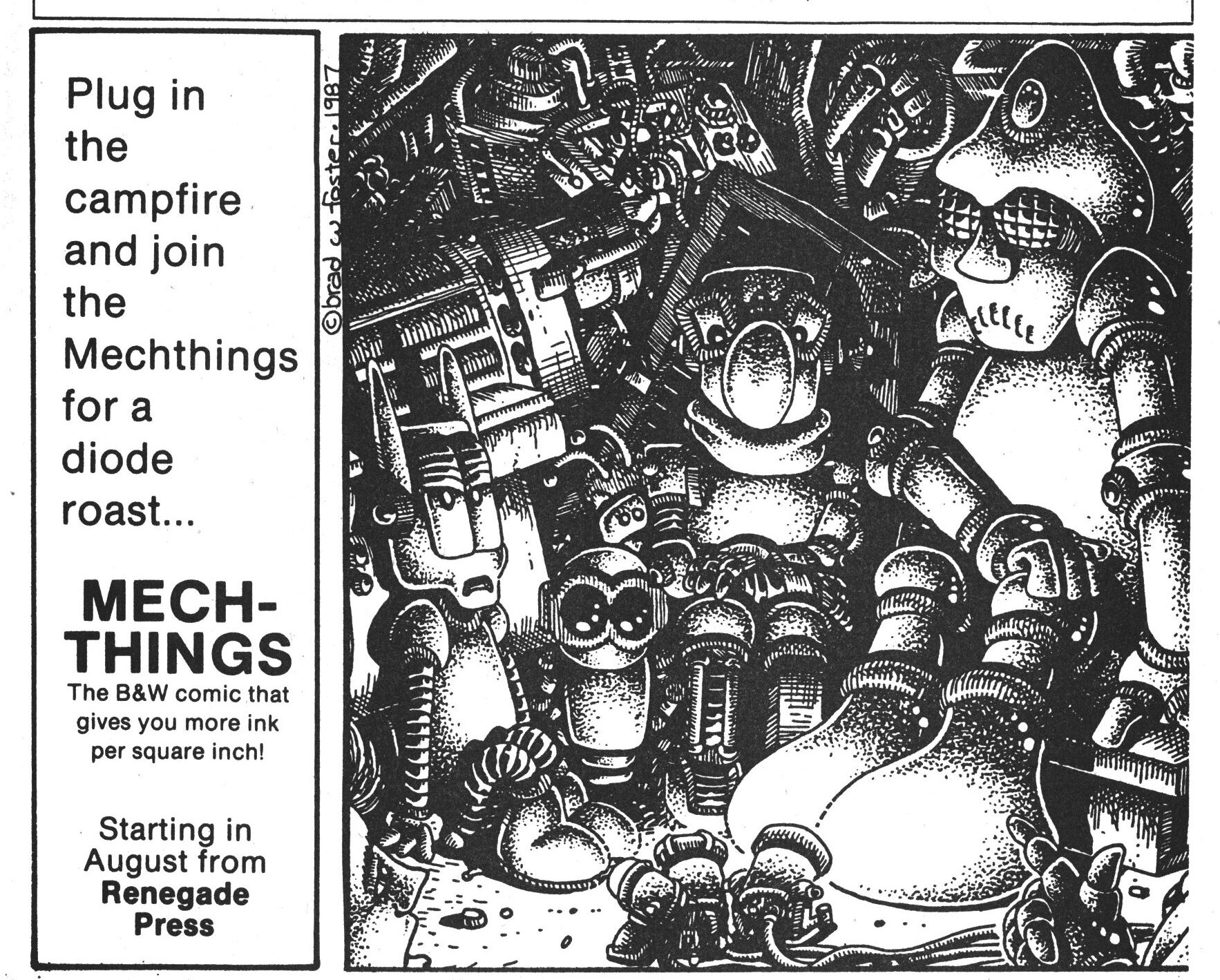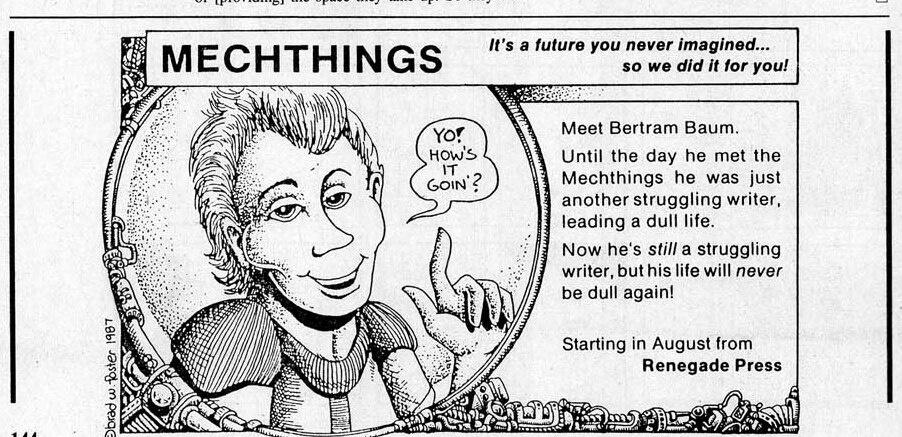Cerebus (1988) #112-138 by Dave Sim & Gerhard
Hey, it’s been a while since this blog series covered a block of Cerebus issues, and that’s because the bulk of the Renegade publications happened while Church & State (vol 2) was rolling. (And there’s only a handful more Renegade series to do after this post.)
But let’s set the scene: The previous Cerebus epic ended as all previous Cerebus stories (of any complexity): With a Deus ex Machina arriving and resetting everything. So we first get a double issue before the Jaka’s Story bit, showing where Cerebus is now, and it’s aptly titled “Square One”:
So Cerebus is wandering around, wistfully thinking about what’s been happening… and the artwork is better than ever, eh? Gerhard is really perfecting his backgrounds now: All wood grain and brick and glass and stuff.
We handily have a guy to remind us that the previous arc ended with the Cirinists swooping in with their much larger army and occupying Iest.
Eric Reynolds? Is that the same Eric Reynolds that’s now the Fantagraphics co-publisher? “Land of Ooh’s and Ah’s” (sic)? It’s a difficult term to google, and I’m not sure that’s how that phrase should be spelled, anyway…
It’s very polite! I wonder what it’s about. Is this about that spat Sim had with the distributors? Where he wouldn’t sell the paperback reprints through the comics stores?
Sim introduces Jaka’s Story by agreeing with Deni’s note (he was her husband at the time) in Cerebus #6 that the issue with Jaka was a wedding present to her. But the story was really about this other woman who was his “mistress” at the time, and that’s who Jaka was based on.
That sounds kinda like something a total sociopath would do, but I’m sure he meant well.
“She embodies those qualities I always looks for in a woman.” Because she has a very simple way of thinking.
That, on the other hand…
Anyway, Jaka’s Story finally gives rabid Cerebus fans what they’ve been asking for ever since Cerebus fell in love with her in issue #6: Jaka!
… and she’s married to the dopiest guy imaginable. I think it’s possible Sim was going for a self portrait here, sort of: A version of himself where he has no drive for success at all, but instead is just smoking dope, hanging out with Jaka and … well, nothing much else, really. A “there but for the grace of etc go I” kind of thing. But Sim overshoots “dopiest guy” and lands at “possibly developmentally challenged”, because he’s … he’s… He’s kinda downright just unbelievably stopid, ain’t he?
Jaka’s Story is a wonderful reading experience (well, until it starts to unravel). We have several “modes” — the normal comics bits, the story about Jaka’s childhood, and above we have the internal monologue of the extremely cleverly named “Pud Withers”, bar owner. His thoughts revolve around one thing only: Rehearsing what he’s going to say to Jaka. (It’s not clear that that’s what this is immediately, but it’s made clear later in this issue, which is also a nice touch.)
BIG REUNION SCENE. Thousands of Cerebus fans rejoice!
Poor Pud.
An also: Cerebus just happens to wander into the tavern where Jaka works. Sim doesn’t really care too much about setting things up to happen for, like, reasons — if Cerebus hadn’t walked into this tavern, the story wouldn’t happen, so Cerebus walks into the tavern.
Sim really enjoys telling anecdotes about him doing clever things (everybody’s always very impressed with him in his stories). Is this the only story where he’s bested by someone?
I do find it kind of amazing that he manages to make even this anecdote kinda grating: You know that he still thinks he had An Important Point To Make in this argument with his girlfriend.
I don’t quite recall what the circulation was at its highest — but it certainly was a lot more than this.
The Creators’ Summit! Very stylish. Much testosterone.
And here’s the result: The Bill of Rights. Is that kinda anaemic or what? It’s not exactly the Rozz-Tox Manifesto, is it…
On the other hand, you can’t argue with that stache.
Oh, yeah, I mentioned that one of the modes here was a story about Jaka’s childhood, and it’s done this way: Illustration and blocks of text. It’s not made clear until about halfway through that what we’re reading isn’t “the truth”: The provenance is, apparently, that Jaka (who left home at 12) has told her husband about her childhood (but it’s a child’s recollection of things, so that’s already pretty dubious). Her husband (who’ve we’ve already established is a complete moron) has then told his friend, Oscar, about these things. Oscar has then written this as a serial to be published in the magazine (“reads”) market.
But reading these issues for the first time (in 1988), none of that’s known at all, and we’re reading this as if the omniscient narrator is all-knowing, and it’s therefore true (or “True”, as Sim might say).
It’s an interesting edifice.
Also notable is that Sim is a lousy prose writer. I know he’s trying to emulate (or parody) Oscar Wilde here, but Wilde is a lot funnier.
I’ve read Jaka’s Story several times, and I usually skip over these bits, because they’re… not that good? I did re-read them this time, and … I found they weren’t as horrifyingly dreadful as I remembered. I hope this holds true for the text pieces in the rest of Cerebus, too, because I remember them as being total dreck.
Unused splash page by Gerhard. Hm…
Heh. Ng Suat Tong? He later became a big shot (heh heh) comics critic, and apparently Sim is saying that everything he’s saying here is true. Or something.
I probably should mention that Jaka’s Story is really funny — it’s got a whole bunch of really good gags going.
It’s also something of a cop-out. We know what Cerebus’ personality is like, but in Jaka’s Story he’s basically totally passive. And with more patience than anybody ever. That’s not Cerebus; but Sim wanted to do this story, so that’s what Cerebus is for the duration of these mumble number of issues.
For a while, people used to recommend reading Jaka’s Story “if you’re only going to read one”, because it’s a chamber piece with a handful of characters. But… I don’t really think so? Because the only reason it’s interesting to read about these characters is in the context of all the mysteries and plot threads established elsewhere in the series.
Derek McCulluch writes in to ask for, nay, demand payment for Sim reprinting his letters in the Cerebus reprint series.
And finally, we have the final participant in Jaka’s Story: The Oscar Wilde character. He provides most of the laughs and all of the bon mots. (Or, as Sim would probably write it, “bons mots”.)
Hey, what happened to Karen McKiel, the previous “administrative assistant” (read: publisher)?
Gary Groth interviews Sim in The Comics Journal #130, page 115:
GROTH•. DO vou lhink that Aardvaark-Vanaheim would
be a good example of streamlined bureaucracy of ef-
ficiency and simplicity?
SIM: I would have up until a little while ago, after I fired
Karen McKiel after she was discovered stealing money
from the company.
GROH-I: Oh. Jesus!
SIM: I was going too much on the assumption that I could
trust somebody in that business position, largely because
I assume that everyone has my attitude towards money,
which is that it’s useful but it’s a tiger you get by the tail.
There are a lot Of different elements to money that really
don’t appeal to me. Most people really can’t see anything
Wrong with money; the more Of it they can get the better
seems to be the prevailing viewpoint.
GROTH: You don’t necessårily disagree with that, do
you ?
SIM: Yes. I’ve found that beyond a certain point money
in inherently destructive of character. Returning to the
structural question. what we’ve got now is an administrator
who is handling the business side, but without the com-
signing privileges, company credit
cards — that Karen had. and is essentially doing basic
secretarial work. It’s not a business administrator any-
more. I’ve moved Gerhard from being strictly on the
creative side up to vice-president because. obviously. we
need all the creative people against the business forces
that we can get. He has a supervisory capacity over the
administrative assistant right now. Before, it was like the
art was over here and the business was over there: now,
it’s definitely the art is up here and the business is down
here underneath it. I don’t know if all self-publishers
would have to treat whoever the business entity in their
environment is strictly as an employee. That’s been my
experience. I don’t know. There’s a very strange attitude
that business people get. Even people I interviewed to
replace Karen would come in with this very supercilious
attitude towards creativity. You could see that they were
looking around the studio thinking. “Oh, these people
make pictures all day, and I’ll be up here running the im-
portant side.” It’s very funny how they reveal themselves
in a few minutes without even really seeing that there’s
anything wrong with it. I’m interviewing one candidate,
asking her a few questions. and Gerhard’s stopped draw-
ing. and he’s turned around from the drawing board, and
he’s listening to this exchange. She turns around and says
to him. “Shouldn’t you be drawing?”
GROTH: flaughing/ Right!
SIM: So. Gerhard and I sort of look at each other and,
I hand her her resume and say —
“Fuck vou.”
SIM: “Very much’. Don’t call us, we’ll call you.” It’s the
attitude of, “Well, you’ll be One Of my employees. This
guy who’s interviewing me is my boss, but you’re obvious-
ly just an artist, and we want Our artists to be busy little
arusts.••
Anyway.
Did I mention that Jaka’s husband is unbelievably stupid? Sim is going for “sweet and naive”, but…
Apparently Zolastraya dumped Sim, and we then get these very dramatic Notes from the President. Perhaps his lectures about How Women Are weren’t as appreciated as he thought?
But these quotes from Oscar Wilde (and others) had already been running on the back covers.
Sim had occasionally been running back-up stories in Cerebus, but he now shifts to doing previews. So here we get a bit from From Hell (by Alan Moore and Eddie Campbell). It’s been a long while since I read that one… did I ever buy it in a collected edition? I think not? I just read it as it was published, and then went back and re-read the bits, I think, once it was done. Perhaps I should get a new edition…
BY EMACS! WHAT THE FUCK IS THIS!!! Campbell has made a colour edition? And it’s ugly as fuck?
Whyyy!
The original version was gorgeous. This looks like total amateur hour… like something dashed off on an Ipad…
OK, perhaps I won’t get a new edition anyway.
Sim stops printing the circulation numbers, so I’m guessing they got too depressing. Gotta keep up appearances.
I did find this bit somewhat jarring. Lord Julius (or a look-a-like probably) appears (by random, of course)… but that’s not the jarring bit: Oscar just seemed to full of himself to go all *gasp* at the sight of Lord Julius.
Sim announces that he’s buying a house (at age… 33? it suddenly occurred to him that a house is a nice thing to have?) so he’s gonna publish a bunch of expensive Jaka’s Story “graphic novels” at $50 a pop.
Alan Moore writes an introduction to the excerpt of Rick Veitch’s The One… and Sim has it typeset in the smallest font he could find.
Jaka’s Story is a fun read — it’s got all these little bits.
And this was a very moving scene that felt well-earned: Sim used a lot of time to set this up, and it really worked.
It was apparently popular to graffiti Cerebi all over the world (and then send a snap to Sim).
Remember the… previous Cerebus entry in this blog series? Yes, Sim stopped smoking pot, and told the world how much better he felt after stopping. So now he’s stopping again, and he (once again) has all this time and energy to spend on… stuff.
I liked this “getting dressed” montage scene — OK, it’s a bit of a romcom cliché, but still.
Sim had spent a long time setting up the milieu and the characters, and it totally looked like things were going in one way… and then the Cirinists show up and start killing people! In one way, this is very typical of Sim: He writes himself into corners and then drops the sky on the characters as the resolution, but in this case it feels more warranted; more planned. And as a result, it’s a total shock when this happens, and the emotional impact is substantial.
And also just how he does it over this page, with the perfect mixture of confusion and clarity.
*clap clap*
Sim has sworn off replying to letters on the letters pages — as an experiment, and he’s wondering whether this will encourage or discourage people from writing in. (Some may fear a snarky response from him.)
OK, by this point I’m starting to understand why I was so reluctant to read the “Oscar” text bits… They started off much better than I remembered, but the turgid over-writing is really taking over now. And Oscar’s version of Jaka’s childhood doesn’t really feel true, either — Jaka’s literally unbelievably passive in her first years, and then kinda… on the humourless side? Even for an eleven year old?
But this was the page I lost faith in this book. By amaaaazing coinkidink, Jaka lands in Cirinist prison right next to her childhood nurse.
I know you’re thinking “this has to be a Cirinist trap!”, but that’s also pretty hard to believe: Did they have the nurse on tap, and taught her to gaslight Jaka in a couple of hours?
No, it’s just Sim’s favourite — or should I say only — way to plot: Have things happen by coincidence, and then somehow convince the reader that these coincidental things are of epic significance. You can almost suspect that it’s because of this that Sim put his religion together the way he did: He’s a great believer in Significant Synchronicity (i.e., things coincidentally happening, as the rest of us would think about these things). But if you’re not a casual paranoiac, this just doesn’t work. Everything isn’t connected to everything else; there is no significance in throwing snake eyes three times in a row.
Instead it becomes… “this is the best you could come up with? Did you really stop smoking pot this time?”
My annoyance at this basic plot incompetence carries through and colours scenes that otherwise could have been powerful — we learn that the nurse wasn’t the monster Oscar’s version (possibly based on Jaka’s stories) would have us believe.
And for the love of Satan — these scenes with Thatcher, the biggest monster in comic book history are pitch perfect. The cadences are just out of the world. But the question is… “why?” Why on Earth would Thatcher (and the other Cirinists) put so much work into making Jaka see the error of her ways? It makes no sense: She’s the niece of their most powerful frenemy, and the research needed here to break Jaka would be substantial.
Why do they care?
But the point is, of course, that this was the way Sim devised to pull the wool from the readers’ eyes about Jaka and infodump some hard truths.
(Although I guess you could say that it’s in the interest of the Cirinists to gain leverage with Lord Julius, but… keeping Jaka’s husband doesn’t really achieve much.)
But this scene almost made me laugh out loud: Cerebus is back (after not being seen at all for a number of issues)! And he brought milk!
So things end as usual for Cerebus — back to square one, and without him being involved.
We then get a couple of epilogue issues, mostly with Lord Julius antics, and they’re pretty amusing.
Sim increases the number of pages to 40 and prints a huge number of letters (and prints more previews). He did this at the same time he increased the cover price…
Having one “false” heavy ending, and then something funny, and then doing the “real” ending, even heavier, is a tried and true method. It fell flat for me, because the manipulation was just too obvious. Sim is going for “boo hoo” here, but instead it just gets an eye roll for me.
And I’m easily touched, believe me.
So: The first two thirds are really fun to read — Sim is a really strong storyteller on a scene to scene basis. Then the book absolutely fails in the third, dramatic act. Because Sim can’t plot himself out of a wet paper bag.
Keith R.A. DeCandido writes in The Comics Journal #134, page 41:
[…]
But what, I thought, could he do
centering an installment around what
I saw as a dull character?
Well, for one thing, she’s not a dull
character. Sim no longer uses her
presence as an excuse to sink the
dialogue into something out of a bad
soap opera. First of all, by seeing her
life story, we witness the terrible
restraint placed on this child of the
aristocraø—Jaka is the niece of Lord
Julius, richest spud in all Palnu, and
she is his sole heir. She has a nurse
who provokes such fear that we do not
see her face (the narrative is third per-
son central, from her perspective, and
all of the art is colored by her percep-
tions). It is a more serious treatment
of the opening of the movie Coming
to Amenca, in which Eddie Murphy’s
prince yearns to tie his own shoelaces
and wipe his own backside. Any at-
tempt she makes to do something
remotely enjoyable is met with stern
disapproval by the nurse, and the one
time she manages to start something
fun, the nurse turns up, spoils her con-
centration, and she hits her head. Her
imagination is fervid, inversely pro-
portional to the restraint placed on her
(though it suffers a setback after hit-
ting her head). This goes even further
the boring and monotonous line,
as this is one person in a room
(rooms), thinking. Lord Julius
himself, h’ the way, has not turned up
in the flashback; I hope he does, on-
ly to see him through Jaka’s percep-
tion, which might prove fascinating.
The other story (I almost called it
the “main” story, but that would im-
ply an importance that doesn’t exist
—this is two stories presented
simultaneously, both centering on Jaka
in different stages of her life) employs
a common enough literary device, thpt
of the microcosm. The world as seen
through a small number of isolated
Of the five, four are men, and
the woman is attractive, so naturally
three of them have the hots for her.
Cerebus has stated his love for Jaka
a number of times in the past, Rick
married her for a similar reason, and
Withers ogles her silently. Contrived,
yes, but Sim makes it humorous
enough that you don’t take it so
seriously. Withers says little, most of
it repetitive, but Sim lets us into his
character by revealing what goes on
in his head as he stands staring out the
window (his primary occupation), to
wit, fantasized conversations with
Jaka. It is all based on truth—their
typical greeting, for example (“I’m
fine and fit, Missus, fit and fine”)—
but he adds embellishments. Jaka ac-
tually comes to him in his musings
(“Oh, Pud… Hold me, Pud, hold me
hold me hold me.. and only in his
mind does he have the courage to ask
the great unanswered question bet-
ween the tuo of them: “Why is it, tint
I call ‘Miss Jaka’ [sic] in the evening
[when she comes grocery-Shopping]?
And why is it you call me ‘Pud’ in the
evening and ‘Mr Withers’ during the
day?” However, his self-control only
withers (sorry, couldn’t resist) twice:
when Cerebus pays for an ale costing
two bits with a gold piece, and when
Jaka wears a particularly revealing
outfit that makes the poor man trem-
ble and sweat with desire.
Cerebus himself has little to do or
say. Excepting his lengthy speech to
Jaka in #118 (or should that be #5?),
his dialogue has been at a minimum.
The earth pig has changed from the
master strategist/barbarian/strongman
he “as in the first 25 issues to a rather
simple character. Simple in that he
refuses to allow anything complex to
intrude on his life—everything is in
absolutes. When he has power, first
as prime minister in “High Society,”
then as pope in “Church and State,”
his sole desire is conquest and money.
He tries to remove himself from the
backdoor machinations, and when he
was drawn into something com-
plicated, Astoria’s trial, he ran away
at the first opportunity (even indulg-
ing in a Pontius Pilatesque hand-
washing in #100). Both his attempts
at conquest and money were un-
mitigated disasters, as both “Society”
and “State” ended with Cerebus pretty
much wiped out, left only with his
vest, sword, and medallions. In
“Jaka’s Story” he attempts to drive
Rick away with macho posturing
(menacing stance, fists clenched,
“Listen, kid, Cerebus is in love with
your wiß’), to no avail—Rick just
smiles and says, “I know, she’s great,
isn’t she?”
Heidi MacDonald writes in Amazing Heroes #157, page 43:
Sim reports that we uon•t see Cerebus
reliving Napoleon’s experiences on Elba.
“It [Cerebus’s days as Pope] was just one
of those things that happened [to him].
It was painfully apparent that it was not
going to affect him in any way. It’s
transformed everything else, very much
like Reagan. The m»or old codger
went all the way through what he did,
having not a clue what effect it was
having and just [thinking) he was having
his own way, and it’s changed the shape
of everything. I don’t think it really
touched on him aside from feeling a little
hurt there for a while when everybody
was calling him names, during the Iran-
Contra thing. Everything seems to have
ended okay, George is • going to be
president and that’s really all he was
there for in the first place.”
Only the Poet alludes to what took
place, “but he’s going to be very discreet
about it. He definitely knows who
Cerebus is, and he actually wins Cerbus
over. Cerebus really likes him and when
you first see the character you think this
is somebody Cerebus is going to cut
in half before they’ve had three
words to each other but this is the
last in charming. [The
Poet] has the dialect where
Cerebus comes from, talks
about Cerebus•s homeland,
and tells rude jokes about the
mayor, which Cerebus just
loves.”
It’s always amusing when people make Sim talk about a storyline before he’s written it — it’s always quite different, and Sim’s posture afterwards is always that he always meant for the story to be the way it turned out.
Tie Poet is a very important character,
sort of an early Angeleno scenester: “He
tells all the stories of intrigue and what’s
going on in the upper city and society
and what not, because that’s mainly what
he’s into, he is really less into what he’s
writing than he is in just rubbing elbows.
But he’s also a splendid conversationalist
so [he can’t be an AngelenoJ.”
In short, the story will focus on the
very human elements of the vuvtagonists,
and not so much the larger mysteries and
revelations of the series. “This is a real
self-contained story. It starts, [it has a]
middle, and it ends and it’s over, and I
think it’s going to have a very interesting,
valid point, and upset a lot of people, and
depress a lot of people, and cheer a lot
of other people up, just as ‘Church &
State’ did.”
For the time being, Sim and Gerhard
are relatively at peace with the world,
undistracted by the kinds of battles that
made headlines in the past. Sim says he’s
on good terms with all the distributors
right now and can settle into a comfort-
ably workaholic mode. “It’s been real
interesting doing this. Like, I can’t figure
out the news and I can’t figure out any-
thing else—what’s going on with the
money supply or anything, but every day
Gerhard and I go in and we know what
we’re doing and we go back to the world
where you don’t know what you’re
doing.”
Looking ahead, the next novel will be
more revelational. “We already knmv the
other aardvark is Cirin, but that’s the
next big novel,” which will be called
either ‘”Down and Out in lest and
Bedouin’ or ‘Mothers & Daughters.’
That’ll be about the size of ‘Church &
State,’ and be all about Cirinists and
Kevilists and finishes in #200. Then we
have one or two empty novels that have
yet to be filled, and then final chapters.”
That’s the next 16 years. Sim is asked
what he’ll do after #300. “Start a political
party in Canada. The aardvark party.”
Tom Spurgeon interviews Sim in The Comics Journal #184, page 95:
SPURGEON: It Seems that as you moved into Jaka’s Story,
there was a big change in terms of mood and narrative
voice.
SIM: Going back to the seminal point again, where you say,
‘Okay, I am startipg a new book. What’s going to be
mixed into this equatiQn, what’s going to be taken out,
what am I wanting to emphasize?” And really, the only
kind of book coming out at the time that I saw as having
the tone I wanted Jaka’s Story to have was and
Rockets — me looking at Love and Rockets, and saying
“This is not really my kind of thing. But I’d really like to
try this kind of thing.” Like, “If I was to do this kind of
thing, whatkind of thing would I do?” And that was pretty
close to the seminal point. “Yeah. Ido want to do a human
drama story. I do want to do a very limited cast. And no
extraneous characters coming in for the most part. And
just this rising tension in this very closed environment,just
watching these people under a microscope.”
Jason Sacks interviews Sim in Amazing Heroes #201, page 30:
AR: One of the most interesting things
to me when I was rereading ‘ ‘Jaka ‘s
Story ‘ ‘ was how realistic the married
couple are.
SIM: Most portrayals of marriage are
very one dimensional—like this is the
abusive husband and this is the noble,
long-suffering wife. Marriage is far
more interesting than its portrayal,
nine times out of ten. So I basically
tried to show that marriage brings out
the best in people and the worst in
people. That was just one of the
elements of “Jaka’s Story.”
The novel wasn’t just about mar-
riage but about love. Love is both a
horrible and wonderful thing. It’s
usually both simultaneously. Every-
body in the story is in love with
somebody and it doesn’t make them
happy.
AH: It ‘s interesting that the relation-
ship between Cerebus and Jaka has
evolved so much through the entire se-
ries. As the relationship has evolved,
their interaction has gotten much more
mature.
SIN: In a way. I’m one of those peo-
ple who doesn’t think that’s what hap-
pens with love. Maturity tends to
mean change, and there’s very little
change in love if it’s working properly.
AH: An evolution maybe?
SIM: Evolution would be better.
Maturity tends to imply it’s getting
better. I’ve found that most of the time
love doesn’t get better; it’s at its best
at the beginning and it goes downhill
from there.
AH: You sound like a man who’s
divorced.
SIM: I’ve been divorced, but I’ve also
started relationships: You still feel the
same. It’s not that you ever go in
thinking, “Well, this is going to go
bad.” We always stay optimistic
which is a lot of times very unhealthy
because you’re not keeping a realistic
eye on it. Most people who are mar-
ried, if you ask them, 99% are hap-
pily married. But at the same time half
of them get divorced.
AH: That’s one of the nice things
about love, the fantasy in your mind
of how it makes you feel.
SIM: I was definitely trying to show
in “Jaka’s Story” that to consider love
an unqualified good thing—”all you
need is love”—is really naive, very
simplistic, and ultimately destructive.
Pud would consider himself to love
Jaka, but obviously that’s not very
healthy in either of their cases. Oscar
would consider that he loves Rick, and
that’s not especially healthy. Cerebus
loves Jaka, and that’s not healthy
either. I tried to portray the sides of
love that I don’t see portrayed because
it is so often done rhetorically.
Orson Welles said once that a hap-
py ending is dependent on ending a
story before it’s done. Almost every-
thing ends unhappily, but if you stop
the story at a happy point, then you
say it was a happy story.
Heidi MacDonald writes in Amazing Heroes #145, page 51:
The story opens soon after “Church
& State” and finds Cerebus trying to
explain what happened to him, “but
finding out that nobody really wants to
listen. At least for the beginning of ‘Jaka’s
Story,’ we’ll see Cerebus trying to realize
nobody’s interested, ndbody really re-
members the story the way it happened.
You have to remember that the tower
broke off and accelerated at the speed
of sound at the end of #102. Obviously
that’s what we saw, that’s what Cerebus
saw, but to everyone on the ground it was
like a clap of thunder and the tower
disappeared. Now Cerebus is trying to
say he went to the moon.”
The main characters at first are
Cerebus, Jaka, and her husband. Sim is
also planning an Oscar Wllde-like
character, who, in the grand tradition of
Norton, Ethel, and Lenny & Squiggy,
lives across the hall and comes by to
liven things up. “It’s a pretty grave story
except for him. It’s sort of like Love &
Rockets where nothing really happens,
everybody’s sort of [sitting around]
chatting, nothing really going especially
well, and nobody really being too opti-
mistic about the future. Very much like
Ronald Reagan’s America. But this off-
the-wall character will drop in like a
breath of fresh air, and when he’s gone
everything lapses back into a very
mundane level. He just has this very
excitable quality about him, sort of the
life of the party.”
As opposed to the minute-by-minute
time frame in “Church & State,” “Jaka’s
Story” will have a somewhat more
leisurely sense of time. “Small incidents
for 20. pages, and then a reasonably
lengthy gap of time where you see how
things have settled from what they were
talking about last issue. I’m toying with
the idea of having two or three major
cataclysmic events that are only alluded
to. They happen between issues and
change everything. And we sort of talk
about it, but there’s an overwhelming
sense that you’re missing the novel.”
Sim hasn’t quite settled on the exact
amount of time the story takes, Cerebus-
wise. “Probably there’ll be a larger gap
between books [butl I can’t picture it’s
going to be that many, it will just be by
contrast with ‘Church & State’ they’ll
seem that much longer. Cerebus is not
alive that much longer. He’s not that old
when issue 300 comes. So I cari’t have
that large a gap.”
Uhhh, does that mean Cerebus dies in
#300? “Oh yeahe”
“Jaka’s Story” is much like “Church
& State” in that Sim has the ending and
overall shape in mind, but little of the
development is in finished form. “l want
to write a novel. If I nail it down right
now, I’ll be doing a lot more of what I’m
doing right now. Doing the last issue of
‘Church & State’ is writing what I’ve had
for four years in my head, there’s. [not
much to create]. The interesting thing is
that ‘Church & State’ started as a love
story, but ‘Jaka’s Story’ [turned out to bel
a love story.”
AH: That’s why I thought the ending
of “Jaka ‘s Story” was so devastating,
because you present a side of Rick
there that I had never expected to see.
SIM: I’m a believer that with most
people it’s just a matter of finding the
right buttons to push. I really struc-
tured the story in such a way that it
looks at the beginning like a cliched
love story.
Cerebus becomes a house guest and
is staying with them even though he’s
obviously still in love with Jaka. If you
tie that in with the rocky road that
Jaka’s and Rick’s marriage is, the first
half of the novel reads like a traditional
love story. In fact, a female friend of
Gerhard’s was reading the first half of
the novel and her first comment was,
“I just want to know who gets the
girl.” But that’s not the story. I would
not bother to work for two years on
a storythat came down to “who gets
the girl,”
AH: That was what made it such a
shock when the Cirinists break down
Pud’s door. I felt like I Bus set up for
a mmantic triangle and then that hap-
pened. Looking back on the novel, I
feel like- I could have seen that
coming.
SIM: I prefer works of fiction that
have surprises to them. Many people
don’t like surprises in their fiction.
People buy Harlequin romances to
read the same story over and over.
I surprised myself with “Jaka’s
Story.” When I conceived the novel,
I had it structured around the in-
carceration, beginning with the
Cirinists breaking down the door. I
worked backwards from there, think-
I would not bother to for
two years on a stow that came
down to gets the girt”
ing I had to get people to care about
these characters. I wanted to show
them a certain amount of what Jaka
is like. I wanted to create a sym-
pathetic husband.
I wanted to create a realistic mar-
riage. I wanted Oscar Wilde to be in
there. I wanted a homosexual love in-
terest along with the heterosexual love
interests in the story. A year and three
months (later], when it came time to
break down the door, I didn’t want to
do it.
I was sitting there and thinking
“maybe Cerebus breaks in and saves
them all.” Come on Dave, I thought,
you’ve had this story written all of this
time and you want to bring in the big-
gest cliche going.
AH: That would’ve been a Hollywood
movie type of cliche.
SIM: At the same time I wanted to do
that scene, because I wanted the story
to keep going. I wanted to see how all
these people worked out their prob-
lems and whatnot. It was very funny
coming face to face with myself as a
writer going, “Please don’t.”
AH: That suggests that this world is
set in your mind.
SIM: You’ll hear this from just about
any writer who has created characters
that the public cares about; the
characters take on a life of their own.
You can have the best of intentions of
saying, “I want this scene to go like
this,” but if it’s not in Jaka’s character,
Jaka isn’t going to say it.
When Cerebus has Jaka fetched by
Bear in “Church and State” after his
marriage broke up, my original inten-
tion was to have him order Jaka to stay
and then to play off that. I realized that
even though Cerebus is incredibly
stupid, insensitive and boorish, he
wouldn’t do something like that. It
didn’t work until I put down some-
thing that Cerebus would do.
R. Fiore writes in The Comics Journal #138, page 39:
I guess I must have reviewed Cerebus for the
first time 10 years ago, and I do it again every
couple of years or so, and I always wind up say-
ing the same thing, which is, in essence, lose
the aardvark. Or, to be more specific, I’ve
always thought that Dave Sim’s belief that the
Cerebus character and the Cerebus world can
encompass everything he wants to say without
alienating the reader who doesn’t normally read
comics is mistaken. From his statements it’s
clear that he wants to be thought of as among
the most artistically ambitious cartoonists, and
it’s also clear that he thinks Journal reviewers
have taken a condescending view of him. I may
have given him that idea myself, but I don’t
mean to be. There are few cartoonists who have
more potential to cross wer to a mainstream au-
dience, with his skill at caricature; his uncan-
ny portrayals of characters from life, like Oscar
Wilde in Jaka ‘s Story, and his ability to surprise
even the longtime reader. I, for one, would have
been one of the last people in the world to guess
10 years ago that the central theme would be
feminist, and pretty radical feminism at that. I
should also emphasize that when I say that a
readership that’s not steeped in comics lore
“Ould have a hard time taking the Tragic History
of Cerebus the Aardvark seriously, I’m not
speaking as one of those readers. Perhaps
ABOVE: Has Cerebus become so sophisticated ‘hat
it no longer has room for its title character?
readers would be willing to accept Cerebus the
Aardvark the same way they accept Snoopy the
dog. But I tend to doubt it.
It’s a conclusion Sim may be coming to on
his own; in Jaka Story Cerebus is hardly there.
He is peripheral to the story at best, and neither
motivates nor performs any vital story action,
and it could be because he just didn’t fit. To
measure Sim’s growth one need only compare
this with the early Jaka stories; it’s a difference
between a mawkish schoolboy and a mature
writer. The prose sections are a questionable
element. Prose by cartoonists is a dicey thing
at best, and adopting such a self-consciously
baroque style makes it doubly dicey. Beyond
that, many of the prose scenes seemed to
cry out for cartoon treatment. Nevertheless,
Jaka’s Story is another step forward in Sim’s
artistic development, and yet, well, here we go
again. TO really understand what’s going on you
have to have read the 113 issues that went before.
Emest Hemingway was supposed to have thrown
his first novel into the sea; Sim makes it
necessary for a new reader to plow through his
tyro work in order to comprehend his mature
work. It makes his readership practically a
closed system.
The funny thing is, the way he’s set things
up nothing would be easier than to break away
from Cerebus. He wouldn’t even have to give
up the 300-issue pledge. He could leave the
Cerebus world for a 25-issue story and then go
back and do another Cerebus novel. Cartoonists
— and novelists, for that matter — do it all the
time. It would be a course fraught with finan-
Cial danger; sales for a series without a pre-sold
character could easily fall into the four-figure
range in this kind of market, and the Cerebus
readership could melt away in the meantime.
That readership might be a closed system, but
it’s a dependable one. Perhaps it would have to
wait for better days. More likely Sim will show
the artist’s traditional disdain for free advice and
go ahead with his 300 issues.
But one can at least take comfort in the fact
that when he finishes those he should still be
on the sunny side of 50, with formidable skills
and a need for new worlds to conquer. Those
of us who are already on the boat can enjoy him
in the meantime, but it might take until then for
the rest of the world to find out about it.
Bart Beaty writes in The Comics Journal #263, page 114:
Around the time of Jakds Story I began
to get the sense that not only was Cereous
the great comic novel that some of us had
been waiting for, but that it also might be
the great Canadian novel. And I meant
novel in the true sense Of the word. This
was a dense, sophisticated tale. The fact
that Sim poured so much text on to the
sides Of his pages certainly helped the
mental image. (The fact that so much of
that text was turgid and unreadable, utter-
ly and completely failing as a take on
Wilde didn’t help nearly as much.) The
reach here was remarkable, the attempt to
do something that had never been done
before was brave.
university. It seemed to me that I had
my whole life in front of me, and that
possibilities were limitless. It seemed
at the same time char the same could
be said of Cerebus. That future was so
bright. I don’t think that I’ve ever been
so optimistic about a comic since. It
was the highest Of highs.
There’s a bunch of reviews of the book on the intertubes:
There is comedy, but not as much as previous books, as a lot of the subject matter doesn’t lend itself well to humour. This book, unlike some of the others, can be read and followed without a great deal of background knowledge. All one has to know is that Cerebus and Jaka have history, and it’s really not that much history – actually little more than a couple of meetings. Ambitious, mature and challenging, this is one of the best of the series.
More:
Half the book focuses on the tensions of quiet domesticity, the dancer Jaka living with her new husband Rick halfway up a mountain next to a few other domiciles and a tavern. The other half is about freedom of artistic expression and a woman’s right to choose. But it’s not as straightforward as you might think.
This book is a milestone in written works. Fuck anybody who avoids this on the grounds of it’s illustrations, which continue to dazzle the eyes (thank you Gerhard).
Etc:
I’ll admit the happy flush of discovery may color my view, but I still love Jaka’s Story more than anything else Sim ever created, even if he’d likely loathe my reasons for doing so. Maybe he likes Jaka’s Story as much as I do, but I undoubtedly like Jaka far more than he does.
Etc:
This is a marvellous story, intertwining past and present; utilising enough literary genres to make any concept of pigeonholing a waste of time.
Everybody loves it.
This blog post is part of the Renegades and Aardvarks series.

